Table of Contents
- Contents
- Guide
- Connections
- Connection Guide
- Connecting an Antenna
- Connecting to the network
- Establishing a wired network connection
- Establishing a wireless network connection
- Checking the network connection status
- Resetting Your Network
- Turning on the TV with a mobile device
- Connecting an IP control device to the TV
- Allowing to connect a wireless network
- Allowing to connect the Wi-Fi Direct
- Changing the name of the TV
- Displaying your mobile device screen on the TV
- Connection Cables for External Devices
- Switching between external devices connected to the TV
- Connection Notes
- Remote Control and Peripherals
- About the Samsung Smart Remote (QLED TV/The Frame (43-inch or larger models)/The Serif/OLED TV)
- About the Samsung Smart Remote (The Frame (32LS03B model)/BU8 Series)
- About the Samsung Smart Remote (The Sero)
- Connecting the Samsung Smart Remote to the TV
- Controlling External Devices with a Samsung Remote Control - Using the Universal Remote
- Learn how to use Samsung Smart Remote
- Using Anynet+ (HDMI-CEC)
- Controlling the TV with a Keyboard, Mouse, or Gamepad
- Entering Text using the On-Screen Virtual Keyboard
- Smart Features
- TV Viewing and Recording
- Using the Guide
- Recording Programs
- Setting Up Schedule Viewing
- Using Timeshift
- Getting to know Recording and Timeshift controls and options
- Using the Channel List
- Using the channel edit function
- Using a Personal Favorites List
- TV-Viewing Support Functions
- Picture and Sound
- System and Support
- Using the Time Functions and the Timers
- Using the Power and Energy Saving Functions
- Using the Panel Care Functions
- Updating the TV's Software
- Using the Parental Settings function
- Audio and Video Functions for the Visually or Hearing Impaired
- Running the accessibility functions
- Running Accessibility Shortcuts
- Enabling voice guides for the visually impaired
- Changing the volume, speed, pitch, and the TV background volume of the Voice Guide
- The TV screen is turned off but audio continues
- Enlarge the screen
- Enabling audio for the audio (video) description function
- White text on black background (high contrast)
- Setting the screen to black and white
- Inverting the screen color
- Enlarging the font (for the visually impaired)
- Learning about the remote control (for the visually impaired)
- Learning about the TV menu
- Showing captions
- Splitting the caption
- Selecting the caption language
- Setting the digital caption related options
- Listening to the TV through Bluetooth devices (for the hearing impaired)
- Enlarging the sign language screen for the hearing impaired
- Configure Sign Language Guide options
- Configuring the repeat settings for remote control buttons
- App for the Visually Impaired (SeeColors App)
- Using Voice Assistants on the TV
- Using Other Functions
- Precautions and Notes
- Before Using the Recording and Timeshift Functions
- Read Before Using Apps
- Read Before Using the Internet Function
- Read Before Playing Photo, Video, or Music Files
- Limitations to the use of photo, video, and music files
- Supported subtitles
- Supported image formats and resolutions
- Supported music formats and codecs
- Supported video codecs (QLED TV except for Q6*B Series/The Frame (43-inch or larger models)/The Serif/The Sero/OLED TV)
- Supported video codecs (Q6*B Series)
- Supported video codecs (The Frame (32LS03B model)/BU8 Series)
- Supported video codecs (QN7**B Series)
- Supported video codecs (QN8**B Series or higher)
- Read After Installing the TV
- Supported Resolutions for UHD Input Signals
- Resolutions for Input Signals supported by 8K models (QN7**B series or higher)
- Supported Resolutions for FreeSync (VRR)
- Read Before Connecting a Computer (Supported Resolutions)
- Supported Resolutions for Video Signals
- Read Before Using Bluetooth Devices
- Blocking programs based on their TV Rating
- Licenses
- Connections
- Troubleshooting
- Picture Issues
- The screen is flashing or has become dark
- The picture is not bright, or the picture colors do not look clear
- The picture colors are black and white or do not look the way they should look
- The TV automatically turns off by itself
- TV (The Frame TV) cannot be turned off.
- Unable to power on
- The TV remains on or does not turn on automatically.
- Unable to find a Channel
- The TV image does not look as good as it did in the store
- Displayed video looks blurry
- The picture is distorted
- There is a dotted line on the edge of the screen
- The picture won’t display in full screen
- The Caption function in the TV menu is deactivated
- Captions appear on the TV screen
- The HDR of the connected external device turns off
- Sound and Noise Issues
- How can I connect an audio device to the TV?
- There is no sound or the sound is too low at maximum volume.
- The picture is good but there is no sound.
- HDMI (eARC) is connected, and there is no sound.
- The speakers are making an odd sound.
- The sound is interrupted.
- Whenever a function is used on the TV or the channel is changed, the TV voices the activity. The TV explains in voice-over the video scenes displayed on the screen.
- The TV audio is not being played through the Sound bar or A/V receiver.
- The sound is not heard clearly.
- The volume of the external device cannot be adjusted.
- I want to turn the TV and audio device off and on at the same time.
- Channel and Broadcast Issues
- External Device Connectivity Issues
- Network Issues
- Anynet+ (HDMI-CEC) Issues
- What is Anynet+?
- Anynet+ does not work. The connected device is not displayed.
- I want to start Anynet+. I also want the connected devices to turn on when the TV is turned on.
- I want to exit Anynet+. It is inconvenient to turn on other devices because the TV also turns on. It is inconvenient because the connected devices (e.g. set-top box) turn off together.
- The message "Connecting to Anynet+ device..." or "Disconnecting from Anynet+ device" appears on the screen.
- The Anynet+ device won't play.
- Remote Control Issues
- Recording Issues
- Apps
- Media Files
- Voice Assistant Issues
- The voice commands do not work well.
- Bixby/Alexa answers although I did not call it.
- I spoke "Hi, Bixby/Alexa" but Bixby/Alexa does not answer.
- Voice recognition does not work with the Samsung Smart Remote unlike other features. There is no response even if the Voice Assistant button is pressed.
- During voice recognition, the heavy load message appears and the function does not work.
- I want to see weather information of the desired area.
- Other issues
- The TV is hot.
- The TV smells like plastic.
- The settings are lost after 5 minutes or every time the TV is turned off.
- The TV is tilted to the side.
- The stand is wobbly or crooked.
- A POP (TV’s internal banner ad) appears on the screen.
- The TV is making a popping noise.
- The TV is making a humming noise.
- The TV narrates the screen events in voice-over.
- Diagnosing TV operational issues
- Getting Support
- Picture Issues
- FAQ
- Accessibility Guidance
Samsung QN55Q60BAFXZA User Manual
Displayed below is the user manual for QN55Q60BAFXZA by Samsung which is a product in the TVs category. This manual has pages.
Related Manuals

E-MANUAL
Thank you for purchasing this Samsung product.
To receive more complete service, please register your
product at
www.samsung.com
Model Serial No.
To directly go to the page that provides instructions on
how to use the manual for visually impaired users, select
the Learn the Menu Screen link below.
"Learn the Menu Screen" Link

Contents
Guide
Connections
7Connection Guide
8 Connecting an Antenna
9Connecting to the network
13 Displaying your mobile device screen on the TV
15 Connection Cables for External Devices
17 Switching between external devices connected to the TV
20 Connection Notes
Remote Control and Peripherals
23 About the Samsung Smart Remote (QLED TV/The Frame
(43-inch or larger models)/The Serif/OLED TV)
26 About the Samsung Smart Remote (The Frame (32LS03B
model)/BU8 Series)
29 About the Samsung Smart Remote (The Sero)
32 Connecting the Samsung Smart Remote to the TV
33 Controlling External Devices with a Samsung Remote
Control - Using the Universal Remote
33 Learn how to use Samsung Smart Remote
34 Using Anynet+ (HDMI-CEC)
35 Controlling the TV with a Keyboard, Mouse, or Gamepad
37 Entering Text using the On-Screen Virtual Keyboard
Smart Features
39 Using Smart Hub
44 Using Ambient Mode
50 Using Art Mode
57 About the Media Home Screen
60 About the Menu Home Screen
64 Using a Samsung account
66 Using PC on TV
72 Using the Apps Service
76 Using the e-Manual
78 Using the Internet
79 Using SmartThings
83 Playing pictures/video/music
89 Using Multi View
91 Using Bixby
96 Using the Game Bar
TV Viewing and Recording
101 Using the Guide
103 Recording Programs
106 Setting Up Schedule Viewing
107 Using Timeshift
107 Getting to know Recording and Timeshift controls and
options
109 Using the Channel List
110 Using the channel edit function
111 Using a Personal Favorites List
112 TV-Viewing Support Functions
Picture and Sound
115 Using Intelligent Mode
118 Adjusting the Picture Quality
121 Changing the Picture Size and Position
122 Setting the Viewing Environment for External Devices
125 a Sound Mode and Expert Settings
127 Using the Sound Support Functions
System and Support
129 Using the Time Functions and the Timers
132 Using the Power and Energy Saving Functions
134 Using the Panel Care Functions
135 Updating the TV's Software
136 Using the Parental Settings function
137 Audio and Video Functions for the Visually or Hearing
Impaired
142 Using Voice Assistants on the TV
143 Using Other Functions

Precautions and Notes
145 Before Using the Recording and Timeshift Functions
147 Read Before Using Apps
148 Read Before Using the Internet Function
150 Read Before Playing Photo, Video, or Music Files
162 Read After Installing the TV
163 Supported Resolutions for UHD Input Signals
164 Resolutions for Input Signals supported by 8K models
(QN7**B series or higher)
165 Supported Resolutions for FreeSync (VRR)
166 Read Before Connecting a Computer (Supported
Resolutions)
169 Supported Resolutions for Video Signals
171 Read Before Using Bluetooth Devices
172 Blocking programs based on their TV Rating
175 Licenses
Troubleshooting
Picture Issues
176 The screen is or has become dark
176 The picture is not bright, or the picture colors do not look
clear
177 The picture colors are black and white or do not look the
way they should look
178 The TV automatically turns off by itself
178 TV (The Frame TV) cannot be turned off.
178 Unable to power on
179 The TV remains on or does not turn on automatically.
179 Unable to a Channel
180 The TV image does not look as good as it did in the store
180 Displayed video looks blurry
180 The picture is distorted
180 There is a dotted line on the edge of the screen
181 The picture won’t display in full screen
181 The Caption function in the TV menu is deactivated
181 Captions appear on the TV screen
181 The HDR of the connected external device turns off
Sound and Noise Issues
182 How can I connect an audio device to the TV?
182 There is no sound or the sound is too low at maximum
volume.
182 The picture is good but there is no sound.
182 HDMI (eARC) is connected, and there is no sound.
183 The speakers are making an odd sound.
183 The sound is interrupted.
183 Whenever a function is used on the TV or the channel is
changed, the TV voices the activity. The TV explains in voice-
over the video scenes displayed on the screen.
183 The TV audio is not being played through the Sound bar or
A/V receiver.
184 The sound is not heard clearly.
184 The volume of the external device cannot be adjusted.
184 I want to turn the TV and audio device off and on at the
same time.

Channel and Broadcast Issues
185 "Weak or No Signal" displayed in TV mode or cannot
channel.
185 The TV is not receiving all channels.
185 The captions are not provided on a digital channel.
185 Broadcasting is deactivated.
External Device Connectivity Issues
186 The "Mode Not Supported" message appears.
186 The video is OK but there is no audio.
186 I want to connect to a PC and mobile device via screen
mirroring.
187 No screen appears when connecting the TV to an external
device.
187 I want to connect to a Bluetooth speaker.
187 The PC screen does not appear or it
Network Issues
188 Wireless network connection failed. Unable to connect to a
wireless access point. Unable to connect to the network.
188 Wired network connection failed.
188 Connected to a local network, but not to the Internet.
Anynet+ (HDMI-CEC) Issues
189 What is Anynet+?
189 Anynet+ does not work. The connected device is not
displayed.
190 I want to start Anynet+. I also want the connected devices to
turn on when the TV is turned on.
190 I want to exit Anynet+. It is inconvenient to turn on other
devices because the TV also turns on. It is inconvenient
because the connected devices (e.g. set-top box) turn off
together.
190 The message "Connecting to Anynet+ device..." or
"Disconnecting from Anynet+ device" appears on the screen.
190 The Anynet+ device won't play.
Remote Control Issues
191 The remote control does not work.
191 External devices cannot be operated with the TV remote
control.
Recording Issues
192 The Timeshift or recording function cannot be used.
192 Cannot record videos received from an external device or
Samsung TV Plus.
193 The "Format Device" message appears when the Timeshift
or recording function is used.
193 The recorded on the TV are not played back on a PC.
Apps
194 I launched an app, but it's in a different language. How can I
change the language?
194 The app does not work properly. Its image quality is poor.
194 The Smart Hub Home Screen keeps appearing whenever you
turn on the TV.
Media Files
195 Some are interrupted during playback.
195 Some can't be played.
Voice Assistant Issues
196 The voice commands do not work well.
196 Bixby/Alexa answers although I did not call it.
196 I spoke "Hi, Bixby/Alexa" but Bixby/Alexa does not answer.
197 Voice recognition does not work with the Samsung Smart
Remote unlike other features. There is no response even if
the Voice Assistant button is pressed.
197 During voice recognition, the heavy load message appears
and the function does not work.
197 I want to see weather information of the desired area.
Other issues
198 The TV is hot.
198 The TV smells like plastic.
198 The settings are lost after 5 minutes or every time the TV is
turned off.
198 The TV is tilted to the side.
198 The stand is wobbly or crooked.
199 A POP (TV’s internal banner ad) appears on the screen.
199 The TV is making a popping noise.
199 The TV is making a humming noise.
199 The TV narrates the screen events in voice-over.
Diagnosing TV operational issues

200 Self Diagnosis
201 Cannot select Signal Information in Self Diagnosis.
201 Reset Smart Hub
201 Reset picture
201 Reset sound
Getting Support
202 Getting support through Remote Management
202 Finding the contact information for service
202 Requesting service
FAQ
The TV Screen does not Display Properly
The TV does not Turn On
The Picture is Distorted, or No Sound Comes Out of the
Sound Bar
Network Access is not Available
There is No Sound or the Speakers are Making an Odd Sound
The Remote Control does not Work
Updating the Software

Guide
Learn how to use various features.
Connections
You can watch live broadcasts by connecting a coaxial cable to your TV and can get access to the network by using a
LAN cable or wireless access point. Using various connectors, you can also connect external devices.
Connection Guide
You can view detailed information about external devices that can be connected to the TV.
Menu Connected Devices Connection Guide Try Now
It shows you how to connect various external devices, such as video devices, game consoles, and PCs using pictures.
If you select the connection method and an external device, the connection details appear.
•Audio Device: HDMI (eARC), Optical, Bluetooth, Wi-Fi, Wi-Fi Speaker Surround Setup
•Video Device: HDMI
•Smartphone: Screen Sharing (Smart View), Screen Sharing (Tap View), Samsung DeX, SmartThings, Camera
Sharing, Apple AirPlay
•PC: HDMI, Screen Sharing (Wireless), Easy Connection to Screen, Apple AirPlay, NFC on TV
•Input Device: Remote Control, USB Keyboard, USB Mouse, USB Gamepad, USB Camera, Bluetooth Device
•Game Console: HDMI
- 7 -

•External Storage: USB Flash Drive, Hard Disk Drive (HDD)
The connection method and available external devices may differ depending on the model.
Some functions may not be supported depending on the model or geographical area.
Using HDMI Troubleshooting, you can check the connection to HDMI cable and external devices (takes approximately 2
minutes).
Connection Guide
Audio Device
Video Device
Smartphone
PC
Input Device
Game Console
External Storage
HDMI (eARC)
Optical
Bluetooth
Wi-Fi
Wi-Fi Speaker Surround Setup
HDMI Troubleshooting
Connect audio devices, such as speakers, sound bars,
headphones, or home theaters, to TV.
The image on your TV may differ from the image above depending on the model and geographical area.
Connecting an Antenna
You can connect a coaxial cable to your TV.
An antenna connection is not necessary if you connect a cable box or satellite box.
The port on your TV may differ from the following depending on the product model and region.
- 8 -

Connecting to the network
You can get access to the network through your TV.
Menu Settings All Settings Connection Network Open Network Settings
Try Now
network settings to connect to an available network.
Establishing a wired network connection
Menu Settings All Settings Connection Network Open Network Settings
Wired
If you connect a LAN cable, the TV automatically accesses the network.
If the TV does not automatically connect to the network, refer to "Wired network connection failed." in "Troubleshooting."
To connect a LAN cable, use a CAT 7 (*STP type) cable for the connection. (100/10 Mbps)
* Shielded Twisted Pair
The TV will not be able to connect to the network if your network speed is below 10 Mbps.
This function may not be supported depending on the model.
Wired networks are not supported by some models.
- 9 -

Establishing a wireless network connection
Menu Settings All Settings Connection Network Open Network Settings
Wireless
Make sure that you have the wireless access point's name (SSID) and password settings before attempting to
connect. The network name (SSID) and security key are available on the wireless access point's
screen. See the wireless access point's user manual for more information.
- 10 -

Wireless Connection
Select your Wi-Fi network.
Refresh
Manage Saved Networks
The image on your TV may differ from the image above depending on the model and geographical area.
If no wireless access point is found, select Add Network at the bottom of the list and enter the network name (SSID).
If your wireless access point has a WPS or PBC button, select Use WPS at the bottom of the list, and then push the WPS or
PBC button on your access point within 2 minutes. The TV will connect automatically.
To view or delete previously connected network names (SSIDs), move the focus to Manage Saved Networks, and then press
the Select button.
To disconnect Wi-Fi, select Disconnect in Menu Settings All Settings Connection Network
Network Status. Try Now
Checking the network connection status
Menu Settings All Settings Connection Network Network Status Try Now
View the current network status.
Resetting Your Network
Menu Settings All Settings Connection Network Reset Network Try Now
Restore the network settings to the factory default.
- 11 -

Turning on the TV with a mobile device
Menu Settings All Settings Connection Network Expert Settings Power On
with Mobile Try Now
You can turn on the TV using a mobile device connected to the same network as the TV.
This function is available with a mobile device connected to the TV through the SmartThings app or the Apple AirPlay
function.
Apple AirPlay may not be supported depending on the model or geographical area.
Connecting an IP control device to the TV
Menu Settings All Settings Connection Network Expert Settings IP Remote
Try Now
You can connect an IP control device to the TV remotely to manage your IP device.
To use this function, Power On with Mobile must be turned on.
Turning this feature on may allow other IP control devices to control your TV. We recommend turning this feature on only
if an authorized third-party custom controller is installed and for a Samsung TV and if your Wi-Fi
network is password protected.
This function may not be supported depending on the model.
Allowing to connect a wireless network
Menu Settings All Settings Connection Network Expert Settings Wi-Fi
Try Now
You can enable the connection to Wi-Fi.
To connect a wireless network, the function must be active.
Allowing to connect the Wi-Fi Direct
Menu Settings All Settings Connection Network Expert Settings Wi-Fi
Direct
When using Wi-Fi Direct, you can connect directly with other devices and share content without using a wireless
router.
To maximize the network performance when a 6 GHz access point is connected, turn off the Wi-Fi Direct function.
This function may not be supported depending on the model.
Changing the name of the TV
Menu Settings All Settings Connection Device Name Try Now
You can change the name of the TV on the network. Select User Input at the bottom of the list and change the
name.
- 12 -

Displaying your mobile device screen on the TV
You can watch the screen of your mobile device on the TV screen through Smart View, Apple AirPlay or Tap View.
When you start screen sharing with a mobile device (Smart View / Apple AirPlay / Tap View), the TV screen switches
to the Multi View or mobile device's screen. Watch multiple contents at the same time with the Multi View screen.
This function may not be supported depending on the model.
For more information, refer to "Using Multi View."
Using Screen Sharing (Smart View)
For information on how to share the screen with your mobile device, refer to Menu Connected
Devices Connection Guide Smartphone Screen Sharing (Smart View). Try Now
• To turn off Screen Sharing (Smart View), disconnect the mobile device or press the button on the remote
control.
• Using the Smart View menu on your mobile device, you can change the settings such as aspect ratio.
Using Apple AirPlay
Use AirPlay if you are an iPhone or iPad user. For more information, refer to Menu Connected Devices
Connection Guide Smartphone Apple AirPlay. Try Now
This function may not be supported depending on the model or geographical area.
To use Apple AirPlay, make sure Menu Settings All Settings Connection Apple AirPlay Settings is
enabled.
- 13 -

Using Screen Sharing (Tap View)
By tapping the mobile device on your TV, you can watch Multi View or mobile device's screen through the TV screen.
When you tap a mobile device on your TV while running a music app on your mobile device, the TV screen switches
to the Music Wall screen.
1.
Enable Tap View on your mobile device.
For more information about refer to 'Enabling Tap View'.
2.
Turn on the screen of your mobile device.
3.
Tap your mobile device on the TV. The TV screen switches to Multi View, Music Wall, or mobile device's screen.
When you perform Tap View in Ambient Mode feature or Art mode (only in The Frame models), only the mobile
device's screen appears on the TV.
4.
Watch Multi View, Music Wall, or mobile device's screen on the TV screen.
This function may not be supported depending on the model.
This function is available in Samsung mobile devices with Android 8.1 or higher.
Music Wall screen is a function that allows you to enjoy music along with visual video effects that change according to the
genre and beat of the music.
The displayed TV screen may differ depending on the model.
This function enables Screen/Sound Mirroring by detecting vibrations generated when you tap the mobile device on the TV.
Be sure to tap away from the TV screen and bezel corners. It may scratch or break the TV or mobile device screen.
We recommend using your mobile device with the cover in place and lightly tap it on any external edge of the TV.
Enabling Tap View
Enable Tap View in the SmartThings app.
Depending on the SmartThings app version, you may need to register the TV with your mobile device.
This function may not be supported depending on the model.
1.
Launch the SmartThings app on your mobile device.
2.
Select Settings ( ) in SmartThings app on your mobile device.
3.
Set Tap View to on.
Upon connection for the time, select Allow on a pop-up window of the TV.
- 14 -

Connection Cables for External Devices
You can view detailed information about the connection cables for external devices that can be connected to the TV.
Cable name Image Description
HDMI
to
HDMI
Each cable simultaneously transmits digital video and audio signals
from an external device to the HDMI port on the TV.
Cables are divided into various types according to the types of input
or output ports on external devices.
HDMI
to
MINI HDMI
HDMI
to
Micro HDMI
HDMI
to
USB Type-C
HDMI
to
DisplayPort
Mini DisplayPort
to
HDMI
- 15 -

Cable name Image Description
DVI
to
HDMI
DVI to HDMI cables can transmit only digital video signals and not
audio signals. We recommend that you use HDMI to HDMI cables.
Optical
Optical cables are used to transmit audio signals to external
speakers with low signal loss.
Optical cables can't transmit video signals.
Component
Component cables transmit analogue signals.
The video signal is separated and transmitted to the red, green, and
blue terminals to provide HD (1080i) pictures. The audio signal is
transmitted to the red and white terminals.
Composite
Composite cables transmit analogue signals.
The video signal is transmitted to the yellow terminal, and the audio
signal is transmitted to the red and white terminals.
Available connection cables may differ depending on the model or geographical area.
- 16 -

Switching between external devices connected to the TV
You can switch between TV programs and the content of external devices.
Menu Connected Devices
When you select a connected external device on the Source screen, the output of the selected device is displayed on
the TV's screen.
To control a device (Blu-ray player, game console, etc.) that supports universal remote control with the TV's remote control,
connect the device to an HDMI port on the TV, and then turn on the device. The output displayed on the TV is automatically
switched to the output of the device or you can universal remote control for the device automatically. For more
information, refer to "Controlling External Devices with a Samsung Remote Control - Using the Universal Remote."
When a USB device is connected to the USB port, a pop-up message appears that lets you switch easily to the media
content listed on the device.
This function may not be supported depending on the device and geographical area.
Editing the name and icon of an external device
Menu Connected Devices
You can change the port name for a connected external device or add it to the Home Screen.
Universal Remote
Edit
Information
Add to Home
Connected Devices
The image on your TV may differ from the image above depending on the model and geographical area.
1.
Move the focus to a connected external device.
2.
Press the down directional button. The following functions become available:
Available functions may differ depending on the port type.
- 17 -

1.Universal Remote
You can control external devices connected to the TV using a Samsung remote control. Run the Universal Remote
menu to register the external device.
This function may not be supported depending on the model or geographical area.
For more information, refer to "Controlling External Devices with a Samsung Remote Control - Using the Universal
Remote."
2.Edit
You can rename the input ports and change the device icons.
3.Information
You can view detailed information about an external device.
4.Add to Home
You can add the port of an external device to the Home Screen for quick switching.
- 18 -

Using additional functions
You can use the following features on the Source screen.
•USB and Mobile Camera
Connect a USB camera, or use the SmartThings app on your mobile phone to connect a camera.
Connect a camera to use video call, home workout, and other new features.
For details on how to connect, refer to Camera Sharing ( Menu Connected Devices Connection Guide
Smartphone Camera Sharing).
This function may not be supported depending on the model.
•PC on TV
Use the TV to access your PC via remote PC or Screen Sharing (Wireless).
For more information, refer to "Using PC on TV."
•Connection Guide
Displays device connection instructions.
For more information, refer to "Connection Guide."
•Universal Remote
Lets you register external devices to your Samsung remote control and control them using the Remote.
This function may not be supported depending on the model or geographical area.
For more information, refer to "Controlling External Devices with a Samsung Remote Control - Using the Universal
Remote."
- 19 -

Connection Notes
When connecting an external device, note the following:
The number of connectors, and their names and locations may differ with the model.
Refer to the external device's operating manual when connecting it to the TV. The number of external device connectors,
and their names and locations may differ with the manufacturer.
Connection notes for HDMI
• The following types of HDMI cables are recommended:
– High Speed HDMI Cable
– High Speed HDMI Cable with Ethernet
– Premium High Speed HDMI Cable
– Premium High Speed HDMI Cable with Ethernet
– Ultra High Speed HDMI Cable
• Use an HDMI cable with a thickness of 0.66 inches (17 mm) or less.
• Using a non-certified HDMI cable may result a blank screen or a connection error.
• Some HDMI cables and devices may not be compatible with the TV due to different HDMI specifications.
• This TV does not support HDMI Ethernet Channel. Ethernet is a Local Area Network (LAN) built with coaxial
cables standardized by the IEEE.
• Use a cable shorter than 10 feet (3 m) to get the best UHD viewing quality.
• Many computer graphics adaptors do not have HDMI ports, but have DVI or DisplayPort ports instead. If your PC
does not support HDMI video out, connect your PC with a DVI to HDMI or HDMI to DisplayPort cable.
• When the TV is connected to an external device, such as a DVD/BD player or a set-top box via HDMI, power sync
mode will be automatically activated. In the power sync mode, the TV continues to detect and connect external
devices via HDMI cable. This function can be deactivated by removing the HDMI cable of the connected device.
This function may not be supported depending on the model.
- 20 -

Connection notes for audio devices
• To obtain better TV audio quality, connect a sound bar or A/V receiver to the TV.
• If you connect an external audio device using an optical cable, the Sound Output setting automatically changes
to the connected device. However, to make this happen, you must turn on the external audio device before
connecting the optical cable. To manually change the Sound Output setting, do one of the following
This function may not be supported depending on the model.
– Use the Quick Settings screen to change to the connected device:
Use the Select button to select Optical on the Sound Output menu. ( Menu Settings down
directional button Sound Output) Try Now
– Use the Settings screen to change to the connected device:
Select Optical on the Sound Output menu. ( Menu Settings All Settings Sound Sound
Output) Try Now
Refer to the sound bar's user manual when connecting it to the TV.
• An unusual noise coming from a connected audio device while you are using it, may indicate a problem with the
audio device itself. If this occurs, ask for assistance from the audio device's manufacturer.
• Digital audio is only available with 5.1 channel broadcasts.
Connection notes for computers
• For the resolutions supported by the TV, refer to "Read Before Connecting a Computer (Supported Resolutions)."
• If you want to connect your PC and TV wirelessly, both of them must be connected to each other on the same
network.
• When sharing content with other network-based devices, such as those in an IP (Internet Protocol) storage
system, sharing may not be supported due to the network’s configuration, quality, or functionality, for example,
if the network has an NAS (Network-Attached Storage) device.
- 21 -

Connection notes for mobile devices
• To use the Smart View function, the mobile device must support a mirroring function, such as Screen Mirroring
or Smart View. To check whether your mobile device supports the mirroring function, refer to the mobile
device's user manual.
• The Screen Sharing (Smart View) feature may not operate smoothly in a 2.4 GHz environment. For better
experience, 5.0 GHz is recommended. 5 GHz may not be available depending on the model.
• To use Wi-Fi Direct, the mobile device must support the Wi-Fi Direct function. To check whether your mobile
device supports Wi-Fi Direct, refer to the mobile device's user manual.
• The mobile device and your Smart TV must be connected to each other on the same network.
• Use AirPlay if you are an iPhone or iPad user. For more information, refer to Menu Connected
Devices Connection Guide Smartphone Apple AirPlay. Try Now
This function may not be supported depending on the model or geographical area.
• The video or audio may stop intermittently, depending on network conditions.
• When sharing content with other network-based devices, such as those in an IP (Internet Protocol) storage
system, sharing may not be supported due to the network’s configuration, quality, or functionality, for example,
if the network has an NAS (Network-Attached Storage) device.
Connection notes for Portrait Mode
• If you connect the Auto Rotating Accessory (sold separately) to the TV, you can use the TV in Portrait Mode.
• To use the computer or console, connected via HDMI to the TV, in Portrait Mode, you need to change the device
setting. Change the screen to Portrait Mode from the computer or console.
Portrait Mode is supported when a computer that uses Windows 10 or later or a console that supports Portrait Mode is
connected.
This function may not be supported depending on the model.
- 22 -

Remote Control and Peripherals
You can control TV operations with your Samsung Smart Remote. Pair external devices, such as a keyboard, for ease
of use.
About the Samsung Smart Remote (QLED TV/The Frame (43-inch or larger
models)/The Serif/OLED TV)
Learn about the buttons on the Samsung Smart Remote.
- 23 -

Button Description
(Power)
Press to turn the TV on or off.
For The Frame model, When watching TV, press to switch to Art mode. In Art mode, press to
switch to the Media Home. Press and hold to turn off the TV completely.
(Voice Assistant) Runs Voice Assistant. Press and hold the button, say a command, and then release the button to
run Voice Assistant.
(Settings - Number -
Color button)
Each time you press this button, Settings menu / virtual numeric pad / Option pad with Color
buttons are displayed alternately.
• Use this button to access additional options that are specific to the feature in use.
• Press to bring up the virtual numeric pad on the screen. Use the numeric keypad to enter
numeric values. Select numbers and then select Done or Enter Number to enter a numeric
value. Use to change the channel, enter a PIN, ZIP code and etc.
If the Color Button appears with a number strip on the screen, select the Color Button and
then select a color by using the directional button (up, down, left, right). Use this
to access additional options that are to the feature in use.
(Multi View) Press the button to directly enter the Multi View function.
Directional button
(up, down, left, right) Use to navigate the menu or move the focus to highlight items on the Home Screen.
Select Selects or runs a focused item. When pressed while you are watching a broadcast program,
detailed program information appears.
(Return) Press to return to the previous menu. When pressed for 1 second or more, the running function
is terminated. When pressed while you are watching a program, the previous channel appears.
(Smart Hub)
Press to switch to the Media Home. From the Ambient screen, press to switch to the Ambient
Home.
For The Frame model, in Art mode, press to switch to the Art Home.
- 24 -

Button Description
(Play/pause)
When pressed, the playback controls appear. Using these controls, you can control the media
content that is playing.
To use Game Bar, press and hold the button in Game Mode.
Game Bar may not be supported depending on the model or geographical area.
(Volume) Move the button up or down to adjust the volume. To mute the sound, press the button. When
pressed for 2 seconds or more, the Accessibility Shortcuts appears.
(Channel)
Move the button up or down to change the channel. To see the Guide screen, press the button.
When pressed for 1 second or more, the Channel List screen appears.
Press and hold the button up or down to quickly change the channel.
(Launch app button)
Launch the app indicated by the button.
Available apps may differ depending on the geographical area or contents provider.
Use the Samsung Smart Remote less than 20 feet (6 m) from the TV. The usable distance may vary with the wireless
environmental conditions.
The images, buttons, and functions of the Samsung Smart Remote may differ with the model or geographical area.
To use the Samsung Smart Remote to control a compatible external device that does not support HDMI-CEC (Anynet+), you
must universal remote control for the device. For more information, refer to "Controlling External Devices with a
Samsung Remote Control - Using the Universal Remote."
To use the Samsung Smart Remote to control a compatible external device that does support HDMI-CEC (Anynet+), connect
the device to an HDMI port on the TV using an HDMI cable. For more information, refer to "Using Anynet+ (HDMI-CEC)."
- 25 -

About the Samsung Smart Remote (The Frame (32LS03B model)/BU8 Series)
Learn about the buttons on the Samsung Smart Remote.
- 26 -

Button Description
(Power)
Press to turn the TV on or off.
For The Frame model, When watching TV, press to switch to Art mode. In Art mode, press to
switch to the Media Home. Press and hold to turn off the TV completely.
(Voice Assistant) Runs Voice Assistant. Press and hold the button, say a command, and then release the button to
run Voice Assistant.
(Settings - Number -
Option button)
Each time you press this button, Settings menu / virtual numeric pad / Option pad are displayed
alternately.
• Use this button to access additional options that are specific to the feature in use.
• Press to bring up the virtual numeric pad on the screen. Use the numeric keypad to enter
numeric values. Select numbers and then select Done or Enter Number to enter a numeric
value. Use to change the channel, enter a PIN, ZIP code and etc.
(Color button) When pressed, colored buttons appear on the screen. Use this button to access additional
options that are to the feature in use.
Directional button
(up, down, left, right) Use to navigate the menu or move the focus to highlight items on the Home Screen.
Select Selects or runs a focused item. When pressed while you are watching a broadcast program,
detailed program information appears.
(Return) Press to return to the previous menu. When pressed for 1 second or more, the running function
is terminated. When pressed while you are watching a program, the previous channel appears.
(Smart Hub)
Press to switch to the Media Home.
For The Frame model, in Art mode, press to switch to the Art Home.
- 27 -

Button Description
(Play/pause) When pressed, the playback controls appear. Using these controls, you can control the media
content that is playing.
(Volume) Move the button up or down to adjust the volume. To mute the sound, press the button. When
pressed for 2 seconds or more, the Accessibility Shortcuts appears.
(Channel)
Move the button up or down to change the channel. To see the Guide screen, press the button.
When pressed for 1 second or more, the Channel List screen appears.
Press and hold the button up or down to quickly change the channel.
(Launch app button)
Launch the app indicated by the button.
Available apps may differ depending on the geographical area or contents provider.
Use the Samsung Smart Remote less than 20 feet (6 m) from the TV. The usable distance may vary with the wireless
environmental conditions.
The images, buttons, and functions of the Samsung Smart Remote may differ with the model or geographical area.
To use the Samsung Smart Remote to control a compatible external device that does not support HDMI-CEC (Anynet+), you
must universal remote control for the device. For more information, refer to "Controlling External Devices with a
Samsung Remote Control - Using the Universal Remote."
To use the Samsung Smart Remote to control a compatible external device that does support HDMI-CEC (Anynet+), connect
the device to an HDMI port on the TV using an HDMI cable. For more information, refer to "Using Anynet+ (HDMI-CEC)."
- 28 -

About the Samsung Smart Remote (The Sero)
Learn about the buttons on the Samsung Smart Remote.
- 29 -

Button Description
(Power)
Press to turn the TV on or off.
• Select whether to switch the TV to Landscape Mode or Portrait Mode before turning off or to
turn off the TV without changing the orientation. To change to the desired setting, navigate
to Power Off Mode ( Menu Settings All Settings General & Privacy
Power and Energy Saving Power Off Mode) and change the setting.
(Voice Assistant) Runs Voice Assistant. Press and hold the button, say a command, and then release the button to
run Voice Assistant.
(Settings - Number -
Color button)
Each time you press this button, Settings menu / virtual numeric pad / Option pad with Color
buttons are displayed alternately.
• Use this button to access additional options that are specific to the feature in use.
• Press to bring up the virtual numeric pad on the screen. Use the numeric keypad to enter
numeric values. Select numbers and then select Done or Enter Number to enter a numeric
value. Use to change the channel, enter a PIN, ZIP code and etc.
If the Color Button appears with a number strip on the screen, select the Color Button and
then select a color by using the directional button (up, down, left, right). Use this
to access additional options that are to the feature in use.
(Rotate) Press the button to rotate the screen to landscape or portrait mode.
Directional button
(up, down, left, right) Use to navigate the menu or move the focus to highlight items on the Home Screen.
Select Selects or runs a focused item. When pressed while you are watching a broadcast program,
detailed program information appears.
(Return) Press to return to the previous menu. When pressed for 1 second or more, the running function
is terminated. When pressed while you are watching a program, the previous channel appears.
(Smart Hub) Press to switch to the Media Home. From the Ambient screen, press to switch to the Ambient
Home.
- 30 -

Button Description
(Play/pause)
When pressed, the playback controls appear. Using these controls, you can control the media
content that is playing.
To use Game Bar, press and hold the button in Game Mode.
Game Bar may not be supported depending on the model or geographical area.
(Volume) Move the button up or down to adjust the volume. To mute the sound, press the button. When
pressed for 2 seconds or more, the Accessibility Shortcuts appears.
(Channel)
Move the button up or down to change the channel. To see the Guide screen, press the button.
When pressed for 1 second or more, the Channel List screen appears.
Press and hold the button up or down to quickly change the channel.
(Launch app button)
Launch the app indicated by the button.
Available apps may differ depending on the geographical area or contents provider.
Use the Samsung Smart Remote less than 20 feet (6 m) from the TV. The usable distance may vary with the wireless
environmental conditions.
The images, buttons, and functions of the Samsung Smart Remote may differ with the model or geographical area.
To use the Samsung Smart Remote to control a compatible external device that does not support HDMI-CEC (Anynet+), you
must universal remote control for the device. For more information, refer to "Controlling External Devices with a
Samsung Remote Control - Using the Universal Remote."
To use the Samsung Smart Remote to control a compatible external device that does support HDMI-CEC (Anynet+), connect
the device to an HDMI port on the TV using an HDMI cable. For more information, refer to "Using Anynet+ (HDMI-CEC)."
- 31 -

Connecting the Samsung Smart Remote to the TV
Connect the Samsung Smart Remote to your TV to operate the TV.
When you turn on the TV for the time, the Samsung Smart Remote pairs to the TV automatically. If the
Samsung Smart Remote does not pair to the TV automatically, point it at the front of the TV, and then press and
hold the and buttons simultaneously for 3 seconds or more.
- 32 -

Controlling External Devices with a Samsung Remote Control - Using the
Universal Remote
Control the TV and connected external devices with a Samsung remote control.
Menu Connected Devices Universal Remote
You can control all external devices connected to the TV using a single Samsung remote. Run the Universal Remote
menu to register external devices.
This function may not be supported depending on the model or geographical area.
You can also use the Anynet+ (HDMI-CEC) function to operate external Samsung devices with your TV's remote control
without any additional setup. For more information, refer to "Using Anynet+ (HDMI-CEC)."
external devices connected to the TV may not support the universal remote feature.
Do not place any obstacles in front of an external device and TV's logo. It may cause improper transmitted signals from the
remote control.
The TV memorizes both the external device and its connection port (HDMI 1, HDMI 2, etc.).
If you have controlling external devices with the Universal Remote, try adjusting the positions of the external
devices.
This function may not operate properly depending on the TV installation environment and the features of external devices.
Learn how to use Samsung Smart Remote
You can learn how to use Samsung Smart Remote.
Menu Settings Support Remote Button Guide
Find details on how to use the Samsung Smart Remote.
Press the menu to use a variety of functions of the Samsung Smart Remote.
This function may not be supported depending on the model.
- 33 -

Using Anynet+ (HDMI-CEC)
Control an external device connected via Anynet+ (HDMI-CEC) with the remote control.
You can use the TV's remote control to control external devices that are connected to the TV by an HDMI cable and
that support Anynet+ (HDMI-CEC). Note that you can only set up and operate Anynet+ (HDMI-CEC) with the remote
control.
Connecting an external device through Anynet+ and using their menus
Menu Settings All Settings Connection External Device Manager Anynet+
(HDMI-CEC) Try Now
1.
Set Anynet+ (HDMI-CEC) to On.
2.
Connect an HDMI-CEC-compliant device to the TV.
3.
Turn on the connected external device.
The device is automatically connected to the TV. After the connection process is you can access the menu
of the connected device using your TV remote and control the device.
The connecting process can take up to 2 minutes to complete.
Read before connecting an Anynet+ (HDMI-CEC) device
Anynet+ (HDMI-CEC)-enabled devices must be connected to the TV with an HDMI cable. Note that some HDMI cables may
not support Anynet+ (HDMI-CEC).
You can the TV's Universal Remote to control third-party cable boxes, Blu-ray players, and home theaters that
do not support HDMI-CEC. For more information, refer to "Controlling External Devices with a Samsung Remote Control -
Using the Universal Remote."
Anynet+ cannot be used to control external devices that do not support HDMI-CEC.
The TV remote control may not work under certain circumstances. If this occurs, set up the device as an Anynet+ (HDMI-
CEC)-enabled device again.
Anynet+ (HDMI-CEC) works only with external devices that support HDMI-CEC, and when those devices are either in
standby mode or turned on.
Anynet+ (HDMI-CEC) can control up to 12 compliant external devices (up to 3 of the same type) except for home theaters.
Anynet+ (HDMI-CEC) can control only one home theater system.
To listen to 5.1 channel audio from an external device, connect the device to the TV via an HDMI cable and connect a 5.1
home theater system directly to the external device's digital audio output connector.
If an external device has been set up for both Anynet+ and a universal remote control, the device can be controlled only
with the universal remote control.
- 34 -

Controlling the TV with a Keyboard, Mouse, or Gamepad
Connecting a keyboard, mouse, or gamepad to make it easier to control the TV.
Menu Settings All Settings Connection External Device Manager Input Device
Manager Try Now
You can connect a keyboard, mouse, or gamepad to control the TV easily.
Connecting a USB keyboard, mouse, or gamepad
Plug the keyboard, mouse or gamepad cable into the USB port.
If you connect a mouse, it is available only in the Internet app and PC on TV function.
XInput USB gamepads are supported.
For more information, refer to Input Device in Connection Guide ( Menu Connected Devices Connection
Guide Input Device)
Connecting a Bluetooth keyboard, mouse, or gamepad
Menu Settings All Settings Connection External Device Manager Input Device
Manager Bluetooth Device List Try Now
If your device was not detected, position the keyboard close to the TV, and then select Refresh. The TV scans for available
devices again.
If you connect a mouse, it is available only in the Internet app.
For more information, refer to the Bluetooth device's user manual.
This function may not be supported depending on the model or geographical area.
- 35 -

Using the keyboard and mouse
Button Description
Directional keys Use to navigate the menu, or move the focus to highlight items on the Home Screen.
Windows key Displays the TV settings
Enter key Selects or runs a focused item
ESC key Returns to the previous screen
F1 / F2 / F3 / F4 key Color buttons ― / / /
F5 key Displays the Home Screen
F6 key Displays the Sources screen
F7 key Displays the Channel List
F8 key Mutes the sound
F9 / F10 key Adjusts the volume
F11 / F12 key Changes the channel
Page Up / Page Down Scrolls a web page displayed by the Internet app.
Left-click Available only in the Internet app.
You can click a menu or link to start a function as you do on a PC.
Right-click
Available only in the Internet app. You can use the following functions:
The options displayed in the menu may differ depending on the selected item.
•Open
•Open Link in New Tab
•Enable Scroll Mode
The key operation may differ depending on some apps or the keyboard.
- 36 -

Setting up the input devices
Menu Settings All Settings Connection External Device Manager Input Device
Manager Try Now
•Keyboard Settings Try Now
You can set up the keyboard with the Keyboard Language and Keyboard Type functions.
•Mouse Settings Try Now
You can set up the mouse with the Primary Button and Pointer Speed functions.
Entering Text using the On-Screen Virtual Keyboard
Use the virtual keyboard to enter text on your TV.
The image on your TV may differ from the image above depending on the model and geographical area.
1.Recommended text
When you type a word you want to use as a search term, this function displays related suggestions from which you
can choose one.
- 37 -

2.Editing Buttons
By selecting any of pop-up Editing Buttons after entering characters on the virtual keyboard, you can quickly
perform the editing function.
3.Options
Select on the virtual keyboard screen. The following options are available:
The options available may differ depending on the function running currently.
•Recommended text
•Reset Recommended Text Memory
•Show Editing Buttons
•Language
Entering Text using the remote control's microphone and the on-screen virtual keyboard
When the virtual keyboard is on the screen, press and hold the button on the Samsung Smart Remote, speak into
the microphone on the Samsung Smart Remote, and then release the button. What you say appears on the screen as
text.
Entering text with your voice may not be supported for some functions.
This function may not be supported depending on the model or geographical area.
The Samsung Smart Remote may not be supported depending on the model or geographical area.
- 38 -

Smart Features
You can enjoy various apps with Smart Hub.
Using Smart Hub
View descriptions of Smart Hub's basic functions.
From Smart Hub, you can use the Internet search function, install and use various apps, view photos and videos, or
listen to music stored on external storage devices, and perform more functions.
Some Smart Hub services are paid services.
To use Smart Hub, the TV must be connected to the network.
Some Smart Hub features may not be supported depending on the service provider, language, or geographical area.
Smart Hub service outages can be caused by disruptions in your network service.
- 39 -

Displaying the Home Screen
Press button.
APPS
Recent
On Now
The image on your TV may differ from the image above depending on the model and geographical area.
1. Privacy Choices
From your TV, easily manage the privacy policy regarding services related to Smart Hub and verify how personal
information is protected.
To use Smart Hub, you must agree to the Smart Hub service agreement and the collection and use of personal information.
Without giving consent, you cannot use the additional features and services. You can view the entire text of the Terms &
Privacy by navigating to Menu Settings All Settings General & Privacy Terms & Privacy. Try Now
If you want to stop using Smart Hub, you can cancel the agreement. To cancel the Smart Hub service agreement, select
Reset Smart Hub ( Menu Settings Support Device Care Self Diagnosis Reset Smart Hub). Try Now
2. Search
Search for channels, programs, movies, and apps offered by Smart Hub.
To use the Search service, make sure the TV is connected to a network.
This function may not be supported depending on the model or geographical area.
- 40 -

3. Ambient Mode
Set your TV to display content you desire, such as the time or weather, when the TV is not used.
To return to TV mode from Ambient Mode, press the left directional button Media. Press the button
to turn off the TV.
This function may not be supported depending on the model or geographical area.
For more information about Ambient Mode, refer to "Using Ambient Mode."
. Art
When you are not watching TV or when the TV is turned off, you can use the Art mode function to edit image
content, such as artworks, photos, or to display the content.
This function is supported only in The Frame.
For more information, refer to "Using Art Mode."
4. Media
View a variety of TV programs. Install various apps offered by Smart Hub, such as video, music, sports and game
apps, and use the apps from the TV.
For more information about Media, refer to "About the Media Home Screen."
5. Menu
Manage external devices connected to the TV, and settings for various functions available on the TV.
For more information about Menu, refer to "About the Menu Home Screen."
- 41 -

Launching Smart Hub automatically
Menu Settings All Settings General & Privacy Start Screen Option Autorun
Smart Hub Try Now
Enabling Autorun Smart Hub automatically launches Smart Hub when the TV is turned on. Navigate to this option to
enable or disable the feature.
Launching the last used app automatically
Menu Settings All Settings General & Privacy Start Screen Option Autorun
Last App Try Now
If Autorun Last App is set to on, the last used app is automatically run when you turn on the TV. You can turn this
function on or off. Press the Select button at the current menu.
This function may not be supported depending on the app.
This function may not be supported depending on the model.
Automatic Mirroring from Multi View
Menu Settings All Settings General & Privacy Start Screen Option Autorun
Multi View Mirroring
If you screen mirror your mobile device, the Multi View automatically displays the device screen. Navigate to this
option to enable or disable the feature.
This function may not be supported depending on the model or geographical area.
- 42 -

Automatic casting in Multi View
Menu Settings All Settings General & Privacy Start Screen Option Autorun
Multi View Casting Try Now
Casting YouTube content from the mobile device automatically displays the content on Multi View.
It is available on the screen for any broadcast, external device, or app that supports Multi View.
This function may not be supported depending on the model.
Launching Multi View automatically When rotating
Menu Settings All Settings General & Privacy Start Screen Option Autorun
Multi View When Rotating
Multi View runs automatically when you rotate the screen to portrait mode.
This function may not be supported depending on the model.
This function is activated when the Auto Rotating Accessory (sold separately) is connected.
Testing Smart Hub connections
Menu Settings Support Device Care Self Diagnosis Smart Hub Connection
Test Try Now
Resetting Smart Hub
Menu Settings Support Device Care Self Diagnosis Reset Smart Hub Try Now
You can reset the Smart Hub settings. To reset Smart Hub, enter the PIN. The default PIN is "0000." You can set the PIN in
Menu Settings All Settings General & Privacy System Manager Change PIN. Try Now
Change PIN may not be supported depending on the model or geographical area.
- 43 -

Using Ambient Mode
Learn about the functions available in Ambient Mode.
left directional button Ambient Mode Try Now
Set your TV to display a photo or content you desire when the TV is not used.
This function may not be supported depending on the model.
In Ambient Mode, some functions may not be supported.
View Help
Cinemagraph
My Album
The image on your TV may differ from the image above depending on the model and geographical area.
1.Getting to Know Ambient Mode
Press View Help to view information about Ambient Mode, including functions.
- 44 -

2.Function and content preview
Select a preferred content and a preferred background and set them as your Ambient Mode. While in Ambient
Mode, press the Select button on the remote control to view the content details.
You can use the SmartThings app on a Mobile Device to select a desired content and change the settings. Indicates content
perfectly suited for the time of the day.
Available content categories may differ depending on the model or geographical area.
• Changing art work
Change the artwork to display in Ambient mode. Press the Up button on the remote control to move the focus
to an artwork. Use the left or right directional button to move to the desired art work, and then press Select
button on the remote control.
•View Details
View detailed information about the selected image.
•Favorite
Add or delete images in Favorite by pressing Select on the remote control. To view items that are set as
Favorites, navigate to My Page Favorite.
– Favorite: The item is not set as favorite
– Favorite: The item is set as favorite
- 45 -

•Style & Settings
Customize the style and settings to suit your preferences.
Available functions may not be supported depending on the model or content.
–Weather Filter
You can add a weather effect to content.
–Time Filter
You can select any background time format for content.
–Color
Changes the color of the content.
–Vibes
Selects a mood that matches the content.
–Backgrounds
Changes the background of the content.
–Shadow Effects
Applies a shadow effect that you select to the content.
–Filter
You can select a image filter effect to content.
–BGM Mode
You can add a background music to content.
- 46 -

•Screen Settings
You can adjust the settings such as content brightness, saturation, and color tone.
–Brightness
Adjusts the brightness of the content.
–Saturation
Adjusts the saturation of the content.
–Color Tone
Adjusts the colors of the content.
–Red Tone / Green Tone / Blue Tone
Adjusts the red, green, blue contrast.
.Selecting Content Category
•Favorite
While in Ambient Mode, press the Select button on the remote control and press Favorite to save the
displayed content to Favorite.
•Special Edition
Allows you to enjoy creative artwork and interior design content created by the world's artists and
designers.
•Cinemagraph
Adds a looping animation to a part of the photo to make it more attention-grabbing.
•My Album
Allows you to set a photo stored in your mobile device or Samsung Cloud as the wallpaper of the Ambient Mode
screen.
To import photos from your mobile device or Samsung Cloud, use the SmartThings app on your mobile device.
For more information about how to the photo settings, select How to Select Photos.
- 47 -

•Q Collection
Provides content that is dedicated to Samsung QLED.
•Mood
Enjoy a range of options to create the right ambience to suit your mood.
•Relaxation
Relax with a selection of calming content inspired by nature to soothe your mood.
•Décor
Allows you to select content with a sensible and beautiful design.
•Info
Allows you to select essential real-time information, such as weather, temperature, time, and news.
•Artwork
Allows you to select content such as world famous photos and artwork.
•Background Theme
Allows you to select a background theme provided by Samsung.
Take a picture of a wall using the SmartThings app on your mobile device to create a custom background theme. When
you use this function, there may be a delay in image transmission and optimization depending on network conditions.
A created Background Theme can be set as the background for content. To set it as the background for content, press
the Select button on the remote control while in Ambient Mode, and select Style & Settings
•Routine
Enjoy a range of routines, each displaying content to suit each part of your day or create your very own routines
via the SmartThings app.
- 48 -

Background Theme
Ambient Screen Options
Auto Brightness
Sleep After
The image on your TV may differ from the image above depending on the model and geographical area.
3.Ambient Screen Options
Following Ambient Mode options are
This menu can be found at the bottom of the Ambient Mode home. To the option settings, scroll down to the far
bottom.
Available options may vary depending on the model.
•Auto Brightness
Changes the auto brightness setting for Ambient Mode.
When this function is set to Off, the brightness level of the TV screen is not automatically adjusted in response to the
surrounding light level.
•Sleep After
Sets the time when the Ambient Mode screen turns off automatically.
If there is no remote control input for the set time, the screen goes off.
Entering the TV viewing screen from Ambient Mode
To access the TV screen from Ambient Mode, press either the or button to redirect to the Ambient Mode
Home Screen, press the left directional button on the remote control, and then select either or Media.
If the TV is off and the button is pressed, the Media Home Screen appears.
- 49 -

Using Art Mode
Learn about the functions available in Art Mode.
left directional button Art
This function is supported only in The Frame.
You can use Art mode function to display image content such as artworks or photos when you are not watching TV
in full screen mode.
• Press the button while using the TV, the TV switches to Art mode.
• Press the button in Art mode to enter to Media Home.
• Press the button in Art mode to enter to Art Home.
• To turn off the TV completely, press and hold the button on the remote control, or press the TV Controller
button of the TV.
If you use a remote control other than the Samsung Smart Remote, the TV may not be turned off completely.
• In Art mode, the brightness and color tone of your TV are automatically adjusted depending on the ambient, and
the TV can be automatically turned off.
The TV is set by default so that the screen turns off automatically when the ambient light dims in Art mode.
• Configure the motion sensor settings by using Art Mode Options ( left directional button Art Art
Mode Options) at the bottom of the Art home displayed on the TV or using the mobile SmartThings app. The TV
may automatically turn on or off by detecting user motions and other visual changes.
This function may not be supported depending on the model or geographical area.
• While in Art mode, use the SmartThings app on your mobile device to save photos on the device to the TV.
This function may not be supported depending on the TV model or mobile device.
Supported features may differ depending on the version of the SmartThings app.
- 50 -

About the Art Home screen
left directional button Art
View Help
The image on your TV may differ from the image above depending on the model and geographical area.
1.Useful Information
View information and promotions related to the Art home.
2.List of image categories
From the displayed list of categories, select an image and press the Select button to view details about the image.
Select Preview to preview the image in full screen for 30 seconds. If you like the image, you can keep it as an
artwork by purchasing it or subscribing to the Membership.
If you select a saved image, the TV goes into Art mode. In Art mode, press Select on the remote control to use the
following menu options:
Available content categories may differ depending on the model or geographical area.
• Changing art work
Change the artwork to display in Art mode. Press the Up button on the remote control to move the focus to an
artwork. Use the left or right directional button to move to the desired art work, and then press Select button
on the remote control.
•View Details
View detailed information about the selected image.
- 51 -

•Favorite
Add or delete images in Favorite by pressing Select on the remote control. To view items that are set as
Favorites, navigate to My Page Favorite.
– Favorite: The item is not set as favorite
– Favorite: The item is set as favorite
•Mat
Customize the border style and color to suit your preferences. To save changes, select the desired mat style
and color, and press either the Select or button.
The supported border styles may differ if the image aspect ratio is not
•Screen Settings
Customize the Art mode screen settings to suit your preferences.
–Brightness
Adjust the screen brightness. Press the Select button to save the change.
–Color Tone
Adjust the image colors. Press the Select button to save the change.
–Brightness Reset
Reset the screen brightness to the default value.
My Page
Art Mode Options
Sleep After
Night Mode
Motion Detector
The image on your TV may differ from the image above depending on the model and geographical area.
- 52 -

3.My Page
•Recents
Manage recently displayed images.
•Favorites
Manage images saved in Favorite.
–Slideshow
Play images in Favorite as a Slideshow. If a Slideshow is playing and you want to change the slide playback
mode and image transition interval, press Select on the remote control and select Slideshow Options.
–Delete
Select and delete multiple images in Favorite simultaneously.
•Membership
If you sign up for Membership, you can use artwork without any restrictions. You can also replace it with new
artwork periodically to suit your preference.
Follow the on-screen instructions to proceed with the payment.
•Payment Info
View artwork purchase details, and easily purchase artworks by entering required payment information.
For details about payment information, visit Samsung Checkout (sbox.samsungcheckout.com).
•Purchased
Once you purchase artworks from the Art Store, you will see them here.
- 53 -

4.Art Mode Options
options related to the Art mode screen.
This menu can be found at the bottom of the Art home. To the option settings, scroll down to the far bottom.
•Sleep After
The TV automatically turns off if no motion is detected around the TV for a period of time. Press the
Select button to specify a time period.
•Night Mode
The TV automatically turns off if no light is detected around the TV. This mode detects lights around the TV
to automatically turn on or off the TV depending on the presence of light. Press the Select button to turn the
mode on or off.
If the TV model name is 32LS03B and you turn on Night Mode, only auto off is supported.
•Motion Detector
Set the Motion Detector for the motion sensor. Press the Select button to set the sensitivity level.
Motion Detector may not be supported depending on the model or geographical area.
Import images from USB memory
1.
Connect the USB memory device storing images to the TV.
2.
The USB memory is automatically recognized, and the screen displays a list of image, music, and video that
are stored in the USB memory.
An alternative way to run the USB memory is to navigate to Menu Connected Devices and select the
USB memory.
3.
Navigate to the folder that contains the image you want to save to the TV, and then select Options Send
to Art Mode.
4.
Select the image and press Send. The image, stored in the USB memory, is saved under Art mode.
Recommended resolutions 1920 x 1080 (32-inch model), 3840 x 2160 (43-inch or larger models)
- 54 -

Using Art mode with the SmartThings app
Once you have installed the SmartThings app on your mobile device, you can use the following functions:
You can download the SmartThings app from Google Play Store, Samsung Apps, or the App Store.
If the TV is not registered in your SmartThings app, press (Add Device) and register the TV before using the mode.
The features or terminology may vary depending on the version of the SmartThings app.
On tablet devices, Art mode features may not be supported by the SmartThings app.
• Selecting an image under Art mode.
• Saving photos from a mobile device to the TV: Use the Add picture function to save photos on a mobile device to
the TV.
–Add Picture select 2 to 3 images Create Mat: Combine the 2 to 3 images to create a single image.
–My Album select content, such as Dynamic Filter or Auto Gallery, and then press Select Photo to set the
content as mobile photos.
• Subscribing to Art mode Membership.
• Applying border styles and colors to images.
• (more) Art Mode Settings
– Setting the brightness for Art mode.
– Setting Sleep After: When no motion is detected for the time specified in Art mode, the TV turns off
automatically.
– Setting Motion Detector Sensitivity: Set the sensor sensitivity so that the TV turns on or off automatically
when motion is detected in Art mode.
Motion Detector Sensitivity may not be supported depending on the model or geographical area.
– Setting Night Mode: This mode detects lights around the TV to automatically turn on or off the TV depending
on the presence of light.
If the TV model name is 32LS03B and you turn on Night Mode, only auto off is supported.
- 55 -

Precautions when using Art mode
Motion Sensor may not be supported depending on the model or geographical area.
• The motion sensor is located at the bottom of the TV. Do not block the sensor at the front of the TV. The motion
sensor as well as the brightness and color tone of the screen can be affected.
•Art mode uses algorithms to minimize image burn-in that can be caused by displaying still images on the screen
for long periods of time.
• The performance of the sensor may vary depending on the TV installation and operating environment.
– The screen brightness and color tone may be affected depending on the color of the floor on which the TV
stands.
– In an environment where special light sources other than standard light sources (halogen, fluorescent) are
used, the sensor's motion recognition performance may vary depending on the positions, types, and number
of the light sources.
– If the area around the TV is too dark or bright, the screen brightness may be limited or the sensor may not
work normally.
– If the TV is installed too high or too low, the sensor may not work normally.
– The motion sensor may sense motion from a flashing LED, a pet, a car moving outside the window, or other
occurrence and start operating.
• Depending on the Auto Power Off function settings, the TV may turn off when there is no user input in Art
mode, such as inputs from the remote control ( Menu Settings All Settings General & Privacy
Power and Energy Saving Auto Power Off). Try Now
• The following functions are disabled in Art mode.
– Menu Settings All Settings General & Privacy System Manager Time Sleep Timer
Try Now
– Menu Settings All Settings General & Privacy System Manager Time Off Timer
Try Now
– Menu Settings All Settings General & Privacy Power and Energy Saving Screen Saver
Try Now
- 56 -

About the Media Home Screen
View a variety of TV programs. Install various apps offered by Smart Hub, such as video, music, sports and game
apps, and use the apps from the TV.
left directional button Media
APPS
Move
Remove
Recent
On Now
The image on your TV may differ from the image above depending on the model and geographical area.
1. APPS
Install a variety of apps offered by Smart Hub, such as video, music, sports and game apps, and use the apps from
the TV.
To use APPS, make sure the TV is connected to a network.
For more information about APPS, refer to "Using the Apps Service."
2.Moving an item on the Home Screen
From the end of the APPS list, select List Edit. Move the focus to the app to relocate, and press the down directional
button on the remote control. Select Move from the option menu. Use the left or right button to reposition the app
and then press Select. This repositions the app on the Home Screen.
An alternative way to move an app is to move the focus to the app to move and then press and hold the Select
button.
3.Removing an item on the Home Screen
From the end of the APPS list, select List Edit. Move the focus to the app to uninstall, and press the down directional
button on the remote control. Select Remove from the option menu. This removes the app from the Home Screen
list.
- 57 -

APPS
Recent
On Now
4.Recent
Access your last watched TV program or last used input source.
5.On Now
Display a list of TV programs currently being aired.
This function may not be supported, depending on the input signal and settings.
6.Universal Guide
Universal Guide is an app that allows you to search for and enjoy various content, such as TV shows, dramas, and
movies, in one place. Universal Guide can recommend content tailored to your preferences.
You can use this feature on your mobile device with the Samsung SmartThings app.
To access Universal Guide, press the down directional button on the remote control in Home Screen.
To enjoy the content from these apps on your TV, they must be installed on the TV.
When you watch some paid content, you may need to make a payment using their associated app.
Some content may be restricted depending on your network conditions and your subscriptions to paid channels.
Parental control is necessary when children use this service.
Images may look blurry depending on the service provider's circumstances.
This function may not be supported depending on the model or geographical area.
- 58 -

.Media Options
This menu can be found at the bottom of the Media home. To the option settings, scroll down to the far bottom.
This function may not be supported depending on the model or geographical area.
•Preferences: Select a preferred service to receive content recommendations to suit your preference.
•Continue Watching: Choose content providers or continue watching.
•Parental Lock: Redirect to the Parental Lock menu. Turn all parental control settings on or off.
- 59 -

About the Menu Home Screen
Manage external devices connected to the TV, and settings for various functions available on the TV.
left directional button Menu
Settings
Connected Devices
Multi View
The image on your TV may differ from the image above depending on the model and geographical area.
1.Samsung Account
Go to the Samsung Account screen to create a new account or sign out of your account.
For more information, refer to "Using a Samsung account."
2. Notication
You can view a list of for all events that occur on your TV. A appears on the screen when it
is time to schedule viewing, schedule recording, etc.
If you move the focus to Notication, and then press the Select button, a window appears on the right
and the following functions are available:
• Delete All
You can delete all your
• Settings
You can select services you want to be about.
When you select Allow sound, are displayed with a sound.
- 60 -

3. Settings
Move the focus to the Settings menu to display quick setting options below the menu. Quick Settings can be used to
quickly frequently used features.
•All Settings
Displays the Settings menu for settings.
•Support
Displays the Support settings menu.
•Network
Check your network connection. To check your network connection or change the connection settings, press
the down directional button, and select either Network Status or Network Settings.
•Picture Mode
Change the picture mode for the optimal viewing experience. Press the Select button to change the Picture
Mode.
•Intelligent Mode
Improves your viewing experience by recognizing your content, usage patterns and the environment around
your TV.
This function may not be supported depending on the model or geographical area.
For more information, refer to "Using Intelligent Mode."
•Picture Setup
Easily the screen settings: Brightness, Contrast, Sharpness, Color and Tint (G/R).
•Sound Mode
You can select a sound mode to optimize your listening experience. To change the sound mode, press the Select
button. To make adjustments, press the down directional button, and then select Equalizer Setup.
- 61 -

•Sound Output
You can select which speakers the TV uses for audio output. To change the audio output, press the Select
button.
•Bluetooth Speaker List
Connect your TV to Bluetooth speakers. This can be done by selecting Bluetooth Speaker List to automatically
search for Bluetooth audio devices.
Connecting Bluetooth speaker may not be supported depending on the model or geographical area.
•Game Mode
You can set the Game Mode to optimize the TV screen for better gaming performance. To turn Game Mode on
or off, press the Select button. To set the detailed options, press the down directional button, and then select
Go to Game Mode Settings.
This function is only available when an external input source is being used.
For more information, refer to "Setting the Viewing Environment for External Devices."
This function may not be supported depending on the model or geographical area.
•Input Device Manager
the connection settings for an input device connected to the TV. This can be done by selecting the
Select button to display the menu that allows you to view the list of connected devices and to set options.
•Caption
You can watch TV broadcasts with captions. To activate or deactivate the Caption function, press the Select
button. To run Accessibility Shortcuts, press the down directional button, and then select Accessibility
Shortcuts.
•Sleep Timer
You can turn off the TV automatically at a time. To change the sleep time, press the Select button. To
set the time at which the TV turns off automatically, press the down directional button, and then select
Set Up Off Timer.
- 62 -

•Color Tone
You can select a color tone suitable for your viewing preferences. To change to a color tone that you want,
press the Select button.
•Picture Clarity
You can optimize pictures that contain a lot of motions. To turn this function on or off, press the Select button.
To set the detailed options, press the down directional button, and then select Picture Clarity Settings.
•Digital Output Audio Format
You can select an output format for digital audio. Note that the Dolby Digital+ option is only available via HDMI
(eARC) for external devices that support the Dolby Digital+ format.
•Power and Energy Saving
Display the Power and Energy Saving menu. Reduce energy consumption by changing your power preferences
and other energy-saving options.
These functions may not be supported depending on the model or geographical area.
4. Connected Devices
Select an external device that is connected to the TV.
For more information, refer to "Switching between external devices connected to the TV."
5. Multi View
While watching the TV, you can simultaneously view multiple screens that are split.
For more information, refer to "Using Multi View."
This function may not be supported depending on the model or geographical area.
- 63 -

Using a Samsung account
Create and manage your own Samsung account.
Menu Settings All Settings General & Privacy System Manager Samsung
Account Try Now
You can view the entire text of the Terms & Policy in Menu Settings All Settings General & Privacy
System Manager Samsung Account My Account Terms & Conditions, Privacy Policy after logging in to your
Samsung account.
Follow the instructions on your TV screen to create or log in to a Samsung Account.
Samsung Account can be used on TV, mobile device, and website with one ID.
Signing in to a Samsung account
Menu Settings All Settings General & Privacy System Manager Samsung
Account Sign In
Creating a new account
Menu Settings All Settings General & Privacy System Manager Samsung
Account Create Account
Managing your Samsung account
Menu Settings All Settings General & Privacy System Manager Samsung
Account My Account
When you sign in to your Samsung account, you can use the following functions:
•Sign Out
When multiple people share the TV, you can sign out of your account to prevent others from using it.
To sign out of your Samsung Account ( Menu Settings All Settings General & Privacy System
Manager Samsung Account), move the focus to your account's icon, and then press the Select button. When a pop-up
window appears, select Sign Out.
•Edit Profile
You can edit your account information.
To protect personal information, enter Edit Profile and then Sign-in Method is set to Select your ID and input password
(high security).
If you want the TV to log you into your account automatically whenever you turn on the TV, click Stay Signed In.
When the TV is used by multiple people, turn off Stay Signed In to protect personal information.
- 64 -

•PIN Setting
Set or change your PIN.
•Payment Info
You can view or manage your payment information.
•Back up
You can back up the TV settings to your Cloud storage. When resetting or replacing the TV, you can also restore
its settings with the backed-up settings.
•Product Registration
You can register the current TV or see the registered information. You can easily receive services after product
registration.
You can see the registered information or delete it at the Samsung account website (https://account.samsung.com).
•Sync Internet
Once you sign in to your Samsung account and configure the Sync Internet settings, you can share the favorites
and website bookmarks that you registered on other devices.
•Remove Account
You can delete an account from the TV. Although you have deleted your Samsung account from the TV, you are
not unsubscribed.
To unsubscribe from your Samsung Account, visit the Samsung Accounts website (https://account.samsung.com).
•Terms & Conditions, Privacy Policy
You can view the user agreement and privacy policy.
For more information about the terms and conditions, privacy policy, select View Details.
- 65 -

Using PC on TV
Use the remote function to connect to and use a Windows PC, Mac, or mobile device from the TV.
Menu Connected Devices PC on TV Try Now
Connect a Windows PC, Mac, or mobile device to the TV to easily use the device.
For easy computer use, connect a keyboard and a mouse to your TV in advance.
Using Screen Sharing (Windows PC) / AirPlay (Mac)
Menu Connected Devices PC on TV Windows PC Screen Sharing
Menu Connected Devices PC on TV Mac Screen Mirroring
Follow the instructions on the screen to adjust the PC settings and wirelessly connect the TV to the PC.
This function is only available for PCs that support wireless screen sharing.
This function may not be supported depending on the model or geographical area.
Connection via Windows OS is available in Windows 10 and later versions only.
Connection via Mac OS is available in AirPlay.
Using Easy Connection to Screen
Menu Connected Devices PC on TV Windows PC Easy Connection
You can easily use remote access function after installing Easy Connection to Screen on your PC.
Follow the instructions on the screen to download and install the Easy Connection to Screen PC app. Then you can
easily connect a remote PC.
1.
Download the Easy Connection to Screen PC app from http://smsng.co/easy and then install it on your PC.
2.
Log in with the same Samsung Account for both TV and PC.
3.
When the PC is turned on and connected via the network, PC on TV's Home Screen displays the PC.
The Easy Connection to Screen PC app is available in Windows 10 and later versions only.
Depending on the network environment including the router type, and wireless signal strength,
connection problems may occur, such as low speed, disconnection, or limited connection.
- 66 -

Connecting a Remote PC
Menu Connected Devices PC on TV Windows PC Manual Connection Try Now
Menu Connected Devices PC on TV Mac Remote Login Try Now
Provides Remote Desktop Connection (RDP) for remotely connecting to a PC running on Windows and Virtual
Network Computing (VNC) for a PC running on Mac. To remotely connect to a PC, you must enter the IP address of
the remote PC or select a saved Enter a correct username and password. If there is any computer that can
be accessed via the same network, the found IP is displayed.
To register a frequently used PC, move the focus to Manage User Proles, and then press the Select button. When a
pop-up window appears, select Add, and then enter the PC information.
When your PC enters in power saving mode, connection is not available. It is recommended to cancel the power saving
mode.
It is recommended to connect the wired network because the screen or sound may be interrupted depending on the
network condition.
1.
your computer’s settings to use the PC on TV function.
Connection to Windows via the RDP protocol is available in Windows 10 Professional or higher.
Remote connection to a PC running on Mac via the VNC protocol is only supported for Mac OS X 10.5 or later.
• Windows OS:
1)
Right-click the My PC icon on Desktop or Windows Explorer and then click Properties.
2)
Click Remote Desktop and select Activate Remote Desktop.
• Mac OS:
1)
Select Menu System Preferences and then click Sharing.
2)
Select the Screen Sharing and Remote Login check box.
3)
Run the resolution changing app downloaded from App Store and then change the resolution to 1440 x
900 or lower.
If you do not change the resolution in Mac OS, the previous image may appear while connecting a remote
computer.
- 67 -

2.
Enter the required settings for connecting the computer remotely.
Manage User
IP address or
Username
Enter a username.
Password
Enter a password.
Remember my credentials and add to the TV Home screen. You can connect
directly from the Home screen via shortcuts.
Connect
Help
The image on your TV may differ from the image above depending on the model and geographical area.
1.PC/Prole
Enter the IP address or of the PC you want to connect to.
• In case of Windows, when the computer to connect is within the same network (router/AP), run “cmd" command
in Settings Network and Internet View Network Properties or in Start Run, and then run “ipconfig” to
check the IPv4 address of the computer.
• In case of Mac, you can check the IP address in Settings Remote Access.
• When the TV and computer are not within the same network, it is required to know the public IP and configure
the router and AP. Check whether the router connected to the computer supports port forwarding. When the
company provides additional security features such as firewall, seek help from a security officer.
Home
- 68 -

2.Username
Enter the Username of the computer. How to check the Username:
• Windows OS: Control Panel User Account Control
• Mac OS: System Preferences Users & Groups
3.Password
Enter the password for the login account.
For use of PIN, do not enter PIN but the password of the computer.
Playing Multimedia Content on a Remote PC
When you move the mouse cursor to the top of the screen after accessing a remote computer, the top bar appears.
When the sharing folder icon is clicked in the top bar, the folders shared on Windows or Mac OS appear. You can
play back any media content in a folder.
For more information, refer to "Playing pictures/video/music."
To use this function, the folder sharing option on the computer to access must have been enabled as shown below:
• Windows OS:
1.
Run Windows Explorer and then move to the folder to share.
2.
Right-click the folder and then click Properties.
3.
After the Properties window appears, click the Sharing tab and then click Advanced Sharing.
4.
After the Advanced Sharing window appears, select the Share this folder check box.
• Mac OS:
1.
Select Menu System Preferences and then click Sharing.
2.
Select the File Sharing check box.
3.
To add a folder to share, click the Add+ button at the bottom.
4.
Select a folder and then click Add+.
It is recommended to connect the wired network because the screen or sound may be interrupted depending on the
network condition.
When playing a video via a remote computer, the screen or sound breaking may be encountered.
- 69 -

Using Samsung DeX
Run Samsung DeX on your mobile device to connect the software to the TV.
Follow the on-screen instructions to connect Samsung DeX. Some models may not be searched when connecting
the TV from a mobile device through Samsung DeX. If that is the case, follow the instructions shown on the mobile
device screen to connect the software.
This function is available only on mobile devices that support the wireless Samsung DeX.
Using Microsoft 365
You can read or create a document after accessing the Microsoft 365 website.
Run the site in full-screen mode.
URL is impossible in the Microsoft 365 page.
Adding the Web Service
Select the Add Web Service icon. Use the bookmarking function of the PC on TV browser, you can add or delete the
web service link to or from PC on TV.
To add the web service, you must be signed in to your Samsung account.
The number of web services that can be added to PC on TV is limited.
PC on TV browser not share data with Internet. (Web browser outside from PC on TV)
- 70 -

Using Web Service
You can access the web service by selecting the web service icon added to PC on TV.
The screen on the web page may differ from that of a computer.
You can copy or paste any text. Some image formats are supported.
For easy and secured login in Web Service, PC on TV Pass is additionally supported as well as Samsung Pass.
Setting Samsung Pass or PC on TV Pass.
Set Samsung Pass or PC on TV Pass to Use in Menu Connected Devices PC on TV Run the PC on TV
browser (Additionally select Microsoft 365 or Add Web Service)Menu Settings General.
PC on TV Pass allows you to easily manage the web service ID and password without biometric authentication on mobile
devices. For this purpose, you must be signed in to your Samsung account. The password is encrypted to be safely stored on
your TV.
However, the log in to PC on TV Pass may not work depending on the site policy.
PC on TV Pass only working on PC on TV.
To securely access the web service, you can use the PC on TV browser's automatic shutdown or clear the history logs.
Before accessing the web service, refer to "Read Before Using the Internet Function."
PC on TV browser not share data with Internet. (Web browser outside from PC on TV)
The web service supports the following keyboard shortcuts:
• F1: Returns to PC on TV's Home Screen.
• F5: Refresh.
• F8: Mutes the sound.
• F9/F10: Adjusts the volume.
• F11: Switches between full screen or default screen.
- 71 -

Using the Apps Service
Download and run various apps from Smart Hub.
Media APPS
You can enjoy a wide range of content, including video, music, sports and game apps by installing the corresponding
apps on your TV.
To use this feature, the TV must be connected to the network.
When Smart Hub is launched for the time, the default apps are automatically installed. The default apps may differ
depending on the model or geographical area.
Apps
Editor's Choice
Most Popular
The image on your TV may differ from the image above depending on the model and geographical area.
1. Samsung Account
Go to the Samsung Account screen to create a new account or sign out of your account.
If you are signed out of your Samsung account, select Sign In to sign in.
If you want to download new apps using Apps, sign in to your Samsung account.
2. App Search
You can search for available apps.
3. Settings
You can manage the installed apps.
- 72 -

Installing an app
1.
Move to the app you want to install, and then press the Select button. The detailed information screen appears.
2.
Select Install. When the installation is complete, the Open menu appears.
3.
Select Open to run the app immediately.
You can view installed apps on the Settings screen.
If the TV's internal memory is you can install some apps on a USB device.
You can run an app installed on a USB device only when the USB device is connected to the TV. If the USB device is
disconnected while an app is running, the app is terminated.
You cannot run an app installed on a USB device on a PC or another TV.
Launching an app
You can run the app desired from Downloaded App.
The icons below appear within the selected app's icon and indicate the following:
– : The app is installed on a USB device.
– : The app has a password.
– : The app needs to be updated.
– : The app supports the mirroring function.
- 73 -

Managing installed apps
Select Settings on Apps. You can manage installed apps.
Settings
Auto Update : ON
Update All
Delete
Add to Home
Lock
Move
Reinstall
View Details
The image on your TV may differ from the image above depending on the model and geographical area.
1.Removing an app
1.
Select an app to delete.
2.
Select Delete.
The selected app is deleted.
Ensure that the related app data is also removed when you remove an app.
Standard apps cannot be uninstalled.
2.Adding apps to the Home Screen
1.
Select an app to add.
2.
Select Add to Home.
3.
After the Home Screen appears, move the selected app to the desired location.
4.
Press the Select button.
The selected app is added to the Home Screen.
If the selected app is already added to the Home Screen, this function is disabled.
- 74 -

3.Locking and unlocking apps
1.
Select an app to lock or unlock.
2.
Select Lock/Unlock.
The selected app is locked or unlocked.
To lock or unlock an app, enter the PIN. The default PIN is "0000." You can set the PIN in Menu Settings All
Settings General & Privacy System Manager Change PIN. Try Now
Change PIN may not be supported depending on the model or geographical area.
4.Moving apps
1.
Select an app to move.
2.
Select Move.
3.
Move the app to the desired location.
4.
Press the Select button.
The selected app is moved.
This function may not be supported depending on the model or geographical area.
5.Reinstalling an app
1.
Select the app to install again.
2.
Select Reinstall.
Reinstallation starts.
6.Checking the app information details
1.
Select the app to check.
2.
Select View Details.
The app information screen appears.
You can rate an app on the View Details screen.
7.Automatically updating apps
To automatically update the installed apps, set Auto Update to ON.
Automatic update is enabled only when the TV is connected to the network.
- 75 -

Using the e-Manual
Control and read the manual embedded in your TV.
Launching the e-Manual
Menu Settings Support Open e-Manual
You can view the embedded e-Manual that contains information about your TV's key features.
You can download a copy of the e-Manual from Samsung's website to view or print on your PC or mobile device (https://
www.samsung.com).
Some menu screens cannot be accessed from the e-Manual.
Using the buttons in the e-Manual
e-Manual
Device Care
Guide
Troubleshooting
Accessibility Guidance
FAQ
The image on your TV may differ from the image above depending on the model and geographical area.
1. (Search)
Select an item from the search results to load the corresponding page.
2. (Recently Viewed Topics)
Select a topic from the list of recently viewed topics.
3. (Sitemap)
It displays the lists for each item in e-Manual.
- 76 -

4. (Index)
Select a keyword to navigate to the relevant page.
This function may not be supported depending on the model or geographical area.
5.Device Care
Optimize and diagnose the condition of your TV. You can check and clean your storage space, diagnose problems or
request technical support.
Home
>
Guide
> Smart Features
Media
Internet
Surf the Internet on your TV.
Before using the Internet, refer to "Read Before Using the Internet Function."
Words in blue (e.g., Internet) indicate a menu item.
The image on your TV may differ from the image above depending on the model and geographical area.
6. (Try Now)
Allows you to access the corresponding menu item and try out the feature right away.
7. (Link)
Access an underlined topic referred to on an e-Manual page immediately.
- 77 -

Using the Internet
Surf the Internet on your TV.
Media Internet
When you run Internet, you can see recently viewed web sites or featured recommendations. When you select a
desired web site, you can get immediate access to it.
You can use the Internet function more easily after connecting a keyboard and mouse.
You can scroll web pages with the directional button on the Samsung Smart Remote or Remote Control.
The web pages may differ from those on a PC.
Before using the Internet, refer to "Read Before Using the Internet Function."
The Internet app has an embedded Samsung Pass Settings ( Media Internet Internet Menu Settings
Samsung Pass).
With Samsung Pass, you can log into the website easily and securely. When you visit the website again, you can log in with
Samsung Pass Biometrics Authentication on your mobile device without entering your ID and password.
However, this Samsung Pass login may not work depending on the website policy. For this purpose, you must have been
logged in the mobile device with a Samsung account registered in Samsung Pass.
- 78 -

Using SmartThings
It allows the TV to connect and control the detected various devices in the same space.
Menu Connected Devices SmartThings Try Now
From the TV, use the remote control to control devices connected to the SmartThings cloud and devices connected
directly to the TV. Depending on the TV or device position, you may not operate functions with the remote control.
In this case, move the device.
This function may not be supported depending on the device type.
Registering peripheral devices of the TV
1.
When there is a device detected near the TV, a registration pop-up appears on the TV screen.
When there is no device detected, the pop-up may not appear.
To connect a Bluetooth device, make sure that the device has been paired.
2.
Select Register to register the device.
To register a home appliance, make sure that it uses IR and is detectable in the area around the TV. Supported devices
and options may differ depending on the model.
Select Close. Then the device registration pop-up does not appear.
You can register a device in Menu Connected Devices SmartThings Add Device.
If you select a mobile device that is registered in SmartThings on the TV, the screen switches to the Music Wall screen.
Music Wall screen is a function that allows you to enjoy music along with visual video effects that change according to
the genre and beat of the music. This function may not be supported depending on the model.
A device connected via a HDMI cable or USB camera device is automatically registered.
Menu Connected Devices SmartThings, you can see available options for each device. Try Now
Supportable options may differ depending on the device.
Registering a TV / Smart Appliance / IoT device from the mobile app
Use the mobile SmartThings app to register your TV, smart appliances or various IoT devices. Some IoT devices can
only be registered using this mobile app. In the mobile app, tap the (Add Device) to register a device.
Controlling the TV from the mobile app
From the mobile SmartThings App, use the TV remote control functionality, such as On/Off, Channel, Volume, and
four directional keys. You can also use Search, APPS, Ambient Mode, Mobile Cam, and other functions from the
mobile app.
- 79 -

SmartThings screen layout
Menu Connected Devices SmartThings Try Now
SmartThings
List View
Map View
The image on your TV may differ from the image above depending on the model and geographical area.
1.Device list category
Available options may differ depending on the device.
• Place
Displays all places connected via the SmartThings app.
•Devices near TV
Displays all the detected devices that can be connected and controlled.
You can run the control options after selecting a desired device.
Available options may differ depending on the device.
2.Add Device
Displays the list of devices that can be registered on your TV. You can register any by selecting a device.
3. Samsung Account
Go to the Samsung Account screen to create a new account or sign out of your account.
If you are signed out of your Samsung Account, select Sign In to sign in.
- 80 -

4. Settings
settings for devices connected via SmartThings. Turn on the SmartThings Hub feature.
5.List View / Map View
Displays the detected devices in a map or list.
In Map View mode, you can move the position of a device to create a custom map and check the device status.
List of devices compatible with the TV
Type Description Detail
Mobile devices
Galaxy Series (S6, Android 7.0 or later)
iPhone Series (iOS 7.1 or later)
SmartThings app must have been installed in case of Android devices.
Devices for IR remote control
(IR Air conditioner, air robot vacuum cleaner, electric fan,
Bluetooth devices Bluetooth speaker, headset, Soundbar, keyboard, mouse, game pad
SmartThings devices
For details on SmartThings devices, access https://www.smartthings.com/products.
SmartThings devices can also be controlled from the mobile app.
External devices
DVD player, Blu-ray player, home theater system, game console, OTT box, set-top box,
USB device
The devices must be connected to the HDMI or USB port.
For a detailed list of supported devices, visit www.samsung.com.
This function may not be available depending on the external device.
- 81 -

Using the SmartThings Hub function
This function may not be supported depending on the connected device type.
Use the SmartThings Hub feature on the TV to connect IoT devices (e.g., light bulbs, plugs, or sensors) that require
SmartThings Hub.
Turn on SmartThings Hub on the TV, and then use the mobile app to register IoT devices.
Make sure to use the same Samsung Account to log in to the TV and mobile SmartThings app.
• Turning on SmartThings Hub from the TV: Menu Connected Devices SmartThings Settings
SmartThings Hub Using SmartThings Hub
To use the ZigBee protocol, purchase a SmartThings dongle (USB type) separately.
Models that support the SmartThings dongle include QLED TV, OLED TV, BU8 series, The Serif, The Sero and The Frame,
released in 2022.
To check the dongle connection, navigate to Menu Connected Devices SmartThings Settings
SmartThings Hub.
If you remove the SmartThings dongle from the TV or remove the TV power cord, the devices connected via the
SmartThings Hub may become disconnected. Disconnected devices require reconnection.
- 82 -

Playing pictures/video/music
Play media content stored on your TV, USB devices, mobile devices, cameras, PCs, etc.
Menu Connected Devices Connected Device Try Now
Samsung USB
Samsung USB
Filter By : All
Sort By : Title
Options
The image on your TV may differ from the image above depending on the model and geographical area.
You can play media content saved on storage devices, such as USB devices, mobile devices, and cameras on the TV.
If the TV is a model that uses the One Connect box, the USB-C port on the back of the TV is for a USB camera and does not
support media content playback. To play media content, use the USB port on the One Connect box.
You cannot play media content if the content or the storage device is not supported by the TV. For more information, refer
to "Read Before Playing Photo, Video, or Music Files."
Backup important before connecting a USB device. Samsung is not responsible for damaged or lost
You can use the following functions on the media content list screen of a storage device.
1.Filter By
Filters the media content by type of media.
- 83 -

2.Sort By
Sorts the content list.
This function may not be supported depending on the type of external device.
3.Options
Deletes or plays the selected media content in the media content list. When you select Refresh, the content list is
reloaded.
You can delete only the recorded content. To delete content, change the Filter By option to Recorded.
Recorded may not be supported depending on the geographical area.
Playing multimedia content on a PC or mobile device
1.
Select a device with media content in Menu Connected Devices Sources. The media content list
in the device appears.
2.
Select a media content item from the list.
The selected content is played.
The content may not be played depending on the encoding method or format. Furthermore, several functions may be
restricted.
Content on devices connected to the TV via your network may not play smoothly due to network communication problems.
If this occurs, use a USB device.
Playing multimedia content on a USB device
1.
Connect a USB device to the USB port.
2.
There is a content list browser shown directly.
If a USB device that contains the content you want to play is already connected to the TV, select the USB device in the
Menu Connected Devices Sources screen.
3.
Select a content item to play from the list.
The selected content is played.
- 84 -

Listening to your mobile device sound through the TV speaker using Sound Mirroring
Enjoy listening to music in your living space. Visualizations are generated on your TV that alter and respond to the
frequency of your music.
1.
Search for and connect to your TV from the (Bluetooth) device list on your mobile device.
2.
Select media content to play on your mobile device.
The selected media is played through the TV speaker.
This function may not be supported depending on the model.
In some models, the image of the played content may differ depending on the mode.
If the TV and the sound bar are connected wirelessly, the operation may be restricted.
Buttons and functions available while playing multimedia content
Press the Select button while playing any video, photo, or recorded content. The following buttons appear.
The provided buttons and functions may not be supported depending on the model or geographical area.
The available buttons and functions may differ with the content you are viewing or playing.
•Pause, Play
Pauses or plays the multimedia content.
• Jump Backward, Jump Forward
Press the up directional button to move the focus to the playback control bar, and then select the left or right
directional button in the playback control bar to move backward or forward by 10 seconds in the video.
- 85 -

• Move to a specific playback section, move up the focus on the playback bar, and then select one of the five
thumbnails.
This function may not be supported depending on the file format.
• Stop
Stop the contents being played.
•Previous / Next
Displays the previous or the next multimedia content file.
If video playback time is 3 seconds or shorter and you press the button, the video starts from the beginning.
•Rewind / Fast Forward
Rewinds or fast forwards the multimedia content. To increase the rewind or fast forward speed up to 3 times
faster than normal, select the button repeatedly. To return to normal speed, select the option or press the
button.
You can use the following functions when the video is paused. Note that with the video paused, the TV does not
play audio.
–Slow Rewind or Slow Forward: Allows you to play a video slowly backward or forward by selecting the or
option. There are 3 playback speeds. To change the playback speed, press the option repeatedly. To
return to normal speed, select the option or press the button.
•360 Mode
Provides a 360-degree view for videos and photos.
This function may not be supported depending on the file format.
Video files using the mjpeg codec do not support a 360-degree view.
When a video or photo does not support a 360-degree view, applying 360 rotation to it may cause the screen to look
distorted.
Videos may be interrupted if 360 rotation is applied during double speed playback.
Videos that support a 360-degree view may be interrupted if 360 rotation is simultaneously applied with other
functions during playback.
This function may not be supported for some resolutions.
This function may not be supported depending on the model.
- 86 -

•360 Auto Rotation
Automatically adjusts the video's viewing angle by analyzing the amount of image changes during playback of a
video file that provides a 360-degree view. When this function is started, the rotation starts in a short time.
When 360 Auto Rotation is focused, press the Select button to change to the following modes:
– General
– Dynamic
– Natural
This function is only available when 360 Mode is selected.
When 360 Auto Rotation is activated, automatic adjustment is followed. The adjustment position may differ depending
on the image.
The video's viewing angle is manually adjusted in General mode.
This function may not be supported depending on the file format.
Video files that use the mjpeg codec do not support a 360-degree view.
When a video does not support a 360-degree view, applying 360 rotation to it may cause the screen to look distorted.
Videos may be interrupted if 360 rotation is applied during double speed playback.
Videos that support a 360-degree view may be interrupted if 360 rotation is simultaneously applied with other
functions during playback.
This function may not be supported for some resolutions.
This function may not be supported depending on the model.
•Repeat
Plays the current multimedia content repeatedly or all multimedia content files in the same folder repeatedly.
•Shuffle
Plays music files in random order.
- 87 -

•Picture Off
Plays music files with the screen off.
•Screen Fit
Fits a photo to the screen.
•Rotate left / Rotate right
Rotates a photo left or right.
•Zoom
Zooms in a photo.
•Background Music
Pauses or resumes the background music while the TV displays photos.
This function is available after enabling the Background Music option.
•Options
The available options may differ with the model and content.
Function Description
Slideshow Speed
Sets the slideshow speed.
If there is only one image in the USB device, the slide show is not played.
Slideshow Effect
Applies transition effects to the slide show.
If there is only one image in the USB device, the slide show is not played.
Background Music
Plays background music as you set in the pop-up window while the TV displays photos.
The music must be saved in the same USB device as the photo
To pause the background music, select Background Music on the playback screen bottom.
Subtitles
You can set the detailed subtitle options, such as the language, sync, size, and color.
If subtitles are not displayed correctly, check the encoding setting.
Rotate Rotates the video.
Audio Language
Changes the audio language.
This function is only available if the video supports multi-track sound.
Information Displays detailed information about the current multimedia content.
- 88 -

Using Multi View
You can view multiple content items through Multi View.
Menu Multi View Try Now
This function may not be supported depending on the model.
To start Multi View, navigate to Menu Multi View. Next, Select the item you want from the Add View
list. Or select Make My Own to a custom layout and screen.
With 8K models (QN7**B series or higher), you can a view with 3-5 screens. To add a screen, while in Multi View
mode, select Add View at the bottom right to add the screen you desire.
Change app/source.
The image on your TV may differ from the image above depending on the model and geographical area.
When Multi View is running, press the Select button to the following menus.
This function and the provided options for each menu icon may not be available depending on the model and region.
• Select content from this app/source.
You can select from the content list displayed above.
After selecting a content item, you can control the screen or change the app and source.
• Change app/source.
You can change the content for the selected window.
• (Change screen size.)
Selects the desired size of Multi View.
- 89 -

• (Set Picture-in-Picture.)
Selects the position of a small screen on the full screen. The focusing left or right screen appears as small
window.
• (Listen to the sound from two screens.)
You will hear the sound of both screens at the same time by adjusting the ratio of each screens sound.
• (Connect Bluetooth Speaker.)
You can hear the sound by connecting the Bluetooth speaker.
• (Delete screen.)
You can delete the selected screen.
• (Exit to full screen.)
Multi View is ended and then the full screen appears.
To close Multi View, press either or on the Samsung Smart Remote.
This function can be started or stopped by pressing the button on the Samsung Smart Remote.
When the button is available on the Samsung Smart Remote, You can enter the Multi View function by pressing its
button.
This function operates only by TV broadcasts, external devices, or apps that support Multi View.
While running Multi View, app casting from your mobile device is run on Multi View. This function is not available in some
apps.
In some models, you can view the image on the camera connected to the SmartThings app of your mobile device.
Q-Symphony is not supported by Multi View.
When an external device that connects to a receiver or Soundbar is used in Multi View, sound outputs from the TV speaker,
not from the receiver or Soundbar.
- 90 -

Using Bixby
Set Voice Assistant to Bixby. Speak into the microphone on your Samsung Smart Remote or TV to control your TV.
This function is available only if Voice Assistant is set to Bixby. ( Menu Settings All Settings General &
Privacy Voice Voice Assistant) Try Now
Bixby is available only when the TV is connected to the network.
To use Bixby, you must register and sign in to your Samsung account. Some functions may not be supported if you are not
signed in to your Samsung account.
Bixby only supports some languages, and the supported functions may differ depending on the geographical area.
Bixby may not be supported depending on the model or geographical area.
Starting Bixby with voice
You can immediately start a conversation with Bixby by saying "Hi, Bixby." Say "Hi, Bixby", and the Bixby icon at the
bottom of the TV screen is activated in Listen mode. Continue speaking.
For best results, you need to be within 10 feet (3-4 m) of your TV. If Bixby does not answer, refer to "I spoke "Hi, Bixby/
Alexa" but Bixby/Alexa does not answer." in "Troubleshooting."
These functions may not be supported depending on the model or geographical area.
- 91 -

Starting Bixby using buttons on the Samsung Smart Remote
You can have conversation with Bixby using the Samsung Smart Remote buttons. Press and hold the button on
your Samsung Smart Remote, say a command, and then release the button.
To view the Bixby guide, press the button once:
• When you press the button, the Explore Now button appears at the bottom of the screen. Press the Select
button to go to the Explore Bixby screen.
- 92 -

Learning about the Explore Bixby Screen
Bixby
Hi! Let’s learn about Bixby now.
Learn how to wake up Bixby.
Go to Tutorials
The image on your TV may differ from the image above depending on the model and geographical area.
1. My Prole
Log out after going to the My Prole screen.
If you are signed out of your Samsung account, select My Prole to sign in.
2. Tutorials
The pop-up window on using Bixby appears.
3. Settings
You can change the settings for using Bixby.
These functions may not be supported depending on the model or geographical area.
These functions can be set in Bixby Voice Settings ( Menu Settings All Settings General & Privacy
Voice Bixby Voice Settings). Try Now
•Language
You can change Bixby's language.
The languages of the TV and other apps will not change.
Bixby only supports some languages.
- 93 -

•Voice response
You can change or turn off Bixby's voice.
This function may not be supported depending on the language selected for Bixby.
•Voice Wake-up
settings on how to wake up Bixby with your voice. You can the following settings: Use
Samsung Soundbar to interact with Bixby., Bixby wake-up options, and Wake-Up Sensitivity. ( Explore
Now Settings Voice Wake-up).
The Voice Wake-up function may not be supported depending on the model or geographical area.
This function can be used only when the sound sensor at the bottom of the TV is active.
For best results, you need to be within 10 feet (3-4 m) of your TV. If Bixby does not answer, refer to "I spoke "Hi,
Bixby/Alexa" but Bixby/Alexa does not answer." in "Troubleshooting."
•Sound feedback
Play a sound when Bixby starts and stops listening.
This function may not be supported depending on the model.
•Privacy
You can permit or prohibit Bixby from utilizing your personal information when you are using Bixby services.
•About Bixby Voice
Displays the detailed terms and conditions.
4.Recommended commands
Displays recommended commands you can use to control the TV with Bixby given the current context.
If you do not want to see the recommended commands, set Voice Hint to Off ( Menu Settings All
Settings General & Privacy Voice Voice Hint). Try Now
5.All Services
You can learn the voice commands that let you use Bixby in various situations. Use the directional buttons to move
to the desired command, and then press the Select button. You can operate the TV with various voice commands.
- 94 -

Read Before Using Bixby
• The supported voice interaction languages and features may differ depending on the geographical area.
• If the language set differs from the language of your country, some features are not available.
• Bixby is available only when the TV is connected to the network.
• Even if the TV is connected to the network, there may be no response due to a Bixby server error.
• The existing functional specifications may be changed if Bixby is updated.
• Bixby is available only on TVs that support it and come with remote controls that have a microphone.
• Symbols including "-" and special characters are not supported. Consequently, if a word or sentence contains
numeric values or symbols, the function may not operate properly.
• Searched results may not provide complete results.
• You may be required to pay for some apps. Consequently, you may encounter a service application or contract.
• To change the current channel by saying channel names as voice commands, you must finish Find Your Service
Provider. Find Your Service Provider can be set in Menu Settings All Settings Broadcasting
Service Provider Info & Settings. Try Now
If the settings for the service provider are not configured yet, configure them in Menu Settings
All Settings General & Privacy Reset. Try Now
Service provider settings in initial setup may not be supported on geographical area.
• To use the voice text input function and the search function, you must consent to provisions allowing third
parties to collect and use your voice data.
• To use the Bixby function, you must:
– Agree to Smart Hub's Terms of Use.
– Agree to a guidance regarding the collection and use of personal information for the Smart Hub service.
– Consent to the collection and use of personal information for the voice interaction-based service.
Provisions for using Bixby
• The voice interaction rate differs with the volume/tone, pronunciation, and ambient sound environment (TV
sound and ambient noise).
- 95 -

Using the Game Bar
Control the Game Settings Monitoring and Game Enhancer Settings easily by using the Game Bar.
This function may not be supported depending on the model.
Starting the Game Bar
When Game Mode ( Menu Settings All Settings Connection Game Mode Settings Game Mode)
is On or Auto, press and hold the button on your Samsung Smart Remote to start the Game Bar. Try Now
Learning about the Game Bar
Input Lag
Game Picture Mode
Screen Ratio
Minimap Zoom
Sound Output
Help Guide
Game Settings
The image on your TV may differ from the image above depending on the model and geographical area.
1.Input Lag
Set the Input Lag status for playing games. If you select Fastest, the Game Motion Plus mode is turned off.
When you increase the values for Judder Reduction in Game Motion Plus Settings(Game Bar Game Settings Game
Motion Plus Settings), the input lag may increase slightly. Try Now
2.Game Picture Mode
Specify the Game Picture Mode according to the current game genre. To customize the picture quality, select
Custom.
- 96 -

3.Screen Ratio
You can change the screen ratio from 16:9 (previous setting) to Ultra wide (21:9 or 32:9).
You have to set the resolution from your PC only once at time.
The Game Bar’s Screen Ratio can be changed only when the Ultra Wide resolution is supported in a game or PC. Whether or
not to support the screen ratio of 21:9 and 32:9 depends on the title of the game so be sure to consult the game company.
4.Minimap Zoom
Use the directional buttons and Select button on the remote control to zoom in on areas of the game screen
and adjust the zoom rate.
• For the Minimap supported resolution, refer to the table below.
Game Bar Screen Ratio Resolution set in PC
21:9
2560 x 1080 (50/60 Hz)
2560 x 1080 (100/120 Hz)
2560 x 1080 (144 Hz)
3840 x 1600 (50/60 Hz)
32:9
3840 x 1080 (50/60 Hz)
3840 x 1080 (100/120 Hz)
- 97 -

5.Sound Output
Change the sound output device. (e.g. TV Speaker, Sound bar, Bluetooth headset, etc.)
6.Help Guide
View details on how to use each menu item.
7.Game Settings
Moves the menu to Game Mode Settings.
8.Current status display
•FPS: Shows the number of frames per second in real time. If VRR is active, the frame rate changes.
•HDR: Shown as ON when an HDR game is running.
•VRR: Shows the variable refresh rate.
Using FreeSync
The FreeSync feature allows you to play seamless games without video interruption or delay. To use the FreeSync
feature, activate the FreeSync feature from the external device.
• Models that support FreeSync Premium Pro
– The Frame (55-inch or larger models)
– QLED TV (except for Q6*B Series, QN75B Series, 50Q80B model and QN700B Series)
• Models that support FreeSync Premium
– The Serif (55LS01B, 65LS01B model)
• Models that support FreeSync
– QN700B Series
For the FreeSync supported resolution, refer to "Supported Resolutions for FreeSync (VRR)."
- 98 -

Setting the Super Ultra Wide Game View
Set your PC Screen resolution to match the selected Screen Ratio in the Game Bar before activating the Super Ultra
Wide Game.
If the TV is connected to a computer and Game Mode is set to either ON or Auto, the wide screen (21:9 or 32:9) is
activated from the Game Bar.
This function may not be supported depending on the model.
Check if the game supports Ultra Wide resolution (21:9 or 32:9).
If you set the resolution on your PC for the time, you can change the Screen Ratio through the Game Bar on your TV.
Game Bar Screen Ratio Resolution set in PC
21:9
3840 x 1600 (60 Hz)
*3840 x 1600 (120 Hz)
2560 x 1080 (60 Hz)
2560 x 1080 (120 Hz)
32:9
3840 x 1080 (60 Hz)
3840 x 1080 (120 Hz)
*: The resolution may not be supported depending on the model.
The supportable resolutions may differ depending on the model or HDMI port connected to the PC.
After setting the resolution, check if the PC’s Window or Mac screen changes when you change the Screen Ratio on the
Game Bar of your TV.
This function may not be supported depending on the OS or device.
If the connected external device is a gaming device, the function does not work even if you change the name of Source to
"PC."
While you are playing a game, the screen ratio cannot be changed. Before running a game, Select the
desired screen ratio on the Game Bar and then run the game.
For some games, you need to match the game resolution with the selected screen ratio in the Game Bar.
Changing the Super Ultra Wide Screen position
When playing a game at the Super Ultra Wide resolution, you can adjust the game screen position to the height of
your eyes.
At the Super Ultra Wide resolution, use the (channel) buttons to move the screen position to the top, center, or
bottom.
- 99 -

Conguring 144 Hz game settings
If the TV is a model that supports 144 Hz, you can play 144 Hz games.
• Models that support 144 Hz: QN900B/QN95B/QN90B (50-inch and smaller models)
• Resolutions that support 144 Hz are as follows:
Game Bar Screen Ratio Resolution set in PC
16:9
1920 x 1080p @ 144
3840 x 2160p @ 144
21:9
2560 x 1080p @ 144
3840 x 1600p @ 144
32:9 3840 x 1080p @ 144
Troubleshooting of the game screen and audio problems
After changing the Screen Ratio on the Game Bar, if the game screen and sound are not output properly, try to solve
the problems as shown below.
• Check to see if the game supports Ultra Wide or your PC supports the Ultra Wide resolution.
• Restart the game after exiting it.
• Select the same resolution as that of the Game Bar.
• When the Screen Ratio changes properly, the screen appears as shown below.
- 100 -

TV Viewing and Recording
Use a variety of convenience features offered by your Samsung TV while watching TV. You can also edit your list of
channels and create a list of favorite channels.
Using the Guide
See the programming schedules of different channels on a single screen.
Press the (channel) button to access the Guide.
In the Guide, you can see the daily program schedules for each station, see program information, choose a program
to watch, and set up a schedule viewing or recording.
The Record function may not be supported depending on the model geographical area.
To access information or additional features provided in the Guide from analog channels, you must set Service Provider
during the initial stage.
To view Guide, you must Clock ( Menu Settings All Settings General & Privacy System
Manager Time Clock). Try Now
For details on how to use the remote control, refer to the image guide at the top right.
About the Guide screen
Guide
Schedule Viewing
View Details
The image on your TV may differ from the image above depending on the model and geographical area.
1.Channel Filter
View channels and programs by type.
2.Edit Channels
Edit channels stored on the TV.
For more information, refer to "Using the channel edit function."
- 101 -

3.Additional options related to broadcast programs
Navigate to the desired program and press and hold the Select button to access the following options:
These functions may not be supported depending on the model or geographical area.
•Schedule Viewing
You can schedule the viewing of a broadcast scheduled program.
•Cancel Scheduled Viewing
You can cancel scheduled viewings.
•View Details
You can see detailed information about the selected program. The information may differ or may not be
provided depending on the broadcast signal.
•Record
You can make a recording of a current program.
•Stop
You can stop the recording function that is currently running.
•Edit Recording Time
You can change the start and end times of scheduled program recordings.
•Schedule Recording
You can schedule recording of a broadcast scheduled program.
•Cancel Scheduled Recording
You can cancel scheduled recordings.
Using additional features from the Guide
From the Guide, press either the or button to use additional features.
These functions may not be supported depending on the model or geographical area.
•Channel Filter
You can view channels and programs categorized by the types defined in Channel List.
•Schedule Manager
You can see the Recording & Schedule Manager or Schedule Manager screen.
For more information about Schedule Recording, refer to "Recording Programs."
For more information about Schedule Viewing, refer to "Setting Up Schedule Viewing."
•Antenna Type
You can change the type of broadcast signals the TV receives.
- 102 -

Recording Programs
Record a current or upcoming program using a USB device instead of a video recorder.
Connect a USB device to use the TV's recording features. Carefully read all related precautions before using a recording
feature. For more information, refer to "Before Using the Recording and Timeshift Functions."
You can record only the programs that are received through an antenna.
The appears next to the programs and channels scheduled for recording.
This function may not be supported depending on the model or geographical area.
The Instant and Timer Recording options from the Guide
•Record
1.
Select a program that is currently being broadcast and press the Select button.
2.
Select Record from the pop-up menu to start recording.
•Schedule Recording
1.
Select a program scheduled to be broadcast, and press the Select button.
2.
Select Schedule Recording from the pop-up menu to schedule recording.
Recording while watching a broadcast
•Record
1.
On the remote control, press the or button.
2.
Use the directional buttons to navigate to the control pad.
3.
Select Record to start recording.
•Schedule Recording
1.
Press the Select button while watching a broadcast to load the program details window.
2.
Use the left or right directional button to navigate to a program scheduled to be broadcast, and press the
Select button.
3.
Select Schedule Recording to schedule the recording of the program.
- 103 -

Using the recording schedule management screen
1.
On the remote control, press the or button.
2.
Use the directional buttons to navigate to the control pad.
3.
Select either Schedule Manager or Recordings to access the Recording & Schedule Manager screen.
The following options are available on the Recording & Schedule Manager screen:
Displayed menu options may vary depending on the model.
•Recordings
Watch Recordings.
Buttons shown on the display will vary depending on the file being played back. For more information about playback
controls, refer to "Getting to know Recording and Timeshift controls and options."
From the list, select a recording you wish to watch. The selected recording will start to play.
Move the focus to a recording to display Play, Delete, and View Details options on the right-side menu.
- 104 -

•Schedule Recording
Navigate to Schedules and press Schedule Recording. Add, edit, or cancel a program recording schedule.
Specify the Antenna, Channel, Repeat, Date, Start Time, and End Time settings and then select Save to schedule a
recording of a specific program at a specific time on a specific date.
Up to thirty Schedule Viewing and Schedule Recording events may be created.
Ensure that the TV's Clock( Menu Settings All Settings General & Privacy System Manager
Time Clock) setting is correct. Try Now.
–Edit
Configure the Start Time and End Time settings of a scheduled recording. If a scheduled recording event has
been created after selecting a program from Guide, Start Time and End Time can be set as up to ten minutes
before and ten minutes after, respectively.
–Delete
Remove a scheduled recording.
–View Details
See detailed information about a scheduled recording.
•Settings
–Start Recording Early
Change this setting so that the recording starts slightly earlier than the program start time shown in the
Guide.
–Continue Recording After
Change this setting so that the recording ends slightly later than the program end time shown in the Guide.
- 105 -

Setting Up Schedule Viewing
the TV to show a channel or program at a time and date.
The appears next to programs that have been for a scheduled viewing.
To set up a schedule viewing, you must set the TV's clock ( Menu Settings All Settings General &
Privacy System Manager Time Clock) and set the time. Try Now
Using the schedule viewing options from the guide screen
On the Guide screen, select a program you would like to view, press the Select button, and then select Schedule
Viewing in the pop-up menu that appears.
Using the schedule viewing options while watching a program
Press the Select button while watching TV. The Program Info window appears. Select a program that will be
broadcast using the left or right directional buttons. Press the Select button, and then select Schedule Viewing to
schedule viewing of that program.
Using the viewing schedule management screen
1.
On the remote control, press the or button.
2.
Use the directional buttons to navigate to the control pad.
3.
Select either Schedule Manager or Recordings to access the Recording & Schedule Manager screen.
Displayed menu options may vary depending on the model.
•Schedule Viewing
Navigate to Schedules and press Schedule Viewing. Add, edit, or cancel a program viewing schedule.
Up to thirty Schedule Recording and Schedule Viewing events may be created.
Ensure that the TV's Clock ( Menu Settings All Settings General & Privacy System Manager
Time Clock) setting is correct. Try Now
–Edit
You can set the start time of a scheduled viewing. If you choose a program from the Guide, the Start Time can
be set to up to 10 minutes before the program.
–Delete
You can delete scheduled viewings.
–View Details
You can view detailed information about scheduled viewings.
- 106 -

Using Timeshift
Watch scenes you missed and rewind to points of the program using Time Shift.
To activate Timeshift while watching a broadcast, press either the or button, and then use the directional
buttons on the remote control to select Timeshift or press the button. Try Now
Save the current broadcast program you are watching to a USB device to pause at scenes, view missed
scenes, or rewind to points in the timeline.
When the Timeshift function is running, some functions are not available in Menu Settings All Settings
Broadcasting.
To use Timeshift, you must connect a USB device for recording.
Read all precautions before using the Timeshift function. For more information, refer to "Before Using the Recording and
Timeshift Functions."
This function may not be supported depending on the model or geographical area.
Getting to know Recording and Timeshift controls and options
These are the controls and options available while recording broadcasts and using Timeshift.
Press the down directional button to display the control pad with the following options:
This function may not be supported depending on the model or geographical area.
The available buttons and functions may differ with the functions.
•Pause / Play
You can use the following functions when the video is paused. Note that with the video paused, the TV does not
play audio.
–Slow Rewind or Slow Forward: Use or button to slow rewind or slow forward. Available speeds are
1/8, 1/4 and 1/2. Press the corresponding repeatedly to quickly increase the speed in slow mode by up to 3
times. To resume playback at normal speed, select button.
While using Slow Rewind, you will be able to see the time difference between the recorded broadcast's current
time and the rewound time.
• Jump Backward / Jump Forward
Press the up directional button to move the focus to the playback control bar, and then select the left or right
directional button in the playback control bar to move backward or forward by 10 seconds in the video.
When the Jump Backward function is activated, you can view the difference between the current recording time and the
current rewind time.
- 107 -

•Rewind / Fast Forward
This function is not available while you are watching a program that is currently being broadcast.
•Stop Recording / Stop Timeshift
Ends the recording or Timeshift function.
•Record
You can switch from the Timeshift function to the recording function. When switching to the recording function,
you can include the content recorded by the Timeshift function in the new recording.
This function is only available when the Timeshift function is running.
•Edit Recording Time
You can set for what period of time the program will be recorded.
This function is only available when a program is being recorded.
•Go to Live TV
While using Timeshift to view a previous scene, select Go to Live TV to return to live TV.
•Info
Loads a window containing information about the program being recorded or Time Shift has been activated for.
•Schedule Viewing / Schedule Recording
Add a viewing or recording schedule.
- 108 -

Using the Channel List
Change the channel or check programs on other digital channels.
Use the Channel List screen to change channels or see what programs are being broadcast on other digital
channels.
Accessing the channel list
Press and hold the (Channel) button to open the Channel List.
Using the functions on the channel list screen
The Channel List screen icons indicate the following:
– : A favorite channel.
– : A locked channel.
The following options are accessible from the top left of the Channel List screen.
•Air / Cable
Select Air or Cable as your preferred channel method.
Depending on the incoming broadcast signal, this option may not be supported.
Press the left button while in the Channel List screen to access the following options:
•All Channels
Displays all saved channels.
The channels received to the currently selected Air or Cable are displayed.
•Samsung TV Plus
While the TV is connected to the Internet, you can watch popular programs or highlights for each theme
through a virtual channel at any time. As with regular channels, the TV provides the daily program schedules for
Samsung TV Plus.
This function may not be supported depending on the model or geographical area.
•Favorites
Displays favorite channels from Favorites 1 through Favorites 5.
It displays only the Favorites that includes the favorite channel.
- 109 -

Using the channel edit function
Edit the channels stored on your TV.
Accessing the channel edit screen
1.
Access the Channel List or Guide.
2.
Press Edit Channels to access the channel edit screen.
Using the channel edit functions
The Edit Channels screen icons indicate the following:
–: A favorite channel.
– : A locked channel.
Select a channel from the Edit Channels screen to access the following options:
•Channel Lock / Unlock
Restrict access to channels that require parental guidance. Locked channels can only be accessed by entering
the PIN.
For more information on setting the PIN, refer to "Setting up a password."
•Delete / Restore
Remove or recover a registered channel.
Once a channel is removed, it will not appear on Channel List. On the Edit Channels screen, the removed channel
will appear in grey. A recovered channel will once again be visible on Channel List.
•Rename Channel
From Edit Channels, select the channel you wish to rename and then select Rename Channel.
Only one channel can be renamed at a time.
Available for analog channels only.
•Save and Exit
Save the changes made under Edit Channels and exit.
- 110 -

Using a Personal Favorites List
Create frequently watched channels as favorite channels.
On the Edit Channels and Channel List screens, the icon appears next to favorite channels.
Creating a Favorites List
1.
Access the Edit Channels screen.
For details on how to access the channel edit screen, refer to "Accessing the channel edit screen."
2.
Press the left directional button on the remote control to select the desired Favorites.
3.
Press the right directional button to select Add Channels.
4.
Select the desired channel in the list on the screen.
5.
Press Add to add the selected channel to the favorites list.
Select Favorites 1 - Favorites 5 on the Edit Channels screen and the following functions are available.
Up to Favorites can be created, which allows each member of the family to create their own favorites list.
•Add Channels
In the channel list, select one or more channels to add in the favorite list and then select Add Channels.
•Remove
Removes one or more channels from a favorites list.
•Change order
Changes the order of one or more channels selected in a favorites list.
•Rename Favorites
Renames a favorites list.
•Save and Exit
Saves and closes the Edit Channels screen.
- 111 -

TV-Viewing Support Functions
Use the functions that are available while watching TV.
Scanning for available channels
Menu Settings All Settings Broadcasting Auto Program Try Now
Do not use this function if your TV is connected to a cable box or satellite box.
If the TV has saved channels, Auto Program deletes the existing list, and then saves the newly scanned channels.
Using Program Rating Lock
Menu Settings All Settings General & Privacy Parental Settings Program
Rating Lock Settings Try Now
This function is useful for controlling what programs children can watch on the TV based on their ratings. Program
Rating Lock Settings does not, however, block programs originating from external sources, such as Blu-ray players,
DVD players, or USB
Every time you access Program Rating Lock Settings, you must enter the security PIN. You must also enter this PIN
to watch a blocked program. The default PIN is "0000." To change the PIN, go to Menu Settings All
Settings General & Privacy System Manager Change PIN. Try Now
Program Rating Lock Settings may not be supported depending on your input signal.
For more information about how to set your password, refer to "Setting up a password."
Change PIN may not be supported depending on the model or geographical area.
For more information about the rating system of different countries, refer to "Blocking programs based on their TV Rating."
Watching blocked / restricted programs
To watch a blocked program, enter the PIN when requested.
When initially showing a restricted program or movie, the screen is blank because the Program Rating Lock
Settings blocks it. Enter the PIN to unblock the program when a message appears requesting the code.
- 112 -

Enable Data Service
Menu Settings All Settings Broadcasting Data Service Try Now
Access services from entertainment providers, online providers, and CE manufactures through Data Service.
This function may not be supported depending on the model or geographical area.
Some channels may not include the Data Service.
You can use the following functions:
•Data Service Try Now
Enable or disable data services.
•Do Not Track Try Now
Ask apps and services not to track your browsing activity.
•Private Browsing Try Now
Enable Private Browsing to stop the browser from saving your Internet history.
•Delete Browsing Data Try Now
Delete all saved cookies.
If you want this function enabled or disabled, use the Data Service menu item to turn it on or off.
An application on broadcast channel may malfunction temporarily depending on the circumstances of the broadcast station
or application provider.
Conguring advanced broadcasting audio settings
Menu Settings All Settings Broadcasting Audio Options Try Now
Audio Options functions differently for analog and digital channels.
These functions may not be supported depending on the model or geographical area.
•Preferred Language Try Now
This is the language you will hear while watching TV if the language is included in the broadcast signal.
•Multi-Track Sound Try Now
You can select the multi-track sound function depending on broadcasting signal.
•Preferred Object Audio
Configure the audio properties of the broadcast to your preferred configuration.
- 113 -

Setting the functions for the service provider
Menu Settings All Settings Broadcasting Service Provider Try Now
Enable or disable the broadcast service provider feature.
Viewing broadcast service provider info
Menu Settings All Settings Broadcasting Service Provider Info & Settings
Try Now
Find out who the current broadcast service provider is and look up related information.
These settings can be only for available Service Provider.
Using Secure Channel Viewing
Menu Settings All Settings Broadcasting Secure Channel Viewing
Provides you with warnings about insecure channels.
This function may not be supported depending on the model or geographical area.
Checking digital channel signal info and strength
Menu Settings Support Device Care Self Diagnosis Signal Information Try Now
If your TV is attached to a separate, over-the-air antenna, you can use the signal strength information to adjust the antenna
for increased signal strength and improved HD channel reception.
This function is only available for digital channels.
This function may not be supported depending on the geographical area.
- 114 -

Picture and Sound
You can change the settings for the picture and the sound according to your preference.
Using Intelligent Mode
Let the TV analyze the surrounding and the content you are watching so that it can provide an upgraded viewing
experience.
Menu Settings All Settings General & Privacy Intelligent Mode Settings
Intelligent Mode Try Now
In Intelligent Mode, the TV recognizes and analyzes the surroundings, noise, the content, and your usage patterns
to provide the best viewing experience. You can turn the options below on or off. Create your preferred viewing
environment.
This function may not be supported depending on the model.
•Adaptive Picture Try Now
–Optimized
Optimizes brightness and provides the best picture quality in real time, based on the lighting condition and the
content you're viewing.
–EyeComfort
EyeComfort syncs the sunrise/sunset times and ambient light intensity. After sunset, the mode provides
warmer colors and lower brightness. The sunrise and sunset times can manually be changed.
This function may not be supported by some modes or apps (e.g., Ambient Mode, Art Mode, and Game Mode).
To use EyeComfort, first you need to set the current time. Configure the Clock( Menu Settings All
Settings General & Privacy System Manager Time Clock) setting. Try Now
The sunrise/sunset time sync function provided in EyeComfort may work differently, depending on the area and
network connection.
- 115 -

•EyeComfort Mode Settings
This function is available only when Adaptive Picture is set to EyeComfort.
–EyeComfort Mode Duration
Set the sunrise and sunset time automatically. Or you can manually select the schedule.
–Start Time
Set the Start Time manually.
This function is available only when EyeComfort Mode Duration is set to Custom.
–End Time
Set the End Time manually.
This function is available only when EyeComfort Mode Duration is set to Custom.
–EyeComfort Mode Level
Adjust the level of the EyeComfort Mode screen.
•Active Voice Amplifier Try Now
Analyzes ambient noise and provides optimal sound depending on the noise.
This function is available only when the sound sensor of the TV is active and the sound output is set to TV Speaker, or
the Samsung Soundbar interlinked with Adaptive Picture function is connected. The location of the sound sensor may
vary depending on the model or geographical area.
While using this function, the TV does not save the data.
This function may not be supported by some modes or apps (e.g., Game Mode).
- 116 -

•Adaptive Sound+ Try Now
Provides optimized sound quality by analyzing the viewing space and the acoustic components of the content.
This function can be used only when the sound sensor at the bottom of the TV is active and the sound output is set to TV
Speaker.
This function may not be supported by some modes or apps (e.g., Ambient Mode, Game Mode, Art Mode, and apps that
control the TV sound).
While using this function, the TV does not save the data.
This function may not be supported depending on the model.
•Adaptive Volume Try Now
Automatically adjusts to a specific volume level while you are watching TV. The TV analyzes your volume usage
history by time period to automatically adjust the volume when you use an app or switch to an external input
source.
This function is only available when the sound output of the TV is set to TV Speaker.
This function may not be supported by some apps or external devices.
This function's operation affects Auto Volume function, but it does not work the other way around.
This function operates based on your volume usage history, and may not operate if the volume usage history by time
period is insufficient.
The amount of difference made by this function does not exceed +/- 5 levels from the current volume, and this function
does not change the current volume if it exceeds 40.
- 117 -

Adjusting the Picture Quality
Change the Picture Mode and adjust Expert Settings.
Choosing a picture mode
Menu Settings All Settings Picture Picture Mode Try Now
You can select the Picture Mode that provides the best viewing experience.
Entertain and Graphic are supported only when you change the external device name to PC in PC mode.
•Dynamic
Makes the picture brighter and clearer in bright viewing environments.
•Standard
Is the default mode suitable for general viewing environments.
•Movie
Is suitable for watching TV or movies in a dark room.
•FILMMAKER MODE
You can watch the source content (e.g., movie) as it is. The image defined as FILMMAKER MODE automatically
switches to FILMMAKER MODE while watching.
FILMMAKER MODE may look darker than other picture modes.
You can change FILMMAKER MODE to a different Picture Mode. However, the changed Picture Mode will be maintained
even after watching the picture defined by FILMMAKER MODE.
FILMMAKER MODE™ logo is a trademark of UHD Alliance, Inc.
- 118 -

Conguring advanced picture settings
Menu Settings All Settings Picture Expert Settings Try Now
the screen settings to your taste by using the following functions:
•Brightness Try Now
Adjust the overall picture brightness. The closer to 50, the brighter the picture.
•Contrast Try Now
Adjust the difference between the darkest and brightest areas between objects and their background. The closer
to 50, the larger the difference.
•Sharpness Try Now
Adjust the outline sharpness of objects. The closer to 20, the sharper the object outlines.
•Color Try Now
Adjust the chroma of a video. The closer to 50, the deeper the colors.
•Tint (G/R) Try Now
Adjust the color tone. The higher either value, the redder or greener the video.
•Apply Picture Settings Try Now
Apply the selected picture settings to the current input source or all input sources.
•Picture Clarity Settings Try Now
Optimize a video that has many dynamic scenes.
When LED Clear Motion or Clear motion is set to On, the screen appears darker than when it is Off.
•Local Dimming Try Now
Maximize the contrast ratio by automatically adjusting brightness for each section of the picture.
This function may not be supported depending on the model or geographical area.
•Contrast Enhancer Try Now
Automatically adjust the contrast to prevent excessive brightness differences between brighter and darker
areas.
- 119 -

•Film Mode Try Now
Touch up an old video to improve the picture quality for a better viewing experience.
This function is only available when the input signal is TV or HDMI (1080i). The terminals and inputable signals may
differ depending on the model.
•Color Tone Try Now
Select an appropriate color tone, according to the viewing situation.
•White Balance Try Now
Adjust the brightness of the colors red, green and blue so that the brightest area of the picture becomes white.
•Gamma Try Now
Adjust the medium brightness of a video.
•Shadow Detail Try Now
Adjust the brightness of a dim picture. The closer to 5, the brighter the dim picture.
•Color Space Settings Try Now
Select a range of colors that can be expressed on the picture.
•Smart Calibration Try Now
Automatically adjust the picture quality of a movie to obtain the quality intended by the movie producer.
This function may not be supported depending on the model or geographical area.
To use this function, use a Smartphone that is compatible with the function. The list of compatible models is
shown below.
– Galaxy models: Galaxy S, Galaxy Note, Galaxy Fold, and Galaxy Flip series models that were released after
January 2019.
– iPhone models: Models with a Face ID function that were released after January 2019.
Supported models may differ depending on the situation.
•Peak Brightness
Adjust the maximum peak brightness for a brighter screen.
This function may not be supported depending on the model or geographical area.
•Reset Picture Try Now
Reset the picture settings to the default values.
- 120 -

Changing the Picture Size and Position
Change the picture size and position for your TV.
Changing the picture size settings
Menu Settings All Settings Picture Picture Size Settings Try Now
These functions may not be available on Samsung TV Plus and some applications.
•Picture Size Try Now
You can change the size of the picture displayed on the TV screen to 16:9 Standard, Custom, or 4:3.
Supported picture sizes differ with the input signal. For more information, refer to "Picture sizes and input signals."
•Fit to Screen Try Now
Fitting the picture to the screen.
This function may not be supported depending on the Picture Size setting.
This function may not be supported depending on the broadcast signals.
•Zoom and Position Try Now
Adjusting the picture size and/or position.
This function is available only if Picture Size is set to Custom.
To change the picture position on analog channels, first enlarge the picture and then change the position.
- 121 -

Setting the Viewing Environment for External Devices
You can optimize the TV for viewing video formats.
Playing games on an optimized screen
Menu Settings All Settings Connection Game Mode Settings Game Mode
Try Now
You can set the Game Mode to optimize the TV screen for better gaming performance.
When you connect a video game console such as PlayStation and Xbox, Game Mode is set to Auto. When you
connect the other game source such as PC, set the Game Mode to On through the above path. You can also set the
Game Mode quickly from Home Screen ( Menu Settings down directional button Game Mode ).
This function may not be supported depending on the model.
The game mode is not available for normal TV viewing.
The screen may shake somewhat.
When you press and hold the button on the Samsung Smart Remote for 1 second or more in Game Mode, the Game Bar
appears. This function may not be supported depending on the model.
When Game Mode is enabled, Picture Mode and Sound Mode are switched to Game automatically. Sound Mode may not be
automatically switched depending on the selected audio device on the Sound Output menu.
When Game Mode is set to On, some functions are not available.
To use a different external device on the same port, remove the game console connection, set Game Mode to Off, and then
connect the external device to the port.
The Game Mode functions used for Nintendo Switch™ are subject to change without prior notice.
Setting the Game Mode details
Menu Settings All Settings Connection Game Mode Settings Try Now
These functions may not be supported depending on the model or geographical area.
•Surround Sound Try Now
You can make your games more immersive by using intense, three-dimensional sound optimized for games.
•Dynamic Black Equalizer Try Now
You can easily detect items or hidden enemies lurking in dark corners by improving visibility and object details in
dark scenes without washing out colors and contrast in brighter scenes.
- 122 -

•Game Motion Plus Settings Try Now
You can configure the Game Motion Plus settings.
This function may not be supported depending on the model.
–Game Motion Plus
Turn on this function to obtain a softer and clearer picture quality when playing a role-playing game (RPG) or
adventure game which involves many dynamic scenes.
–Blur Reduction
Reduce game screen blur to optimize fast-moving images.
This function may not be supported depending on the model or geographical area.
–Judder Reduction
Remove flicker from a game video to play the game with a clearer picture quality.
–LED Clear Motion
Turn on this function to adjust the LED backlight to make dynamic scenes look clearer.
This function may not be supported depending on the model.
–Clear motion
Turn on this function to make dynamic scenes look clearer.
This function may not be supported depending on the model.
•Game HDR Try Now
In accordance with the HGiG (HDR Gaming Interest Group) standard, it sets the optimal image quality for HDR
games according to the brightness information of the contents.
When HDR sources are input in Game Mode, this menu is activated.
•HDR Tone Mapping Try Now
Configures tone mapping options for Gaming HDR technologies.
These functions may not be supported depending on the model or geographical area.
–HDR10+ GAMING
Basic mode provides the most accurate representation of the game’s original creative intent. Advanced mode
provides enhanced representation of game content to maximize visual impact.
–Game HDR
In accordance with the HGiG standard, optimal image quality is set for HDR games according to the content’s
brightness information.
This function may not be supported depending on the model or geographical area.
- 123 -

Using Cable Box IP Remote
Menu Settings All Settings Connection External Device Manager Cable Box IP
Remote Try Now
Set the cable box that supports IP control to be controlled with Samsung remote control.
This function may not be supported depending on the model.
Using Input Signal Plus
Menu Settings All Settings Connection External Device Manager Input Signal
Plus Try Now
Expands the input signal range for HDMI connections.
When you select the HDMI connector you want to use for Input Signal Plus, and then press the Select button to set the
Input Signal Plus function to On, the TV screen may
When you connect the TV to an external device that supports only the UHD 24 Hz or UHD 30 Hz frequency, or any FHD
frequency, the Input Signal Plus function may not be available. In this case, turn off the Input Signal Plus function.
For more information about the supported UHD resolutions, refer to "Supported Resolutions for UHD Input Signals."
For more information about the supported 8K resolutions, refer to "Resolutions for Input Signals supported by 8K models
(QN7**B series or higher)."
Using HDMI Black Level
Menu Settings All Settings Connection External Device Manager HDMI Black
Level Try Now
Use HDMI Black Level to adjust the black level to compensate for low black levels, low contrast, or dull colors
generated by external devices connected to the TV via an HDMI cable.
This function is only available when the input signal connected to the TV via an HDMI connector is set to RGB444.
- 124 -

Conguring a Sound Mode and Expert Settings
Change the Sound Mode and adjust Expert Settings.
Choosing a sound mode
Menu Settings All Settings Sound Sound Mode Try Now
You can select the available sound mode that you prefer for a content type or your listening environment.
When an external device is connected, Sound Mode may change accordingly.
This function may not be supported depending on the model.
Conguring advanced sound settings
Menu Settings All Settings Sound Expert Settings Try Now
You can personalize the sound quality by adjusting the following settings.
Supported menu options may vary depending on the Sound Output setting.
•Balance Try Now
Adjust the volumes of the left and right speakers to balance the sound levels.
When the TV is used in portrait mode, the Balance function may not work properly.
•Equalizer Try Now
Customize the TV sound by adjusting the volume of high-pitched and low-pitched sounds.
This function is not available when the Adaptive Sound+ or Active Voice Amplifier function is turned on.
This function is not available when the Sound Mode function is set to Adaptive Sound, Game, or Amplify.
The name and properties of this function may appear differently depending on the connected external device.
•HDMI-eARC Mode Try Now
You can connect an audio device that supports eARC via HDMI-eARC. Muting occurs temporarily during device
connection.
•Digital Output Audio Format Try Now
Select a digital audio output format. If you select Auto, the audio output mode automatically changes to the
mode supported by the connected sound bar or A/V receiver.
If you select the Pass-Through option, audio data is output with no processing.
This function is available when the input source is HDMI and the receiver is connected via HDMI-eARC.
- 125 -

•Digital Output Audio Delay Try Now
Adjust the output delay time for digital audio.
This feature is only available when the external device is connected via HDMI (ARC), HDMI (eARC) and SPDIF (Sony
Philips Digital Interface).
This function may not be supported depending on the model.
•Dolby Atmos Try Now
Set to On if the audio device connected via the HDMI (eARC) port supports Dolby Atmos. When the option is
set to On, Dolby Digital+ with Atmos stream, sent from an external device, can be received. If you change the
setting when the input source is set to HDMI, the screen may flicker. If this function is on, set Digital Output
Audio Format to Auto.
When watching TV using the embedded speakers, the virtual surround sound effect of Dolby Atmos can be
turned on or off. If the TV has been installed in portrait mode by using separate accessories, the virtual surround
sound effect through the TV speakers does not work.
This function may not be supported depending on the model.
•Auto Volume Try Now
Automatically adjusts the sound to a certain level when changing channels or switching to another external
input.
•Sound Feedback Try Now
Plays the notification sound when manipulating a menu or selecting an option.
•Simultaneous Optical Output
The device connected via optical always outputs sound.
•Reset Sound Try Now
Reset changed sound settings.
- 126 -

Using the Sound Support Functions
the sound settings for your TV.
Selecting speakers
Menu Settings All Settings Sound Sound Output Try Now
You can select which speakers the TV uses for audio output.
If the sound bar is connected to the TV via both HDMI and Optical, HDMI may be selected even if you select Optical.
External speakers may not be controlled with the Samsung Smart Remote. When an external speaker is enabled, some
sound menus are not supported.
Samsung TV supports the Q-Symphony function.
• This function works synchronized with the Samsung Soundbar that supports Q-Symphony so that your TV
speaker and Soundbar simultaneously output the sound for best surround effects.
• When a Samsung Soundbar that supports Q-Symphony is connected, the menu name such as "TV + Soundbar"
appears under Sound Output ( Menu Settings All Settings Sound Sound Output). Select the
menu. Try Now
Example) TV + [AV] Soundbar series name (HDMI) or TV + Optical
It works based on the Codec supported by your TV. For more information about Codec information, refer to "Read Before
Playing Photo, Video, or Music Files."
This function is supported only when connected via HDMI, optical or Wi-Fi.
This function may not be supported depending on the TV or Soundbar model.
Refer to the sound bar's user manual when connecting it to the TV.
This function is unavailable when using The Frame (32LS03B, 43LS03B) vertically. To use the product horizontally, set the
function again.
- 127 -

Listening to the TV through Bluetooth devices
Menu Settings All Settings Sound Sound Output Bluetooth Speaker List
You can connect Bluetooth audio devices to the TV. They must be paired using the TV's Bluetooth function. Refer
to the user manual for your audio device such as Bluetooth speaker, sound bar, and headphones for detailed
connection and usage.
If the TV fails to a Bluetooth audio device, place the device closer to the TV, and then select Refresh.
When you turn on a paired Bluetooth audio device, the TV detects it automatically, and then displays a pop-up window. Use
this pop-up window to activate or deactivate the Bluetooth audio device.
The sound quality may be affected by the condition of the Bluetooth connection.
Before using a Bluetooth audio device, refer to "Read Before Using Bluetooth Devices."
On some models, you can connect and use two Bluetooth devices simultaneously.
Listening to the TV through a Samsung audio device that supports the Wi-Fi function
Menu Settings All Settings Sound Wi-Fi Speaker Surround Setup Try Now
If you've connected one or more Samsung wireless audio devices that support the Wi-Fi function to the TV, you
can create an optimal sound set up by the surround effect settings. You can select any of the surround
sound with or without a sound bar.
A surround sound can be used if all of the following conditions are met:
• Two or more Samsung wireless speakers of the same type must be connected to the same wireless network.
• The Samsung audio devices that support the Wi-Fi function must be connected to the same wireless network as
the TV.
For more information about how to connect and use a Samsung audio device that supports the Wi-Fi function, refer to its
user manual.
Surround sound with a sound bar may not be supported depending on the product.
If you activate the Screen Mirroring function while using Samsung audio devices that support the Wi-Fi function, the Wi-Fi
connection is disconnected.
Mismatched video and audio lip-syncing may occur depending on the device type.
- 128 -

System and Support
You can system and support settings, such as clock, timers, energy usage and software updates.
Using the Time Functions and the Timers
Set the current time and use the timer function.
Menu Settings All Settings General & Privacy System Manager Time Try Now
You can set the Clock manually or automatically. Once the Clock is set, you can view the current time on the TV
anytime.
You must set the clock in the following cases:
• The power cable is disconnected and then connected.
• The Clock Mode is changed from Auto to Manual.
• The TV is not connected to the network.
• No broadcast signals are received.
Setting the clock automatically
Menu Settings All Settings General & Privacy System Manager Time Clock
Clock Mode Auto
This function works only when the TV is connected to the network or is receiving digital broadcasts through a connected
antenna.
The accuracy of the time information received may differ with the channel and signal.
If you get your TV signal from a cable broadcast receiver/set-top box or a satellite receiver/satellite set-top box connected
to an HDMI or Component port, you must set the current time manually.
- 129 -

Adjusting the clock for DST and time zone
Menu Settings All Settings General & Privacy System Manager Time Clock
Try Now
Sets the right time by setting Daylight Savings Time (DST) and your local time zone.
•Time Zone
Selects your time zone.
This function is only available when the Clock Mode is set to Auto.
This function may not be supported depending on the model or geographical area.
•DST
Automatically adjusts for Daylight Saving Time (DST).
This function is only available when the Clock Mode is set to Auto.
Changing the current time
Menu Settings All Settings General & Privacy System Manager Time Clock
Time Offset Try Now
Time Offset adjusts the time through a network connection.
This function is available only when Clock Mode is set to Auto, the TV fails to receive time information through normal
broadcast signals, and the TV is connected to a network.
- 130 -

Setting the clock manually
Menu Settings All Settings General & Privacy System Manager Time Clock
Clock Mode Manual
When Clock Mode is set to Manual, you can directly enter the current date and time. Select the Date and Time by
using the directional buttons on the remote control.
Using the sleep timer
Menu Settings All Settings General & Privacy System Manager Time Sleep
Timer Try Now
You can use this function to automatically shut off the TV after a pre-set period of time. You can set the sleep timer
for up to 180 minutes after which it will turn off the TV.
This function may not be supported in some viewing modes.
Turning off the TV using the off timer
Menu Settings All Settings General & Privacy System Manager Time Off
Timer Try Now
You can set Off Timer to shut off the TV automatically at a time. Off Timer is only available if the Clock has
been set.
To use this function, set the Clock ( Menu Settings All Settings General & Privacy System
Manager Time Clock). Try Now
This function may not be supported in some viewing modes.
This function may not be supported depending on the model or geographical area.
- 131 -

Using the Power and Energy Saving Functions
Reduce the TV's energy consumption.
Reducing the energy consumption of the TV
Menu Settings All Settings General & Privacy Power and Energy Saving Try Now
Reduce energy consumption by changing your power preferences and other energy-saving options.
•Brightness Optimization Try Now
Automatically adjust the picture brightness based on the ambient light level.
This function is not available when the Adaptive Picture function is turned on.
•Minimum Brightness Try Now
When Brightness Optimization is turned on, you can manually adjust the minimum brightness of the TV screen.
This function acts only when the value is less than the setting in Menu Settings All Settings
Picture Expert Settings Brightness. Try Now
This function is not available when the Adaptive Picture function is turned on.
•Brightness Reduction Try Now
Reduce power consumption by adjusting brightness settings.
This function is not available when the Adaptive Picture function is turned on.
•Motion Lighting Try Now
Adjusts the brightness in response to on-screen movements to reduce power consumption.
This function is not available when the Adaptive Picture or Game Mode function is turned on.
•Power Off Mode
Choose which screen mode you would like when the power is turned off.
This function may not be supported depending on the model.
- 132 -

•Screen Saver Try Now
Activate a screensaver when your TV displays a still image for two hours or more.
This function may not be supported depending on the model.
If your OLED TV displays the same still image for 2 minutes, Screen Saver is automatically activated. Screen Saver
cannot be turned off, to ensure protection of pixels.
•Auto Power Saving Try Now
When the TV is connected to Wi-Fi, this feature checks Wi-Fi signals and remote control usage data to determine
whether the TV is used. If the TV is left idle, the feature automatically switches off the screen.
This feature may not be supported, depending on the Wi-Fi router.
•Auto Power Off Try Now
Automatically turns off the TV to reduce unnecessary power consumption if the TV Controller and the remote
control are not used for the set period of time.
In some regions, the Auto Power Off function may not be supported when Samsung TV Plus is operating.
•Available Remote Battery Try Now
You can check the Samsung Smart Remote's remaining amount of the battery.
This function may not be supported depending on the model.
- 133 -

Using the Panel Care Functions
Adjusts settings to protect the screen.
Setting the Panel Care
Menu Settings All Settings General & Privacy Panel Care
This function is supported on the OLED TV only.
•Pixel Shift
Moves pixels at regular intervals to prevent screen issues.
When the Pixel Shift mode is used, some of the screen edges may move outside the screen borders and may not be
visible. To fix the screen at the home position, turn off the Pixel Shift mode.
To prevent afterimage when viewing content with a lot of static images, turn on the Pixel Shift mode.
•Adjust Logo Brightness
Prevents screen issues by lowering the brightness of fixed images, such as logos and banners.
•Pixel Refresh
Adjusts pixels to provide a clearer screen. Some features, such as reservation, recording, and voice recognition,
do not work during Pixel Refresh.
Run this function when there are after-images on the screen.
- 134 -

Updating the TV's Software
View your TV's software version and update it if necessary.
DO NOT turn off the TV's power until the update is complete. The TV will turn off and on automatically after
completing the software update. Video and audio settings may be reset to their defaults after a software
update.
Menu Settings Support Software Update Try Now
Updating through the network
Menu Settings Support Software Update Update Now Try Now
Updating from the network requires an active network connection.
Updating through a USB device
Menu Settings Support Software Update Update Now Try Now
After downloading the update from the Samsung website and storing it on a USB device, connect the USB
device to the TV to update.
To update using a USB device, download the update package from Samsung.com to your computer. Then, save the update
package in the USB device's top-level folder. Otherwise, the TV will not be able to locate the update package.
Updating the TV automatically
Menu Settings Support Software Update Auto Update Try Now
If the TV is connected to the network, you can have the TV's software update itself automatically while you are
watching the TV. When the background update is completed, it is applied the next time the TV is turned on.
If you agree to the Smart Hub terms and conditions, Auto Update is set to On automatically. If you want this
function disabled, use the Select button to turn it off.
This function may take a longer time if another network function is running concurrently.
This function requires an network connection.
- 135 -

Using the Parental Settings function
content or app security settings.
Menu Settings All Settings General & Privacy Parental Settings Try Now
Restrict access to content or apps that require parental guidance. Locked content or apps can be accessed by
entering the password.
•Parental Lock Try Now
Enable or disable all Parental Settings.
•Program Rating Lock Settings Try Now
This function is useful for controlling what programs children can watch on the TV based on their ratings.
For more information, refer to "Using Program Rating Lock."
•App Lock Settings Try Now
Set the installed app to lock or unlock.
- 136 -

Audio and Video Functions for the Visually or Hearing Impaired
You can the functions for the visually or hearing impaired.
Running the accessibility functions
Menu Settings All Settings General & Privacy Accessibility Try Now
Running Accessibility Shortcuts
The Accessibility Shortcuts provide easy access to the accessibility functions. To display the Accessibility Shortcuts,
press and hold the (Volume) button for 2 seconds or more. You can easily turn on or turn off the functions, such
as Voice Guide, Audio Description, Caption, Sign Language Zoom, Sign Language Guide, Learn TV Remote, Learn
Menu Screen, Picture Off, Multi-output Audio, High Contrast, Enlarge, Grayscale, Color Inversion, Slow Button
Repeat, Accessibility Settings, etc.
Even if the Voice Guide is set to Off or muted, the voice guide for Accessibility Shortcuts is enabled.
The shortcut menus may not appear depending on the model or geographical area.
The menu name may differ depending on the model.
Enabling voice guides for the visually impaired
Menu Settings All Settings General & Privacy Accessibility Voice Guide
Settings Try Now
You can activate voice guides that describe the menu options aloud to aid the visually impaired. To activate this
function, set Voice Guide to On. With Voice Guide on, the TV provides voice guides for channel change, volume
adjust, information on current and upcoming programs, schedule viewing, other TV functions, and various content
in the Internet, and in Search.
You can go to Voice Guide, and then press the Select button to turn the function on or off.
The Voice Guide is provided in the language that is on the TV Language. However, some languages are not
supported by Voice Guide even though they are listed in the TV Language. English is always supported.
For more information about the TV Language settings, refer to "Changing the menu language."
Changing the volume, speed, pitch, and the TV background volume of the Voice Guide
You can the Volume, Speed, Pitch, and the TV Background Volume of the voice guide.
- 137 -

The TV screen is turned off but audio continues
Menu Settings All Settings General & Privacy Accessibility Picture Off Try Now
Turn off the TV screen and provide only sound to reduce overall power consumption. When you press a button on
the remote control other than Volume and Power while the screen is off, the TV screen turns back on.
Enlarge the screen
Menu Settings All Settings General & Privacy Accessibility Graphic Zoom
Try Now
Enlarge the screen to make the picture or text bigger. You can adjust the zoom level or move the zoom area.
This function may not be supported depending on the model or geographical area.
Enabling audio for the audio (video) description function
Menu Settings All Settings General & Privacy Accessibility Audio (Video)
Description Try Now
You can activate an audio guide that provides an audio description of video scenes for the visually impaired. This
function is only available with broadcasts that provide this service.
The menu name may differ depending on the model.
White text on black background (high contrast)
Menu Settings All Settings General & Privacy Accessibility High Contrast
Try Now
You can change Smart Hub and setting menu screens to white text on a black background and change the
transparent TV menus to opaque automatically so that text can be more easily read.
If High Contrast is on, some Accessibility menus are not available.
Setting the screen to black and white
Menu Settings All Settings General & Privacy Accessibility Grayscale Try Now
You can change the color of the TV screen to black and white to sharpen blurred edges caused by colors.
If Grayscale is on, some Accessibility menus are not available.
This function may not be supported depending on the model or geographical area.
- 138 -

Inverting the screen color
Menu Settings All Settings General & Privacy Accessibility Color Inversion
Try Now
You can invert the colors of the text and background for the setting menus displayed on the TV screen to make it
easier to read them.
If Color Inversion is on, some Accessibility menus are not available.
This function may not be supported depending on the model or geographical area.
Enlarging the font (for the visually impaired)
Menu Settings All Settings General & Privacy Accessibility Enlarge Try Now
You can enlarge the size of the font on the screen. To activate, set Enlarge to On.
Learning about the remote control (for the visually impaired)
Menu Settings All Settings General & Privacy Accessibility Learn TV Remote
Try Now
This function helps individuals with a visual impairment to learn the positions of the buttons on the remote control.
When this function is activated, you can press a button on the remote control and the TV will tell you its name. Press
the button twice to exit Learn TV Remote.
Learning about the TV menu
Menu Settings All Settings General & Privacy Accessibility Learn Menu
Screen Try Now
Learn the menus on the TV screen. Once enabled, your TV will tell you the structure and features of the menus you
select.
- 139 -

Showing captions
Menu Settings All Settings General & Privacy Accessibility Caption Settings
Try Now
Set Caption to On to watch programs with the captions displayed.
Captions are not displayed by programs that do not support captions.
This function has no relationship with the features for controlling subtitles of DVD or Blu-ray players. To control DVD or
Blu-ray subtitles, use the subtitle feature of the DVD or Blu-ray player and the player's remote control.
Splitting the caption
Menu Settings All Settings General & Privacy Accessibility Caption Settings
Separate Closed Caption Try Now
You can display the caption in the area separated from the broadcast screen.
This feature is enabled when Digital Closed Caption is supported.
Selecting the caption language
Menu Settings All Settings General & Privacy Accessibility Caption Settings
Caption Mode Try Now
•Default / CC1 ~ CC4 / Text1 ~ Text4
Operates in either analog TV channel mode or when a signal is supplied from an external device to the TV.
(Depending on the broadcast signal, the analog caption function may or may not work with digital channels.)
•Default / Service1 ~ Service6 / CC1 ~ CC4 / Text1 ~ Text4
Works with digital channels. These functions may not be available in digital caption mode depending on the
broadcast.
Setting the digital caption related options
Menu Settings All Settings General & Privacy Accessibility Caption Settings
Digital Caption Options Try Now
You can change the font color, background color, size settings, and position, etc.
The foreground and background colors and opacity settings cannot be the same.
The Position function is activated only for programs that support broadcast captions.
- 140 -

Listening to the TV through Bluetooth devices (for the hearing impaired)
Menu Settings All Settings General & Privacy Accessibility Multi-output
Audio Try Now
You can turn on both the TV speaker and Bluetooth headphone at the same time. When this function is active, you
can set the volume of the Bluetooth headphone higher than the volume of the TV speaker.
This function may not be supported depending on the model or geographical area.
For more information, refer to "Listening to the TV through Bluetooth devices."
Enlarging the sign language screen for the hearing impaired
Menu Settings All Settings General & Privacy Accessibility Sign Language
Zoom Settings Try Now
You can zoom in the sign language screen when the program you are watching provides it. First, set Sign Language
Zoom to On, and then select Edit Sign Language Zoom to change the position and of the sign
language screen.
This function may not be supported depending on the model or geographical area.
Congure Sign Language Guide options
Menu Settings All Settings General & Privacy Accessibility Sign Language
Guide Settings
You can the size, speed, position, and mode of the sign language guide.
Conguring the repeat settings for remote control buttons
Menu Settings All Settings General & Privacy Accessibility Remote Button
Repeat Settings Try Now
You can the operation speed of the remote control buttons so that they slow down when you continually
press and hold them. First, set Slow Button Repeat to On, and then adjust the operation speed in Repeat Interval.
App for the Visually Impaired (SeeColors App)
You can download SeeColors app in Media Apps.
This application helps color blind people feel rich colors on TV through a simple self-check. Through self-check,
colors are changed to be suitable so that each person can experience a richer view of colors.
When the SeeColors app is run, menus are disabled.
This function may not be supported depending on the model.
- 141 -

Using Voice Assistants on the TV
You can change the settings of a Voice Assistant after selecting it.
Select the Voice Assistant
Menu Settings All Settings General & Privacy Voice Voice Assistant Try Now
Select which Voice Assistant you would like to help control your TV.
To use this function, the TV must be connected to the network.
This function and Voice Recognition Solution Partner may not be supported depending on the model or geographical area.
Voice Assistant only supports some languages, and the supported functions may differ depending on the geographical
area.
The Voice Wake-up function may not be supported depending on the model, Voice Assistant or geographical area.
•Bixby / Amazon Alexa / Google Assistant
To use the Voice Assistant, follow the instructions on the TV screen to enable the selected Voice Assistant.
To change the settings for Voice Assistant, run the Settings menu under each Voice Assistant ( Menu
Settings All Settings General & Privacy Voice Voice Assistant). Try Now
To enable the Settings menus for each Voice Assistant, log in each Voice Assistant.
For an example of Voice command, see the Settings menus for each Voice Assistant.
- 142 -

Using Other Functions
You can view other functions.
Changing the menu language
Menu Settings All Settings General & Privacy System Manager Language
Try Now
Setting up a password
Menu Settings All Settings General & Privacy System Manager Change PIN
Try Now
The PIN input window appears. Enter a PIN. Enter it again to it. The default PIN is "0000."
This function may not be supported depending on the model or geographical area.
If you forget your PIN, you can reset it with your remote control. With the TV turned on, press the following buttons on the
remote control in the order shown to reset the PIN to "0000."
Press (Volume) button. Volume Up Volume Down Volume Up .
Selecting Usage or Retail Mode
Menu Settings All Settings General & Privacy System Manager Usage Mode
Try Now
You can set the TV for retail environments by setting Usage Mode to Retail Mode.
For all other uses, select Home Mode.
Use Retail Mode only in a store. With Retail Mode, some functions are disabled, and the TV settings automatically reset
after a preset amount of time.
This function may not be supported depending on the model.
- 143 -

Managing External Devices
Menu Settings All Settings Connection External Device Manager Device
Connect Manager Try Now
When you connect external devices, such as mobile devices or tablets connected to the same network as the TV so
you can share content, you can view the list of allowed devices and connected devices.
•Access Notification
Set whether to display a notification when an external device such as a mobile device or tablet attempts to
connect to the TV.
•Device List
Manage a list of external devices registered to the TV.
Using AirPlay
Menu Settings All Settings Connection Apple AirPlay Settings Try Now
You can use AirPlay to view content from your iPhone, iPad, or Mac on the TV screen.
This function may not be supported depending on the model.
Restoring the TV to the factory settings
Menu Settings All Settings General & Privacy Reset Try Now
You can restore all TV settings to the factory defaults.
1.
Select Reset. The security PIN entry window appears.
2.
Enter the security PIN, and then select Reset. All settings are then reset. The TV turns off and on again
automatically and displays the Initial Setup screen.
For more information on Reset, refer to the user manual that came with the TV.
If you skipped some steps in the initial setup, run Set Up TV ( Menu Connected Devices TV down
directional button Set Up TV), and then the settings in the steps you skipped.
- 144 -

Precautions and Notes
You can get instructions and information that you must read after installation.
Before Using the Recording and Timeshift Functions
Read these instructions before using Recording and Timeshift.
Before using the recording and schedule recording functions
Recording and schedule recording are not supported in the U.S.A. and Canada.
Recording may not be supported depending on the model or geographical area.
• To schedule a recording, set Clock Mode to Auto. Set the Clock.
– Menu Settings All Settings General & Privacy System Manager Time Clock
Try Now
• You can set up a maximum total of 30 Schedule Viewing and Schedule Recording entries.
• Recordings are DRM-protected and therefore cannot be played back on a computer or on a different TV. In
addition, these files cannot be played back on your TV if its video circuit has been replaced.
• For a USB device for recording, it is recommended to use the USB hard disk that supports USB 2.0 or later and
5,400 rpm or higher. However, RAID-type USB hard drives are not supported.
• USB memory is not supported.
• The total recording capacity may differ with the amount of available hard drive space and the recording quality
level.
•Schedule Recording requires at least 100 MB of free space on the USB storage device. Recording will stop if the
available storage space falls below 50 MB while recording is in progress.
• If the available storage space falls below 500 MB while both the Schedule Recording and Timeshift functions are
in progress, only the recording will stop.
• The maximum recording time is 720 minutes.
• Videos are played according to the TV settings.
• If the input signal is changed while recording is in progress, the screen will go blank until the change is made. In
this case, recording will resume, but the button will not be available.
- 145 -

• When using the Record or Schedule Recording function, the actual recording may start a second or two later
than the specified time.
• If the Schedule Recording function is operating while a recording is being made on an HDMI-CEC external device,
the priority is given to the Schedule Recording.
• Connecting a recording device to the TV automatically deletes abnormally saved recorded files.
• If the Sleep Timer or Auto Power Off has been set, the TV will override these settings, continue to record, and
turn off after the recording has ended.
– Menu Settings All Settings General & Privacy System Manager Time Sleep Timer
Try Now
– Menu Settings All Settings General & Privacy Power and Energy Saving Auto Power
Off Try Now
Before using the timeshift function
Timeshift is not supported in the U.S.A. and Canada.
Timeshift may not be supported depending on the model or geographical area.
• For a USB device for recording, it is recommended to use the USB hard disk that supports USB 2.0 or later and
5,400 rpm or higher. However, RAID-type USB hard drives are not supported.
• USB memory or flash drives are not supported.
• The total recording capacity may differ with the amount of available hard drive space and the recording quality
level.
• If the available storage space falls below 500 MB while both the Schedule Recording and Timeshift functions are
in progress, only the recording will stop.
• The maximum amount of time available for the Timeshift function is 90 minutes.
• The Timeshift function is not available for locked channels.
• Time-shifted videos are played according to the TV settings.
• The Timeshift function may be terminated automatically once it reaches its maximum capacity.
• The Timeshift function requires at least 1.5 GB of free space available on the USB storage device.
- 146 -

Read Before Using Apps
Read this information before using Apps.
• If you want to download new apps using Apps, first sign in to your Samsung account.
• Due to the product characteristics featured on Samsung Smart Hub, as well as limitations in available content,
certain features, applications, and services may not be available on all devices or in all territories. Visit https://
www.samsung.com for more information on specific device information and content availability. Services and
content availability are subject to change without prior notice.
• Samsung Electronics takes no legal responsibility whatsoever for any interruption of app services caused by the
service provider for any reason.
• Application services may be provided in English only and available content may differ with the geographical
area.
• For more information about applications, visit the applicable service provider's website.
• An unstable network connection may cause delays or interruptions. In addition, applications may terminate
automatically depending on the network environment. If this occurs, check your network connection and try
again.
• Application services and updates may become unavailable.
• Application content is subject to change by the service provider without prior notice.
• Specific services may differ with the version of the application installed on the TV.
• An application's functionality may change in future versions of the application. If this occurs, run the
application's tutorial or visit the service provider's website.
• Depending on the service provider's policies, certain applications may not support multitasking.
• For details on how to subscribe or unsubscribe from an app, please contact the service provider.
- 147 -

Read Before Using the Internet Function
Read this information before using the Internet function.
• File download is not supported.
• The Internet function may not be able to access certain websites, including websites operated by certain
companies.
• The TV does not support playback of flash videos.
• E-commerce for online purchases is not supported.
• ActiveX is not supported.
• Only a limited number of fonts are supported. Certain symbols and characters may not be displayed properly.
• The response to remote commands and the resulting on-screen display may be delayed while a web page is
loading.
• Loading a web page may be delayed or suspended completely depending on the status of the participating
systems.
• Copy and paste operations are not supported.
• When composing an email or a simple message, certain functions such as the font size and color selection may
not be available.
• There is a limit to the number of bookmarks and the size of the log file that can be saved.
• The number of windows that can be opened concurrently is limited.
• Web browsing speed will differ with the network environment.
• Browsing history is saved from latest to oldest, with the oldest entries being overwritten first.
• Depending on the types of video/audio codecs supported, you may not be able to play certain HTML5 video and
audio files.
• Video sources from PC-optimized streaming service providers may not play properly on our proprietary Internet
browser.
- 148 -

Read before setting up a wireless network connection
Precautions for wireless network
• This TV supports the IEEE 802.11 a /b /g /n /ac communication protocols. Video files stored on a device
connected to the TV via a Home Network may not play back smoothly.
Some of the IEEE 802.11 communication protocols may not be supported depending on the model or geographical area.
QN9**B series supports the IEEE 802.11 a /b /g /n /ac /ax communication protocols.
For models other than the QN9**B series, Samsung recommends using IEEE 802.11n.
• To use wireless network, the TV must be connected to a wireless access point or modem. If the wireless access
point supports DHCP, the TV can use a DHCP or static IP address to connect to the wireless network.
• Select a channel that is not currently being used by the wireless access point. If the channel set is currently
being used by the wireless access point to communicate with another device, the result is usually interference
and/or a communications failure.
• Most wireless networks have an optional security system. To enable a wireless network's security system,
you need to create a password using characters and numbers. This password is then needed to connect to a
security-enabled access point.
Wireless security protocols
The TV only supports the following wireless network security protocols. The TV cannot connect to
wireless access point.
– Authentication Modes: WEP, WPAPSK, WPA2PSK
– Encryption Types: WEP, TKIP, AES
In compliance with the Wi-Fi Samsung TVs do not support WEP or TKIP security
encryption in networks running in the 802.11n mode. If the wireless access point supports WPS (Wi-Fi Protected
Setup), you can connect the TV to your network using PBC (Push Button or a PIN (Personal
Number). WPS automatically the SSID and WPA key settings.
- 149 -

Read Before Playing Photo, Video, or Music Files
Read this information before playing media content.
Limitations to the use of photo, video, and music les Try Now
• The TV supports Mass Storage Class (MSC) USB devices only. MSC is a class designation for mass storage devices.
Types of MSC devices include external hard drives, flash card readers, and digital cameras. (USB hubs are not
supported.) These kinds of devices must be connected directly to the USB port. The TV may not be able to
recognize a USB device or read the files on the device if it is connected with a USB extension cable. Do not
disconnect USB devices while they are transferring files.
• When connecting an external hard drive, use the USB (HDD 5V 1A) port. We recommend that you use an external
hard drive with its own power adapter.
USB (HDD 5V 1A) port is supported by some models.
• Certain digital cameras and audio devices may not be compatible with the TV.
• If there are multiple USB devices connected to the TV, the TV might not be able to recognize some or all the
devices. USB devices that use high-power input should be connect to the USB (HDD 5V 1A) port.
USB (HDD 5V 1A) port is supported by some models.
• The TV supports the FAT, exFAT, and NTFS file systems.
• In the media contents list, the TV can display up to 1,000 files per folder. If the USB device contains more than
8,000 files and folders, however, some files and folders might not be accessible.
• Certain files, depending on how they are encoded, may not play on the TV.
• Certain files are not supported on all models.
• The DivX and DTS codecs are not supported by the Samsung TV models released in 2022.
- 150 -

Supported subtitles
Subtitle formats
Name Format
MPEG-4 Timed text .ttxt
SAMI .smi
SubRip .srt
SubViewer .sub
Micro DVD .sub or .txt
SubStation Alpha .ssa
Advanced SubStation Alpha .ass
SMPTE-TT Text .xml
Video formats with subtitles
Name Container
Xsub AVI
SubStation Alpha MKV
Advanced SubStation Alpha MKV
SubRip MKV
VobSub MKV
MPEG-4 Timed text MP4
TTML in smooth streaming MP4
SMPTE-TT TEXT MP4
SMPTE-TT PNG MP4
- 151 -

Supported image formats and resolutions
File extension Format Resolution
*.jpg
*.jpeg
JPEG 15360 x 9024
*.webp PNG 4096 x 4096
*.bmp BMP 4096 x 4096
*.mpo MPO 15360 x 8640
*.heic HEIF 12000 x 9000
The MPO format is supported partly.
The HEIF format is may not be supported depending on the model or geographical area.
HEIF supports only the single image of grid type (grid) and its minimum resolution must be at least 512 pixels in width or
height.
Supported music formats and codecs
File extension Format Codec Note
*.mp3 MPEG MPEG1 Audio Layer 3
*.m4a
*.mpa
*.aac
MPEG4 AAC
FLAC FLAC Supports up to 16/24 Bit, 48/96/192 kHz, 5.1
channel
*.ogg OGG Vorbis Supports up to 2 channels
*.wma WMA WMA
WMA is supported up to 10 Pro 5.1 channels.
WMA lossless audio is not supported.
*.wav wav wav
*.mid
*.midi
midi midi
Supports type 0 and type 1.
Seek is not supported.
Supports USB device only.
*.ape ape ape
*.aif
*.aiff
AIFF AIFF
*.m4a ALAC ALAC
- 152 -

Supported video codecs (QLED TV except for Q6*B Series/The Frame (43-inch or larger
models)/The Serif/The Sero/OLED TV)
File
format Container Video codecs Resolution Frame rate (fps) Bitrate
(Mbps) Audio codecs
*.avi
*.mkv
*.asf
*.wmv
*.mp4
*.mov
*.3gp
*.vro
*.mpg
*.mpeg
*.ts
*.tp
*.trp
*.vob
*.svi
*.m2ts
*.mts
AVI
MKV
ASF
MP4
3GP
MOV
FLV
VRO
VOB
PS
TS
SVAF
H.264 BP/MP/HP 4096 x 2160
4096 x 60
3840 x 60
1920 x 120
60
Dolby Digital
LPCM
ADPCM(IMA, MS)
AAC
HE-AAC
WMA
Dolby Digital+
MPEG(MP3)
AC-4
G.711(A-Law, μ-Law)
OPUS
HEVC (H.265 - Main,
Main10) 4096 x 2160
4096 x 60
3840 x 120
80
Motion JPEG 3840 x 2160 30 80
MVC
1920 x 1080
60
20
MPEG4 SP/ASP
Window Media Video
v9 (VC1)
MPEG2
MPEG1
Microsoft MPEG-4 v1,
v2, v3
30
Window Media Video
v7 (WMV1), v8
(WMV2)
H.263 Sorrenson
VP6
AV1 3840 x 2160 120 40
*.webm WebM
VP8 1920 x 1080 60 20
Vorbis
VP9 0,
2 supported) 3840 x 2160 60 80
AV1 3840 x 2160 120 40
*.rmvb RMVB RV8/9/10 (RV30/40) 1920 x 1080 60 20 RealAudio 6
- 153 -

Other restrictions
• Codecs may not function properly if there is a problem with the content.
• Video content does not play or does not play correctly if there is an error in the content or container.
• Sound or video may not work if they have standard bit rates/frame rates above the TV’s compatibility ratings.
• If the Index Table is has an error, the Seek (Jump) function will not work.
• When playing video over a network connection, the video may not play smoothly because of data transmission
speeds.
• Some USB/digital camera devices may not be compatible with the TV.
• HEVC codec is only available in MKV / MP4 / TS containers.
• The MVC codec is supported partly.
Video decoders
• H.264 UHD is supported up to Level 5.1.
– TV does not support FMO / ASO / RS
– Resolution is changed during video playback (Up to 3840 x 2160 is supported)
• H.264 FHD is supported up to Level 4.2.
– TV does not support FMO / ASO / RS
• HEVC UHD is supported up to Level 5.2.
– QLED TV (except for Q6*B Series), The Frame (43-inch or larger models), The Serif, The Sero, OLED TV)
– Resolution is changed during video playback (Up to Level 5.1 3840 x 2160 is supported)
• HEVC FHD is supported up to Level 4.1.
– QLED TV (except for Q6*B Series), The Frame (43-inch or larger models), The Serif, The Sero, OLED TV)
• VC1 AP L4 is not supported.
• GMC 2 or above is not supported.
- 154 -

Audio decoders
• WMA is supported up to 10 Pro 5.1 channels, M2 profile.
• WMA1, WMA lossless / Voice are not supported.
• QCELP and AMR NB/WB are not supported.
• Vorbis is supported for up to 5.1 channels.
• Dolby Digital+ is supported for up to 5.1 channels.
• The supported sample rates are 8, 11.025, 12, 16, 22.05, 24, 32, 44.1, and 48 KHz, and differ with the codec.
- 155 -

Supported video codecs (Q6*B Series)
File
format Container Video codecs Resolution Frame rate (fps) Bitrate
(Mbps) Audio codecs
*.avi
*.mkv
*.asf
*.wmv
*.mp4
*.mov
*.3gp
*.vro
*.mpg
*.mpeg
*.ts
*.tp
*.trp
*.vob
*.svi
*.m2ts
*.mts
AVI
MKV
ASF
MP4
3GP
MOV
FLV
VRO
VOB
PS
TS
SVAF
H.264 BP/MP/HP 4096 x 2160 60 60
Dolby Digital
LPCM
ADPCM(IMA, MS)
AAC
HE-AAC
WMA
Dolby Digital+
MPEG(MP3)
AC-4
G.711(A-Law, μ-Law)
OPUS
HEVC (H.265 - Main,
Main10) 4096 x 2160 60 80
Motion JPEG 3840 x 2160 30 80
MVC
1920 x 1080
60
20
MPEG4 SP/ASP
Window Media Video
v9 (VC1)
MPEG2
MPEG1
Microsoft MPEG-4 v1,
v2, v3
30
Window Media Video
v7 (WMV1), v8
(WMV2)
H.263 Sorrenson
VP6
AV1 3840 x 2160 60 40
*.webm WebM
VP8 1920 x 1080 60 20
Vorbis
VP9 0,
2 supported) 3840 x 2160 60 80
AV1 3840 x 2160 60 40
*.rmvb RMVB RV8/9/10 (RV30/40) 1920 x 1080 60 20 RealAudio 6
- 156 -

Supported video codecs (The Frame (32LS03B model)/BU8 Series)
File
format Container Video codecs Resolution Frame rate (fps) Bitrate
(Mbps) Audio codecs
*.avi
*.mkv
*.asf
*.wmv
*.mp4
*.mov
*.3gp
*.vro
*.mpg
*.mpeg
*.ts
*.tp
*.trp
*.vob
*.svi
*.m2ts
*.mts
AVI
MKV
ASF
MP4
3GP
MOV
FLV
VRO
VOB
PS
TS
SVAF
H.264 BP/MP/HP
3840 x 2160
3840 x 30
1920 x 60
50
Dolby Digital
LPCM
ADPCM(IMA, MS)
AAC
HE-AAC
WMA
Dolby Digital+
MPEG(MP3)
AC-4
G.711(A-Law, μ-Law)
OPUS
HEVC (H.265 - Main,
Main10) 60 50
Motion JPEG
1920 x 1080
60
20
MVC
MPEG4 SP/ASP
Window Media Video
v9 (VC1)
MPEG2
MPEG1
Microsoft MPEG-4 v1,
v2, v3
30
Window Media Video
v7 (WMV1), v8
(WMV2)
H.263 Sorrenson
VP6
AV1 3840 x 2160 60 40
*.webm WebM
VP8 1920 x 1080 60 20
Vorbis
VP9 0,
2 supported) 3840 x 2160 60 50
AV1 3840 x 2160 60 40
*.rmvb RMVB RV8/9/10 (RV30/40) 1920 x 1080 60 20 RealAudio 6
- 157 -

Other restrictions
• Codecs may not function properly if there is a problem with the content.
• Video content does not play or does not play correctly if there is an error in the content or container.
• Sound or video may not work if they have standard bit rates/frame rates above the TV’s compatibility ratings.
• If the Index Table is has an error, the Seek (Jump) function will not work.
• When playing video over a network connection, the video may not play smoothly because of data transmission
speeds.
• Some USB/digital camera devices may not be compatible with the TV.
• HEVC codec is only available in MKV / MP4 / TS containers.
• The MVC codec is supported partly.
Video decoders
• H.264 UHD is supported up to Level 5.1.
– TV does not support FMO / ASO / RS
– Resolution is changed during video playback (Up to 3840 x 2160 is supported)
• H.264 FHD is supported up to Level 4.2.
– TV does not support FMO / ASO / RS
• HEVC UHD is supported up to Level 5.1.
– Resolution is changed during video playback (Up to 3840 x 2160 is supported) (except for BU8 Series)
• HEVC FHD is supported up to Level 4.1.
• VC1 AP L4 is not supported.
• GMC 2 or above is not supported.
Audio decoders
• WMA is supported up to 10 Pro 5.1 channels, M2 profile.
• WMA1, WMA lossless / Voice are not supported.
• QCELP and AMR NB/WB are not supported.
• Vorbis is supported for up to 5.1 channels.
• Dolby Digital+ is supported for up to 5.1 channels.
• The supported sample rates are 8, 11.025, 12, 16, 22.05, 24, 32, 44.1, and 48 KHz, and differ with the codec.
- 158 -

Supported video codecs (QN7**B Series)
File
format Container Video codecs Resolution Frame rate (fps) Bitrate
(Mbps) Audio codecs
*.avi
*.mkv
*.asf
*.wmv
*.mp4
*.mov
*.3gp
*.vro
*.mpg
*.mpeg
*.ts
*.tp
*.trp
*.vob
*.svi
*.m2ts
*.mts
AVI
MKV
ASF
MP4
3GP
MOV
FLV
VRO
VOB
PS
TS
SVAF
H.264 BP/MP/HP 3840 x 2160
3840 x 60
1920 x 120
60
Dolby Digital
LPCM
ADPCM(IMA, MS)
AAC
HE-AAC
WMA
Dolby Digital+
MPEG(MP3)
AC-4
G.711(A-Law, μ-Law)
OPUS
HEVC (H.265 - Main,
Main10) 7680 x 4320
7680 x 60
3840 x 120
100
Motion JPEG 1920 x 1080 60 20
MVC
1920 x 1080
60
20
MPEG4 SP/ASP
Window Media Video
v9 (VC1)
MPEG2
MPEG1
Microsoft MPEG-4 v1,
v2, v3
30
Window Media Video
v7 (WMV1), v8
(WMV2)
H.263 Sorrenson
VP6
AV1 7680 x 4320
7680 x 60
3840 x 120 80
*.webm WebM
VP8 1920 x 1080 60 20
Vorbis
VP9 0,
2 supported) 3840 x 2160 60 80
AV1 7680 x 4320
7680 x 60
3840 x 120 80
*.rmvb RMVB RV8/9/10 (RV30/40) 1920 x 1080 60 20 RealAudio 6
Because the are based on the current 8K connectivity and decoding standards, future connectivity,
broadcasting, and decoding standards may not be supported. Upgrading for meeting future standards may require
purchase of additional devices.
Some third-party standards may not be supported.
- 159 -

Supported video codecs (QN8**B Series or higher)
File
format Container Video codecs Resolution Frame rate (fps) Bitrate
(Mbps) Audio codecs
*.avi
*.mkv
*.asf
*.wmv
*.mp4
*.mov
*.3gp
*.vro
*.mpg
*.mpeg
*.ts
*.tp
*.trp
*.vob
*.svi
*.m2ts
*.mts
AVI
MKV
ASF
MP4
3GP
MOV
FLV
VRO
VOB
PS
TS
SVAF
H.264 BP/MP/HP 4096 x 2160
4096 x 60
1920 x 120
60
Dolby Digital
LPCM
ADPCM(IMA, MS)
AAC
HE-AAC
WMA
Dolby Digital+
MPEG(MP3)
AC-4
G.711(A-Law, μ-Law)
OPUS
HEVC (H.265 - Main,
Main10) 7680 x 4320
7680 x 60
3840 x 120
100
Motion JPEG 3840 x 2160 30 80
MVC
1920 x 1080
60
20
MPEG4 SP/ASP
Window Media Video
v9 (VC1)
MPEG2
MPEG1
Microsoft MPEG-4 v1,
v2, v3
30
Window Media Video
v7 (WMV1), v8
(WMV2)
H.263 Sorrenson
VP6
AV1 7680 x 4320
7680 x 60
3840 x 120 80
*.webm WebM
VP8 1920 x 1080 60 20
Vorbis
VP9 0,
2 supported) 3840 x 2160 60 80
AV1 7680 x 4320
7680 x 60
3840 x 120 80
*.rmvb RMVB RV8/9/10 (RV30/40) 1920 x 1080 60 20 RealAudio 6
Because the are based on the current 8K connectivity and decoding standards, future connectivity,
broadcasting, and decoding standards may not be supported. Upgrading for meeting future standards may require
purchase of additional devices.
Some third-party standards may not be supported.
- 160 -

Other restrictions
• Codecs may not function properly if there is a problem with the content.
• Video content does not play or does not play correctly if there is an error in the content or container.
• Sound or video may not work if they have standard bit rates/frame rates above the TV’s compatibility ratings.
• If the Index Table is has an error, the Seek (Jump) function will not work.
• When playing video over a network connection, the video may not play smoothly because of data transmission
speeds.
• Some USB/digital camera devices may not be compatible with the TV.
• HEVC codec is only available in MKV / MP4 / TS containers.
• The MVC codec is supported partly.
Video decoders
• H.264 UHD is supported up to Level 5.1, and H.264 FHD is supported up to Level 4.2 (TV does not support FMO /
ASO / RS).
• HEVC UHD is supported up to Level 5.2, and HEVC FHD is supported up to Level 4.1.
• HEVC 8K is supported up to Level 6.1.
• VC1 AP L4 is not supported.
• GMC 2 or above is not supported.
Audio decoders
• WMA is supported up to 10 Pro 5.1 channels, M2 profile.
• WMA1, WMA lossless / Voice are not supported.
• QCELP and AMR NB/WB are not supported.
• Vorbis is supported for up to 5.1 channels.
• Dolby Digital+ is supported for up to 5.1 channels.
• The supported sample rates are 8, 11.025, 12, 16, 22.05, 24, 32, 44.1, and 48 KHz, and differ with the codec.
- 161 -

Read After Installing the TV
Read this information after installing the TV.
Picture sizes and input signals
The Picture Size is applied to the current source. The applied Picture Size will remain in effect whenever you select
that source unless you change them.
Input signal Picture size
Component 16:9 Standard, Custom, 4:3
Digital channel (720p) 16:9 Standard, Custom, 4:3
Digital channel (1080i, 1080p) 16:9 Standard, Custom, 4:3
* Digital channel (3840 x 2160p @ 24/30 Hz) 16:9 Standard, Custom
* Digital channel (3840 x 2160p @ 50/60 Hz) 16:9 Standard, Custom
* Digital channel (4096 x 2160p) 16:9 Standard, Custom
HDMI (720p) 16:9 Standard, Custom, 4:3
* HDMI (1080i, 1080p) 16:9 Standard, Custom, 4:3
* HDMI (3840 x 2160p) 16:9 Standard, Custom
* HDMI (4096 x 2160p) 16:9 Standard, Custom
*HDMI (7680 x 4320p) 16:9 Standard, Custom
USB (720p) 16:9 Standard, Custom, 4:3
USB (1080i/p @ 60 Hz) 16:9 Standard, Custom, 4:3
* USB (3840 x 2160p @ 24/30 Hz) 16:9 Standard, Custom
* USB (3840 x 2160p @ 60 Hz)
* USB (4096 x 2160p @ 24/30/60 Hz)
16:9 Standard, Custom
*USB (7680 x 4320p @ 24/30/60 Hz) 16:9 Standard, Custom
*: This input signal may differ depending on the model and geographical area.
The input ports for external devices may differ depending on the model and geographical area.
Installing an anti-theft lock
An anti-theft lock is a physical device that can be used to protect the TV against theft. Look for the lock slot on the
back of the TV. The slot has a icon next to it. To use the lock, wrap the lock cable around an object that is too
heavy to carry and then thread it through the TV's lock slot. The lock is sold separately. The method of using an
anti-theft lock may differ for each model. Refer to the lock's user manual for more information.
This function may not be supported depending on the model or geographical area.
- 162 -

Supported Resolutions for UHD Input Signals
Check the supported resolution for UHD input signals.
• Resolution: 3840 x 2160p, 4096 x 2160p
This function may not be supported depending on the model.
If Input Signal Plus is set to Off
Frame rate (fps)
Color Depth /
Chroma
Sampling
RGB YCbCr YCbCr YCbCr
50 / 60 8 bit - - - O
If Input Signal Plus is set to On
• All models for Q6*B/BU8 series, Q8*B series (50-inch and smaller models)
• The Serif (43LS01B model), The Frame (32LS03B model), The Sero
Frame rate (fps)
Color Depth /
Chroma
Sampling
RGB YCbCr YCbCr YCbCr
50 / 60 8 bit O O O O
10 bit - - O O
• QLED TV (except for Q6*B/Q8*B (50-inch and smaller models) series)
• The Serif (50LS01B, 55LS01B, 65LS01B models), The Frame (43-inch or larger models)
• OLED TV
Frame rate (fps)
Color Depth /
Chroma
Sampling
RGB YCbCr YCbCr YCbCr
50 / 60 8 bit O O O O
10 bit O O O O
120 8 bit O O O O
10 bit O O O O
- 163 -

Resolutions for Input Signals supported by 8K models (QN7**B series or
higher)
Check the resolutions for input signals supported by 8K models (QN7**B series or higher).
This function may not be supported depending on the model.
If Input Signal Plus is set to Off
Frame rate (fps)
Color Depth /
Chroma
Sampling
RGB YCbCr YCbCr YCbCr
50 / 60 8 bit - - - O
If Input Signal Plus is set to On
• Resolution: 3840 x 2160p, 4096 x 2160p
Frame rate (fps)
Color Depth /
Chroma
Sampling
RGB YCbCr YCbCr YCbCr
50 / 60 8 bit O O O O
10 bit O O O O
120 8 bit O O O O
10 bit O O O O
• Resolution: 7680 x 4320p
Frame rate (fps)
Color Depth /
Chroma
Sampling
RGB YCbCr YCbCr YCbCr
24 / 30 / 50 / 60 8 bit O O O O
10 bit O O O O
- 164 -

Supported Resolutions for FreeSync (VRR)
Check the supported resolutions for the FreeSync (VRR) signal.
When Game Mode is set to On or Auto, the FreeSync (VRR) function is activated.
FreeSync (VRR) is only available in select models. For models that support FreeSync (VRR), refer to "Using FreeSync."
Resolution
(Dots x lines) Display format
Horizontal
frequency
(KHz)
Vertical
frequency
(Hz)
Clock frequency
(MHz) SCAN
1920 x 1080 120 Hz 135.000 120 297.000 progressive
**1920 x 1080 144 Hz 166.587 144 346.500 progressive
2560 x 1080 120 Hz 150.000 120 495.000 progressive
**2560 x 1080 144 Hz 172.339 144 470.830 progressive
2560 x 1440 120 Hz 150.000 120 495.000 progressive
3840 x 2160 120 Hz 270.000 120 1188.000 progressive
**3840 x 2160 144 Hz 323.677 144 1424.180 progressive
3840 x 1080 120 Hz 137.250 120 549.000 progressive
**3840 x 1080 144 Hz 166.607 144 653.100 progressive
3840 x 1600 120 Hz 99.419 120 521.750 progressive
**3840 x 1600 144 Hz 246.569 144 1035.590 progressive
4096 x 2160 120 Hz 270.000 120 1188.000 progressive
*7680 x 4320 60 Hz 264.000 60 2376.000 progressive
*: The resolution may not be supported depending on the model.
**: Only models that support 144 Hz are supported.
- 165 -

Read Before Connecting a Computer (Supported Resolutions)
Check the resolutions supported for PC input signals.
When you connect your TV to a computer, set the computer's video card to one of the standard resolutions listed
in the tables below. The TV will automatically adjust to the resolution you choose. Note that the optimal and
recommended resolutions are 3840 x 2160 @ 60 Hz (UHD models), and 7680 x 4320 @ 60 Hz (QN7**B series or
higher). Choosing a resolution not included in the tables can result in a blank or screen or can turn on only
the receiver of the remote control. Refer to the user manual of your graphics card for compatible resolutions.
The native resolutions are 3840 x 2160 @ 60 Hz (UHD models) and 7680 x 4320 @ 60 Hz (QN7**B series or higher) with the
Input Signal Plus set to On. The native resolution is 3840 x 2160 @ 30 Hz with the Input Signal Plus set to Off.
IBM
Resolution
(Dots x lines) Display format
Horizontal
frequency
(KHz)
Vertical
frequency
(Hz)
Clock frequency
(MHz)
Polarity
(horizontal /
vertical)
720 x 400 70 Hz 31.469 70.087 28.322 - / +
MAC
Resolution
(Dots x lines) Display format
Horizontal
frequency
(KHz)
Vertical
frequency
(Hz)
Clock frequency
(MHz)
Polarity
(horizontal /
vertical)
640 x 480 67 Hz 35.000 66.667 30.240 - / -
832 x 624 75 Hz 49.726 74.551 57.284 - / -
1152 x 870 75 Hz 68.681 75.062 100.000 - / -
- 166 -

VESA DMT
Resolution
(Dots x lines) Display format
Horizontal
frequency
(KHz)
Vertical
frequency
(Hz)
Clock frequency
(MHz)
Polarity
(horizontal /
vertical)
640 x 480 60 Hz 31.469 59.940 25.175 - / -
640 x 480 72 Hz 37.861 72.809 31.500 - / -
640 x 480 75 Hz 37.500 75.000 31.500 - / -
800 x 600 60 Hz 37.879 60.317 40.000 + / +
800 x 600 72 Hz 48.077 72.188 50.000 + / +
800 x 600 75 Hz 46.875 75.000 49.500 + / +
1024 x 768 60 Hz 48.363 60.004 65.000 - / -
1024 x 768 70 Hz 56.476 70.069 75.000 - / -
1024 x 768 75 Hz 60.023 75.029 78.750 + / +
1152 x 864 75 Hz 67.500 75.000 108.000 + / +
1280 x 720 60 Hz 45.000 60.000 74.250 + / +
1280 x 800 60 Hz 49.702 59.810 83.500 - / +
1280 x 1024 60 Hz 63.981 60.020 108.000 + / +
1280 x 1024 75 Hz 79.976 75.025 135.000 + / +
1440 x 900 60 Hz 55.935 59.887 106.500 - / +
1600 x 900 60 Hz 60.000 60.000 108.000 + / +
1680 x 1050 60 Hz 65.290 59.954 146.250 - / +
1920 x 1080 60 Hz 67.500 60.000 148.500 + / +
- 167 -

VESA CVT
Resolution
(Dots x lines) Display format
Horizontal
frequency
(KHz)
Vertical
frequency
(Hz)
Clock frequency
(MHz)
Polarity
(horizontal /
vertical)
2560 x 1440 60 Hz 88.787 59.951 241.500 + / -
2560 x 1440 120 Hz 192.996 119.998 497.750 + / -
The resolution may not be supported depending on the model.
2560 x 1440 @ 60 Hz resolution is not supported in Game Mode.
CTA-861
Resolution
(Dots x lines) Display format
Horizontal
frequency
(KHz)
Vertical
frequency
(Hz)
Clock frequency
(MHz)
Polarity
(horizontal /
vertical)
1920 x 1080i 50 Hz 28.125 50.000 74.250 + / +
1920 x 1080i 60 Hz 33.750 60.000 74.250 + / +
*1920 x 1080 100 Hz 112.500 100.000 297.000 + / +
*1920 x 1080 120 Hz 135.000 120.003 297.000 + / +
3840 x 2160 30 Hz 67.500 30.000 297.000 - / -
*3840 x 2160 60 Hz 135.000 60.000 594.000 - / -
*3840 x 2160 100 Hz 225.000 100.000 1188.000 + / +
*3840 x 2160 120 Hz 270.000 120.000 1188.000 + / +
4096 x 2160 24 Hz 54.000 24.000 297.000 + / +
4096 x 2160 30 Hz 67.500 30.000 297.000 + / +
*4096 x 2160 50 Hz 112.500 50.000 594.000 + / +
*4096 x 2160 60 Hz 135.000 60.000 594.000 + / +
*4096 x 2160 100 Hz 225.000 100.000 1188.000 + / +
*4096 x 2160 120 Hz 270.000 120.000 1188.000 + / +
*7680 x 4320 24 Hz 108.000 24.000 1188.000 + / +
*7680 x 4320 30 Hz 132.000 30.000 1188.000 + / +
*7680 x 4320 50 Hz 220.000 50.000 2376.000 + / +
*7680 x 4320 60 Hz 264.000 60.000 2376.000 + / +
*: The resolution may not be supported depending on the model.
- 168 -

Supported Resolutions for Video Signals
Check the resolutions supported for video signals.
CTA-861
Resolution
(Dots x lines) Display format
Horizontal
frequency
(KHz)
Vertical
frequency
(Hz)
Clock frequency
(MHz)
Polarity
(horizontal /
vertical)
720 (1440) x 576i 50 Hz 15.625 50.000 27.000 - / -
720 (1440) x 480i 60 Hz 15.734 59.940 27.000 - / -
720 x 576 50 Hz 31.250 50.000 27.000 - / -
720 x 480 60 Hz 31.469 59.940 27.000 - / -
1280 x 720 50 Hz 37.500 50.000 74.250 + / +
1280 x 720 60 Hz 45.000 60.000 74.250 + / +
1920 x 1080i 50 Hz 28.125 50.000 74.250 + / +
1920 x 1080i 60 Hz 33.750 60.000 74.250 + / +
1920 x 1080 24 Hz 27.000 24.000 74.250 + / +
1920 x 1080 25 Hz 28.125 25.000 74.250 + / +
1920 x 1080 30 Hz 33.750 30.000 74.250 + / +
1920 x 1080 50 Hz 56.250 50.000 148.500 + / +
1920 x 1080 60 Hz 67.500 60.000 148.500 + / +
*1920 x 1080 100 Hz 112.500 100.000 297.000 + / +
*1920 x 1080 120 Hz 135.000 120.003 297.000 + / +
3840 x 2160 24 Hz 54.000 24.000 297.000 + / +
3840 x 2160 25 Hz 56.250 25.000 297.000 + / +
3840 x 2160 30 Hz 67.500 30.000 297.000 + / +
*3840 x 2160 50 Hz 112.500 50.000 594.000 + / +
*3840 x 2160 60 Hz 135.000 60.000 594.000 + / +
*3840 x 2160 100 Hz 225.000 100.000 1188.000 + / +
*3840 x 2160 120 Hz 270.000 120.000 1188.000 + / +
- 169 -

Resolution
(Dots x lines) Display format
Horizontal
frequency
(KHz)
Vertical
frequency
(Hz)
Clock frequency
(MHz)
Polarity
(horizontal /
vertical)
4096 x 2160 24 Hz 54.000 24.000 297.000 + / +
4096 x 2160 30 Hz 67.500 30.000 297.000 + / +
*4096 x 2160 50 Hz 112.500 50.000 594.000 + / +
*4096 x 2160 60 Hz 135.000 60.000 594.000 + / +
*4096 x 2160 100 Hz 225.000 100.000 1188.000 + / +
*4096 x 2160 120 Hz 270.000 120.000 1188.000 + / +
*7680 x 4320 24 Hz 108.000 24.000 1188.000 + / +
*7680 x 4320 30 Hz 132.000 30.000 1188.000 + / +
*7680 x 4320 50 Hz 220.000 50.000 2376.000 + / +
*7680 x 4320 60 Hz 264.000 60.000 2376.000 + / +
*: The resolution may not be supported depending on the model.
VESA CVT
Resolution
(Dots x lines) Display format
Horizontal
frequency
(KHz)
Vertical
frequency
(Hz)
Clock frequency
(MHz)
Polarity
(horizontal /
vertical)
2560 x 1440 60 Hz 88.787 59.951 241.500 + / -
2560 x 1440 120 Hz 192.996 119.998 497.750 + / -
The resolution may not be supported depending on the model.
- 170 -

Read Before Using Bluetooth Devices
Read this information before using a Bluetooth device.
This function may not be supported depending on the model or geographical area.
Restrictions on using Bluetooth
• You can't use Bluetooth devices and the Wi-Fi Speaker Surround Setup feature simultaneously.
• Compatibility issues may occur, depending on the Bluetooth device (A Mobile exclusive headphone may not be
available, depending on the environment).
• Lip-sync errors may occur.
• The TV and Bluetooth device may disconnect, depending on the distance between them.
• A Bluetooth device may hum or malfunction:
– When a part of your body is in contact with the receiving/transmitting system of the Bluetooth device or the
TV.
– When the device is subject to electrical variation from obstructions caused by a wall, corner, or office
partitioning.
– When the device is exposed to electrical interference from same frequency-band devices including medical
equipment, microwave ovens, and wireless LANs.
• If the problem persists, we recommend you use a wired connection.
– DIGITAL AUDIO OUT (OPTICAL) port
– HDMI (eARC) port
- 171 -

Blocking programs based on their TV Rating
Read this information before viewing a blocking program.
To block content in TV Rating, select a rating category to lock. All programs at that level and higher are blocked and
require the PIN to watch. To unblock a category, select the lock icon. To unblock all the categories in a row, select
the lock under ALL.
This function may not be supported depending on the model or geographical area.
Categories on the left:
•TV-Y: Young children.
•TV-Y7: Children 7 and over.
•TV-G: General audience.
•TV-PG: Parental guidance.
•TV-14: Viewers 14 and over.
•TV-MA: Mature audience.
Categories on the top:
•ALL: Lock all TV ratings.
•FV: Fantasy violence.
•V: Violence.
•S: Sexual situations.
•L: Adult language.
•D: Sexually suggestive dialog.
- 172 -

Blocking movies based on their Motion Picture Association of America (MPAA) rating
The Movie Rating (MPAA) system applies to all materials with supplied ratings in the U.S.A.
From the MPAA:
“The Motion Picture Association of America (MPAA) has implemented a rating system that provides parents or
guardians with advanced information on which are appropriate for children.”
Select a lock beside one of the rating categories to block that category and all higher categories. To unblock a
category, select the lock icon.
•G: General audience (no restrictions).
•PG: Parental guidance suggested.
•PG-13: Parents strongly cautioned.
•R: Restricted. Children under 17 should be accompanied by an adult.
•NC-17: No children under age 17.
•X: Adults only.
•NR: Not rated.
Blocking programs based on their Canadian English Rating
The Canadian English Rating system applies to all rated material viewed on English-Canadian TV channels.
Select a lock beside one of the rating categories to block that category and all higher categories. To unblock a
category, select the lock icon.
•C: Programming intended for children under age 8.
•C8+: Programming generally considered acceptable for children 8 years and over to watch on their own.
•G: General programming, suitable for all audiences.
•PG: Parental Guidance.
•14+: Programming containing themes or content that may not be suitable for viewers under the age of 14.
•18+: Adult programming.
- 173 -

Blocking programs based on their Canadian French Rating
The Canadian French Rating system applies to all rated material viewed on French-Canadian TV channels.
Select a lock beside one of the rating categories to block that category and all higher categories. To unblock a
category, select the lock icon.
•G: General.
•8 ans+: Programming acceptable for children 8 years and over to watch on their own.
•13 ans+: Programming that may not be suitable for children under the age of 13.
•16 ans+: Programming not suitable for children under the age of 16.
•18 ans+: Programming restricted to adults.
Blocking Programs based on their Downloadable U.S. Rating
The Downloadable U.S. Rating system only applies to material originating from US DTV channels.
Parental restriction information is automatically downloaded while you watch DTV channels. This download may
take several seconds. If the information is unavailable from the broadcasting station, the Downloadable U.S. Rating
menu is deactivated.
Parental restriction levels differ with the broadcasting station. The default menu name and the Downloadable U.S.
Rating name changes depending on the downloaded information.
Even when the on-screen display is set to another language, the Downloadable U.S. Rating menu appears only in
English.
Select a lock beside one of the rating categories to block that category and all higher categories. To unblock a
category, select the lock icon.
- 174 -

Licenses
Check the license information and trademarks applied in your TV.
Dolby, Dolby Atmos, Dolby Audio and the double-D symbol are registered trademarks of Dolby Laboratories
Licensing Corporation. Manufactured under license from Dolby Laboratories. unpublished works.
Copyright © 2012-2021 Dolby Laboratories. All rights reserved.
This license may not be supported depending on the model or geographical area.
The terms HDMI and HDMI Multimedia Interface, and the HDMI Logo are trademarks or registered
trademarks of HDMI Licensing Administrator, Inc. in the United States and other countries.
Open Source License Notice
Open Source used in this product can be found on the following webpage (https://opensource.samsung.com).
This license may not be supported depending on the model or geographical area.
- 175 -

Troubleshooting
The following are troubleshooting solutions for each problem.
Picture Issues
When the TV has trouble with the picture, these steps may help resolve the problem.
The screen is ashing or has become dark
If your TV is or dimming sporadically, you may need to disable some of the energy features.
Disable Brightness Optimization, Brightness Reduction, Motion Lighting, or Contrast Enhancer.
• Menu Settings All Settings General & Privacy Power and Energy Saving Brightness
Optimization Try Now
• Menu Settings All Settings General & Privacy Power and Energy Saving Brightness
Reduction Try Now
• Menu Settings All Settings General & Privacy Power and Energy Saving Motion Lighting
Try Now
• Menu Settings All Settings Picture Expert Settings Contrast Enhancer Try Now
Run Picture Test. When the tested image quality is normal, check the signal of the connected device.
• Menu Settings Support Device Care Self Diagnosis Picture Test Try Now
The picture is not bright, or the picture colors do not look clear
If the screen appears too dim, try changing the settings under Reset Picture or disabling Brightness Optimization,
Brightness Reduction.
• Menu Settings All Settings Picture Expert Settings Reset Picture Try Now
• Menu Settings All Settings General & Privacy Power and Energy Saving Brightness
Optimization Try Now
• Menu Settings All Settings General & Privacy Power and Energy Saving Brightness
Reduction Try Now
- 176 -

Go to Picture and adjust the Picture Mode, Contrast, Brightness, and Sharpness settings.
• Menu Settings All Settings Picture Picture Mode Try Now
• Menu Settings All Settings Picture Expert Settings Contrast Try Now
• Menu Settings All Settings Picture Expert Settings Brightness Try Now
• Menu Settings All Settings Picture Expert Settings Sharpness Try Now
• Menu Settings All Settings Picture Expert Settings Color Try Now
• Menu Settings All Settings Picture Expert Settings Tint (G/R) Try Now
The picture colors are black and white or do not look the way they should
look
If the product’s colors or absolute whites/blacks seem to be off, launch Picture Test.
• Menu Settings Support Device Care Self Diagnosis Picture Test Try Now
If the test results indicate that the problem is not caused by the TV, do the following:
When using the One Connect Box, that its video input connectors are connected to the correct external
device video output connectors.
If using a component cable, ensure that the green (Y), blue (Pb), and red (Pr) cables are connected properly.
Incorrect connections may cause color problems or a blank screen.
Component port may not be supported depending on the model.
Check whether Grayscale is set to On.
• Menu Settings All Settings General & Privacy Accessibility Grayscale Try Now
- 177 -

The TV automatically turns off by itself
If your TV appears to turn off by itself, try disabling some of the TV's energy functions.
See if Sleep Timer has been enabled. The Sleep Timer automatically turns the TV off after a period of time.
• Menu Settings All Settings General & Privacy System Manager Time Sleep Timer
Try Now
If the Sleep Timer has not been enabled, see if Auto Power Off or Off Timer has been enabled and disable it.
• Menu Settings All Settings General & Privacy Power and Energy Saving Auto Power Off
Try Now
• Menu Settings All Settings General & Privacy System Manager Time Off Timer Try Now
TV (The Frame TV) cannot be turned off.
If your TV is The Frame model, you can turn off the TV by long-pressing the Power button. To switch from Art mode
to TV mode or vice versa, short-press the Power button when the TV is on.
Unable to power on
If you are having problems powering on your TV, there are a number of things to check before calling the service
department.
that the TV's power cord is connected correctly at both ends and that the remote control is operating
normally.
Make sure that the antenna cable or cable TV cable is connected.
If you have a cable box or satellite box, that it is plugged in and turned on.
In case of a model that supports One Connect Box, check the One Invisible Connection or One Connect Cable
between the TV and One Connect Box.
- 178 -

The TV remains on or does not turn on automatically.
If the surrounding area is too dark or bright, the motion sensor may not work normally. The performance of the
motion sensor may be affected by the installation environment (height, tilt, obstacles). If the clothes you wear or
your skin color is similar to the surrounding shading, the motion sensor may not work properly.
Motion Sensor may not be supported depending on the model or geographical area.
The TV responds to all visual changes around it (lights, displays, dogs, out-of-window changes, and other
occurrences). You can adjust the response level by adjusting the sensitivity of the motion detector.
• left directional button Art Art Mode Options Motion Detector
Art Mode Options can be found at the bottom of the Art home. To the option settings, scroll down to the far
bottom.
Motion Detector may not be supported depending on the model or geographical area.
Unable to nd a Channel
If your TV is not connected to a cable box or satellite box, run Auto Program.
• Menu Settings All Settings Broadcasting Auto Program Try Now
When using a broadcast receiver such as set-top box and IPTV, check the connection to the TV.
• Menu Connected Devices Connection Guide Try Now
When the symptom persists, contact your service provider.
- 179 -

The TV image does not look as good as it did in the store
Store displays are tuned to a digital UHD channel or HD channel.
Change the output resolution of your devices, such as digital broadcast receiver, IPTV, and set-top box to UHD or
HD.
Be sure to use an HDMI cable to enjoy high quality videos.
• Menu Connected Devices Connection Guide Video Device HDMI
To connect the TV with your PC, make sure that your PC's graphic card supports UHD resolutions.
For more information about the supported UHD resolutions, refer to "Supported Resolutions for UHD Input Signals."
For more information about the supported 8K resolutions, refer to "Resolutions for Input Signals supported by 8K
models (QN7**B series or higher)."
Make sure that the set-top box or cable box supports the content or broadcast for UHD and set the resolution. For more
information, contact your service provider.
When using a Samsung TV Plus channel, check the network connection. When the network speed is slow, the app may not
work or the image quality may be poor.
Displayed video looks blurry
If you notice blurring or juddering on the screen, use the Picture Clarity Settings function to resolve the issue.
• Menu Settings All Settings Picture Expert Settings Picture Clarity Settings Try Now
The picture is distorted
The compression of video content may cause picture distortions, especially in fast moving pictures from sports
programs and action movies.
Remove and reconnect the power cord, and check the remote control battery.
If the signal reception is weak or poor, screen distortion may be visible but it is not a malfunction.
Mobile phones used close to the TV (within 3.2 ft) may cause noise on analog and digital channels.
There is a dotted line on the edge of the screen
Change Picture Size to 16:9 Standard.
• Menu Settings All Settings Picture Picture Size Settings Picture Size Try Now
Change the output resolution of your external device.
- 180 -

The picture won’t display in full screen
HD channels will have black bars on either side of the screen when displaying upscaled SD content.
Black bars will appear at the top and bottom of the screen when you watch movies that have aspect ratios different
from your TV.
Adjust the picture size options on your external device or set the TV to full screen.
• Menu Settings All Settings Picture Picture Size Settings Picture Size Try Now
The Caption function in the TV menu is deactivated
When an external device is connected with an HDMI or Component cable, the Caption function is unavailable. Adjust
the caption setting on the external device.
Captions appear on the TV screen
Turn off the Caption function in Caption Settings.
• Menu Settings All Settings General & Privacy Accessibility Caption Settings Caption
Try Now
The HDR of the connected external device turns off
Expand the reception range of the corresponding HDMI input signal in Input Signal Plus.
• Menu Settings All Settings Connection External Device Manager Input Signal Plus
Try Now
- 181 -

Sound and Noise Issues
When the TV has with sound, these steps may help resolve the problem.
How can I connect an audio device to the TV?
The connection method may differ depending on the audio device, such as HDMI (eARC), Optical, Bluetooth, and
Wi-Fi.
For more information about how to connect an audio device, run Connection Guide.
• Menu Connected Devices Connection Guide Audio Device
There is no sound or the sound is too low at maximum volume.
Check the volume control of your TV, and then check the volume control of the external device (cable box or
satellite box, DVD, Blu-ray, etc.) connected to your TV.
Check the cable connection between an external device and the TV and then try cable connection again.
The picture is good but there is no sound.
Check the Sound Output setting. If it is set to TV Speaker, check the volume setting.
• Menu Settings All Settings Sound Sound Output Try Now
If you are using an external device, check the device’s audio output option.
For example, you may need to change your cable box’s audio option to HDMI if the box connected to your TV is using
an HDMI cable.
To listen to computer sound, connect an external speaker to the computer’s audio output connector.
If your TV has a headphone jack, make sure there is nothing plugged into it.
Reboot the connected device by disconnecting and then reconnecting the device’s power cable.
With a set-top box or cable box, check the cable connection and reboot the external device. When the symptom
persists, contact your service provider.
HDMI (eARC) is connected, and there is no sound.
Check whether Digital Output Audio Format is set to Pass-Through.
If a sound bar or A/V receiver that does not support Dolby Digital+ is used and Pass-Through is selected, there is no
sound when a Dolby Digital+ source is received.
It is recommended to set Digital Output Audio Format to Auto if only limited audio format is supported depending
on the performance of the connected sound bar or A/V receiver.
• Menu Settings All Settings Sound Expert Settings Digital Output Audio Format Auto
- 182 -

The speakers are making an odd sound.
Run Sound Test.
• Menu Settings Support Device Care Self Diagnosis Sound Test Try Now
Make sure that the audio cable is connected to the correct audio output connector on the external device.
For antenna or cable connections, check the Signal Information. A low signal level may cause sound distortions.
• Menu Settings Support Device Care Self Diagnosis Signal Information Try Now
The sound is interrupted.
Sound quality may become affected if the wireless router is close to the Bluetooth speaker. Place the Bluetooth
speaker as close as possible to the TV without obstacle between them. Do not place the wireless router close to the
Bluetooth speaker body.
To minimize interruptions, we recommend a wireless access point that uses a 5 GHz frequency. 5 GHz may not be
available depending on the model.
When the symptom persists, it is recommended to use wired connection such as HDMI (eARC) and Optical.
Whenever a function is used on the TV or the channel is changed, the TV
voices the activity. The TV explains in voice-over the video scenes displayed
on the screen.
Turn off the Voice Guide function in Voice Guide Settings.
• Menu Settings All Settings General & Privacy Accessibility Voice Guide Settings Voice
Guide Try Now
The TV audio is not being played through the Sound bar or A/V receiver.
Check the Sound bar or A/V receiver's power supply and its settings.
• When connecting the optical cable between the TV and Sound bar or A/V receiver, make sure that the sound
output is set Optical on your TV.
• In case of HDMI eARC connection, make sure that it is connected to the eARC dedicated HDMI port on your TV.
However, the eARC can be used only when the Sound bar or A/V receiver supports the eARC feature.
- 183 -

The sound is not heard clearly.
Change to an appropriate sound mode.
• Menu Settings All Settings Sound Sound Mode Try Now
When Intelligent Mode and Adaptive Sound+ are turned on, the sound effects are automatically adjusted to the
surroundings.
• Menu Settings All Settings General & Privacy Intelligent Mode Settings Intelligent Mode
Try Now
This function may not be supported depending on the model.
To optimize the sound depending on the surroundings, select Adaptive Sound+.
• Menu Settings All Settings General & Privacy Intelligent Mode Settings Adaptive Sound+
Try Now
This function may not be supported depending on the model.
The volume of the external device cannot be adjusted.
Check the cable connection between the TV and the external device.
When connecting an external speaker such as home theater via HDMI, make sure it is connected to the HDMI (eARC)
port on the TV. Make sure that the Menu Settings All Settings Connection External Device
Manager Anynet+ (HDMI-CEC) is active on your TV. Try Now
If a device is connected via Optical, volume control may not be possible, depending on the device.
I want to turn the TV and audio device off and on at the same time.
When you connect the Samsung Soundbar to the TV via Bluetooth, the power turns off and on together. It may not
be supported depending on the Samsung Soundbar model.
When you connect an audio device that supports HDMI eARC to the HDMI (eARC) port on the TV, the power turns off
and on together.
- 184 -

Channel and Broadcast Issues
When the TV has receiving broadcasts, these steps may help resolve the problem.
"Weak or No Signal" displayed in TV mode or cannot nd channel.
Make sure that the external device is connected securely and turned on. Move to Connected Devices to switch to
other input sources.
• Menu Connected Devices Sources
When using a set-top box or cable box, check the broadcast signals or the network that is connected to the external
device.
The TV is not receiving all channels.
that the coaxial cable is securely connected to the TV.
Run Reset or Auto Program.
• Menu Settings All Settings General & Privacy Reset Try Now
• Menu Settings All Settings Broadcasting Auto Program Try Now
The captions are not provided on a digital channel.
When watching channels with the antenna cable connected, run Caption Settings.
• Menu Settings All Settings General & Privacy Accessibility Caption Settings Try Now
Some channels may not have caption data.
When watching a channel on an external device such as a set-top box and cable box, turn on the caption function on
the device. For more information, contact your service provider.
Broadcasting is deactivated.
Broadcasting is only available when Source is set to TV.
Broadcasting cannot be accessed while you watch TV using a cable box or satellite box.
Broadcasting cannot be accessed while a recording is in progress or the Timeshift function is running.
- 185 -

External Device Connectivity Issues
When the TV has connecting to external devices such as a PC, game console, or mobile device, these
steps may help resolve the problem.
The "Mode Not Supported" message appears.
Adjust the output resolution of the external device to a resolution supported by the TV.
The video is OK but there is no audio.
If you are using an HDMI connection, check the audio output setting on your PC.
If you are using a DVI to HDMI cable, a separate audio cable is required.
To listen to the computer sound, connect external speakers to the audio output connection of the computer.
I want to connect to a PC and mobile device via screen mirroring.
To wirelessly connect the TV to your PC, read the instructions at PC Screen Sharing (Wireless) in Connection
Guide, and then try to connect.
• Menu Connected Devices Connection Guide PC Screen Sharing (Wireless)
that the TV and your PC are connected to the same network.
To wirelessly connect the TV to your mobile device, read the instructions at Smartphone Screen Sharing (Smart
View) in Connection Guide, and then try to connect.
• Menu Connected Devices Connection Guide Smartphone Screen Sharing (Smart View)
Try Now
If the TV has connecting to your PC or mobile device due to surrounding radio interferences, change the
frequency of the wireless access band, and then try to connect.
- 186 -

No screen appears when connecting the TV to an external device.
For more information about how to connect an external device, run Connection Guide.
• Menu Connected Devices Connection Guide Try Now
Make sure that the external device is connected securely and turned on. Move to Sources to switch to other input
sources.
• Menu Connected Devices Sources
Using HDMI Troubleshooting, you can check the connection to HDMI cable and external devices (takes
approximately 2 minutes).
• Menu Connected Devices Connection Guide Video Device HDMI Troubleshooting
When using a set-top box or cable box, check the broadcast signals or the network that is connected to the external
device.
I want to connect to a Bluetooth speaker.
For more information on how to connect a Bluetooth speaker, see Audio Device Bluetooth in Connection Guide.
• Menu Connected Devices Connection Guide Audio Device Bluetooth
The PC screen does not appear or it ickers.
When the PC screen does not appear or the PC is not recognized, check the power supply of the PC and then
reconnect the HDMI cable between the PC and TV. When the symptom persists, check that the PC is in Sleep mode
and then set Input Signal Plus to On.
• Menu Settings All Settings Connection External Device Manager Input Signal Plus
Try Now
When the set resolution is not matched, it may cause a blank or screen. For the PC supported resolution,
see "Read Before Connecting a Computer (Supported Resolutions)."
- 187 -

Network Issues
When the TV has connecting to the network, these steps may help resolve the problem.
Wireless network connection failed. Unable to connect to a wireless access
point. Unable to connect to the network.
Menu Settings Support Device Care Self Diagnosis Smart Hub Connection
Test Try Now Try Now
Ensure that the network cable is connected and the router is powered on.
Connect your mobile device to the router via Wi-Fi.
Turn the router off and back on again. (Requires 2 to 3 minutes)
If a security key is required, make sure it has been entered correctly.
Unplug the TV’s power cord and plug it back in or long-press the power button for at least 3 seconds.
Make sure that there is no electromagnetic wave generating device placed between the TV and router.
If unable to establish a wireless internet connection, connect the TV to the wireless router via an LAN cable.
If the TV is able to connect to the internet normally via the cable connection, there might be a problem with the
wireless router. In this case, try using a different wireless router.
Wired networks are not supported by some models.
Wired network connection failed.
Check if the LAN cable is plugged in on both ends. If it is plugged in, check if the access point is turned on. If it is on,
turn it off, wait 1 or 2 minutes, and then turn it on.
Wired networks are not supported by some models.
Connected to a local network, but not to the Internet.
Connected to a local network, but not to the Internet.
Wired networks are not supported by some models.
1.
Check if the Internet LAN cable is connected to the access point's external LAN port.
2.
Check the DNS setting in IP Settings.
– Menu Settings All Settings Connection Network Network Status IP Settings
- 188 -

Anynet+ (HDMI-CEC) Issues
When Anynet+ (HDMI-CEC) isn't working, these steps may help resolve the problem.
What is Anynet+?
You can use the TV's remote control to control external devices that support Anynet+ (HDMI-CEC) and that are
connected to the TV via an HDMI cable. For example, if a connected external device supports Anynet+, you can have
the connected device turn on or off when you turn the TV on or off.
Anynet+ does not work. The connected device is not displayed.
Make sure the device is an Anynet+ (HDMI-CEC) device. From the settings menu on the device, check and
that the HDMI-CEC option is enabled.
From the TV, check and that the Anynet+ (HDMI-CEC) feature is set to On.
• Menu Settings All Settings Connection External Device Manager Anynet+ (HDMI-CEC)
Try Now
Check and that the device’s power cable is securely plugged in.
Check the device's HDMI cable connection.
Anynet+ (HDMI-CEC) cannot function under circumstances. (when the TV is scanning channels or
performing Reset)
When connecting or disconnecting an HDMI cable, turn the TV off and then back on again.
- 189 -

I want to start Anynet+. I also want the connected devices to turn on when
the TV is turned on.
Move the focus to the Anynet+ device at Menu Connected Devices Sources, press the down
directional button to move to Anynet+ (HDMI-CEC), and then press the Select button.
Check if the Anynet+ device is properly connected to the TV, and then select Anynet+ (HDMI-CEC) menu to see if
Anynet+ (HDMI-CEC) is set to On.
• Menu Settings All Settings Connection External Device Manager Anynet+ (HDMI-CEC)
Try Now
I want to exit Anynet+. It is inconvenient to turn on other devices because
the TV also turns on. It is inconvenient because the connected devices (e.g.
set-top box) turn off together.
To turn off the Anynet+ function of a device connected to the TV, turn off the Anynet+ (HDMI-CEC) function of the
device.
• Menu Settings All Settings Connection External Device Manager Anynet+ (HDMI-CEC)
Try Now
When Anynet+ (HDMI-CEC) is turned off, the sound bar connected via the HDMI (eARC) port does not turn off and on
together with the TV. To prevent a device connected to the TV from turning off automatically, turn off the
HDMI-CEC function on a device connected to the TV.
The message "Connecting to Anynet+ device..." or "Disconnecting from
Anynet+ device" appears on the screen.
You cannot use the remote control when the TV is Anynet+ or switching to the TV viewing screen.
Use the remote control after the TV has completed the Anynet+ or has switched to the TV viewing
screen.
The Anynet+ device won't play.
You cannot use the play function when Reset is in progress.
- 190 -

Remote Control Issues
When the remote control isn't working, these steps may help resolve the problem.
The remote control does not work.
The connection between the remote control and the TV may be lost.
Point the Samsung Smart Remote at the front of the TV, and then press and hold the and buttons
simultaneously for 3 seconds or more.
Also, if the remote control does not work properly or its response is very slow, the battery might be low or dead.
• Charge the remote control by using the USB port (C-type) on the bottom, or turn over the remote to expose the
solar cell.
– You can check remaining battery of Samsung Smart Remote with solar cell in Menu Settings
All Settings General & Privacy Power and Energy Saving Available Remote Battery. Try Now
• If the remote control has batteries, replace them with new ones.
External devices cannot be operated with the TV remote control.
Check the cable connection between the TV and external devices.
When the symptom persists, set it manually in Menu Connected Devices Universal Remote.
- 191 -

Recording Issues
When Timeshift or Schedule recording aren't working, these steps may help resolve the problem.
The Timeshift or recording function cannot be used.
Check if there is a storage device connected to the TV.
Recording will automatically stop if the signal becomes too weak.
Check the free space on the storage device.
The function will not work if there isn't enough storage space on the USB device.
Before using the recording function, be sure to read all precautions. For more information, refer to "Before Using
the Recording and Timeshift Functions."
This function is not available in the U.S.A. and Canada.
This function may not be supported depending on the model or geographical area.
Cannot record videos received from an external device or Samsung TV Plus.
The recording function is only available for digital broadcast channels received by the TV. You cannot record videos
received from an external device or Samsung TV Plus.
This function is not available in the U.S.A. and Canada.
This function may not be supported depending on the model or geographical area.
- 192 -

The "Format Device" message appears when the Timeshift or recording
function is used.
To use the recording function, the storage device connected to the TV must have been already formatted.
Formatting the storage device deletes all data from it, and the storage device is formatted in NTFS.
This function is not available in the U.S.A. and Canada.
This function may not be supported depending on the model or geographical area.
The recorded les on the TV are not played back on a PC.
The recorded on the TV can only be played back on the same TV. Those video cannot be played back on a
PC or other TV.
Playback may not work properly if the recording has a problem. If the problem persists, check the recording
This function is not available in the U.S.A. and Canada.
This function may not be supported depending on the model or geographical area.
- 193 -

Apps
When apps aren't working, these steps may help resolve the problem.
I launched an app, but it's in a different language. How can I change the
language?
Languages supported by an app may be different from the TV Language set in the menu.
The ability to change the language depends on the app's provider. Change the language from the settings menu in
the app.
The app does not work properly. Its image quality is poor.
Check the network connection. When the network speed is slow, the app may not work or its image quality may be
poor.
Uninstall and reinstall the app. For more information about app uninstallation, refer to "Managing installed apps."
The services of your application are not provided by the TV but by the application service provider.
Refer to the Help section on the application service provider's website.
The Smart Hub Home Screen keeps appearing whenever you turn on the TV.
Turn off the Autorun Smart Hub function in Start Screen Option.
• Menu Settings All Settings General & Privacy Start Screen Option Autorun Smart Hub
Try Now
- 194 -

Media Files
When don't play, this may help resolve the problem.
Some les are interrupted during playback.
This problem may occur with unsupported or high-bitrate Most can be played back, but some
may not play smoothly.
Some les can't be played.
Some that use an unsupported codec may not be played back.
Make sure that the codec is supported by the TV. For more information, refer to "Read Before Playing Photo, Video,
or Music Files."
- 195 -

Voice Assistant Issues
When the Voice Assistant isn't working, these steps may help resolve the problem.
The voice commands do not work well.
Voice commands may differ depending on the Voice Assistant. Refer to the command examples for each Voice
Assistant.
•Bixby: Explore Now
•Amazon Alexa: Menu Settings All Settings General & Privacy Voice Amazon Alexa
Settings Try Now
•Google Assistant: Menu Settings All Settings General & Privacy Voice Google Assistant
Settings Try Now
This function and Voice Recognition Solution Partner may not be supported depending on the model or geographical area.
Bixby/Alexa answers although I did not call it.
The TV may recognize an ambient noise or everyday conversation as a call to Voice Assistant.
Turn off the Voice Wake-up function or set the Wake-Up Sensitivity to Low.
•Explore Now Settings Voice Wake-up
This function and Voice Recognition Solution Partner may not be supported depending on the model or geographical area.
I spoke "Hi, Bixby/Alexa" but Bixby/Alexa does not answer.
When the TV is far from you or the ambient noise is so loud, the TV may be unable to recognize your voice.
• For best results, you need to be within 10 feet (3-4 m) of your TV. Please look at your TV screen and speak.
Turn on the Voice Wake-up function.
•Explore Now Settings Voice Wake-up
This function and Voice Recognition Solution Partner may not be supported depending on the model or geographical area.
- 196 -

Voice recognition does not work with the Samsung Smart Remote unlike
other features. There is no response even if the Voice Assistant button is
pressed.
The connection between the remote control and the TV may be lost. Try pairing the remote control with the TV.
Point the Samsung Smart Remote at the front of the TV, and then press and hold the and buttons
simultaneously for 3 seconds or more.
Also, if the remote control does not work properly or its response is very slow, the battery might be low or dead.
• Charge the remote control by using the USB port (C-type) on the bottom, or turn over the remote to expose the
solar cell.
– You can check remaining battery of Samsung Smart Remote with solar cell in Menu Settings
All Settings General & Privacy Power and Energy Saving Available Remote Battery. Try Now
• If the remote control has batteries, replace them with new ones.
During voice recognition, the heavy load message appears and the function
does not work.
Unplug and then plug the TV power cable and then try again after 1 minute and 30 seconds. It may take a while if
the voice recognition server is being inspected.
I want to see weather information of the desired area.
Say with the area name included.
- 197 -

Other issues
Use these procedures to resolve other issues that may occur in relation to the product.
The TV is hot.
Watching TV for an extended period of time causes the panel to generate heat.
The heat from the panel is dissipated through internal vents running along the top of the TV.
The bottom, however, may feel hot to the touch after extended use.
Children watching TV need constant adult supervision to prevent them from touching the TV.
This heat, however, is not a defect and does not affect the TV's functionality.
The TV smells like plastic.
This smell is normal and will dissipate over time.
The settings are lost after 5 minutes or every time the TV is turned off.
If Usage Mode is set to Retail Mode, the TV's audio and video settings are automatically reset every 5 minutes.
Change Usage Mode to Home Mode.
• Menu Settings All Settings General & Privacy System Manager Usage Mode Home
Mode
The TV is tilted to the side.
Remove the base stand from the TV and reassemble it.
The stand is wobbly or crooked.
Refer to the Quick Setup Guide and make sure that the stand is assembled correctly.
- 198 -

A POP (TV’s internal banner ad) appears on the screen.
Change Usage Mode to Home Mode.
• Menu Settings All Settings General & Privacy System Manager Usage Mode Home
Mode
The TV is making a popping noise.
The expansion and contraction of the TV's outer casing may cause a popping noise.
This does not indicate a product malfunction.
The TV is safe to use.
The TV is making a humming noise.
Your TV utilizes high-speed switching circuits and high levels of electrical current. Depending on the TV's
brightness level, the TV may seem slightly noisier than a conventional TV.
Your TV has undergone strict quality control procedures that meet our demanding performance and reliability
requirements.
Some noise coming from the TV is considered normal and is not an acceptable cause for an exchange or refund.
The TV narrates the screen events in voice-over.
To turn off Voice Guide, move the focus from Accessibility Shortcuts to Voice Guide and then press the Select
button. You can turn on or off Voice Guide. To run Accessibility Shortcuts, see the following:
• Press and hold the (Volume) button on your Samsung Smart Remote or Remote Control.
- 199 -

Diagnosing TV operational issues
You can diagnose issues with your TV and Smart Hub and run reset functions.
Self Diagnosis
Menu Settings Support Device Care Self Diagnosis Try Now
You can use the Picture Test to help diagnose video issues and the Sound Test to diagnose sound issues. You can
also view signal strength information for over-the-air digital signals, test the Smart Hub network connection, and
run the Smart Hub and TV factory reset functions.
•Video Test
•Picture Test Try Now
•Sound Test Try Now
•HDMI Troubleshooting
•Signal Information Try Now
•Smart Hub Connection Test Try Now
•Reset Smart Hub Try Now
- 200 -

Cannot select Signal Information in Self Diagnosis.
Verify that the current channel is a digital channel.
Signal Information is only available for digital channels.
• Menu Settings Support Device Care Self Diagnosis Signal Information Try Now
Reset Smart Hub
Resets all Smart Hub settings to their factory defaults and deletes all information related to Samsung accounts,
linked service accounts, Smart Hub service agreements, and Smart Hub applications.
• Menu Settings Support Device Care Self Diagnosis Reset Smart Hub Try Now
Reset picture
Resets current picture settings to the default settings.
• Menu Settings All Settings Picture Expert Settings Reset Picture Try Now
Reset sound
Resets current sound settings to the default settings.
• Menu Settings All Settings Sound Expert Settings Reset Sound Try Now
- 201 -

Getting Support
Get help directly from Samsung if you have a problem with your TV.
Getting support through Remote Management
Menu Settings Support Remote Management Try Now
After consenting to our service agreement, you can use Remote Management to access Remote Support and have
a Samsung service technician diagnose your TV, correct problems, and update your TV's software remotely via the
web. You can also turn Remote Management on and off.
This function requires an network connection.
Finding the contact information for service
Menu Settings Support About This TV Try Now
You can view the address of the Samsung website, the call center phone number, your TV's model number, your TV's
software version, Open Source License and other information you may need to get service support from a Samsung
call agent or the Samsung website.
You can also view information by scanning the QR code of your TV.
You can also start this function by pressing and holding the button for 5 or more seconds. Continue holding the button
until the customer information pop-up window appears.
Requesting service
Menu Settings Support Device Care Request Support Try Now
You can request service when you encounter a problem with the TV. Select the item matching the problem that
you encountered, enter the required item, move the focus to Next, and then press the Select button. Select Request
Now Send or Schedule Appointment Request Send. Your service request will be registered. The Samsung
Contact Center will contact you to set up or your service appointment.
You must agree to the terms and conditions for the service request.
This function may not be supported depending on the geographical area.
This function requires an network connection.
- 202 -
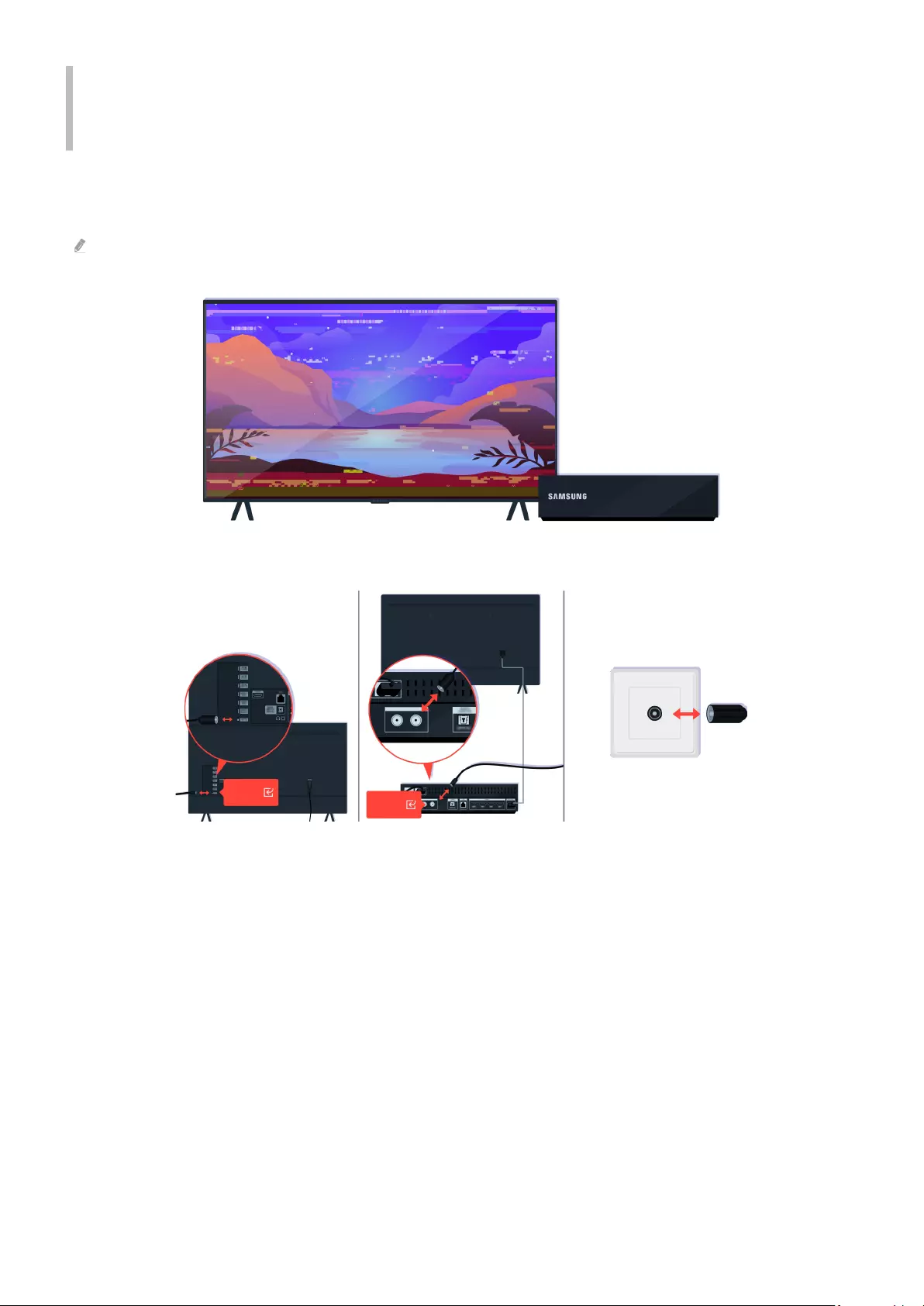
FAQ
In this section, you'll the answers to the e-Manual questions we get asked about most often.
The TV Screen does not Display Properly
The color and design of the TV and its accessories (including the remote control) and the features may differ depending on
the model or geographical area.
Check the antenna and input cable connections.
ANT
ANT
Check the antenna and input cable connections.
- 203 -

HDMI
HDMI
HDMI
Check the antenna and HDMI cable connections.
If the issue persists, define exactly what is wrong with the display. For example, mosaics and blocks, multiple lines or
white dots, fixed horizontal, or vertical lines.
Try changing channels using the remote control.
- 204 -
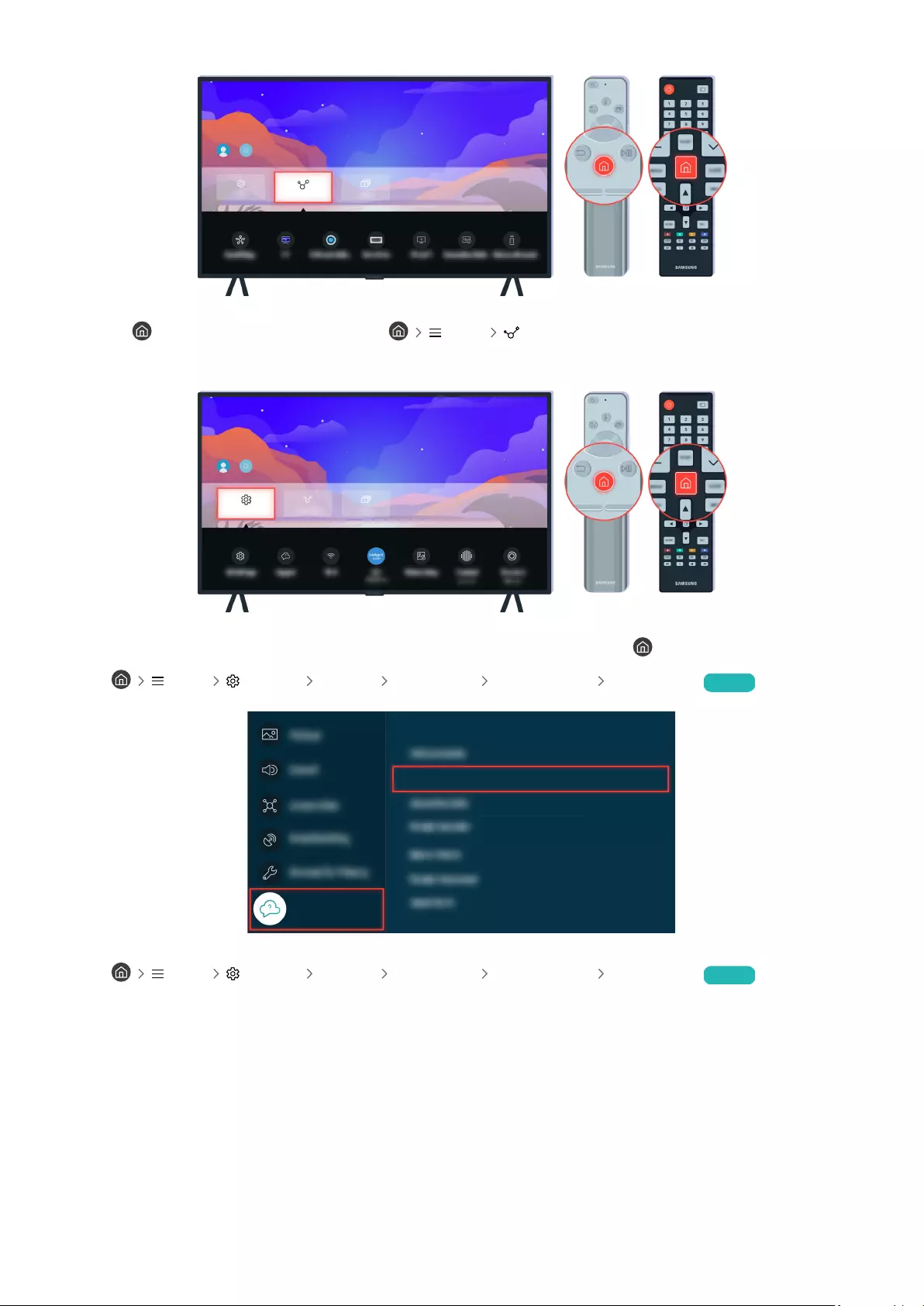
Connected Devices
Press the button, select Connected Devices ( Menu Connected Devices), choose another input
source.
Settings
If the same problem persists, run a diagnostic test. On the remote control, press the button.
Select Menu Settings Support Device Care Self Diagnosis Picture Test. Try Now
Support
Support
Device Care
Select Menu Settings Support Device Care Self Diagnosis Picture Test. Try Now
- 205 -
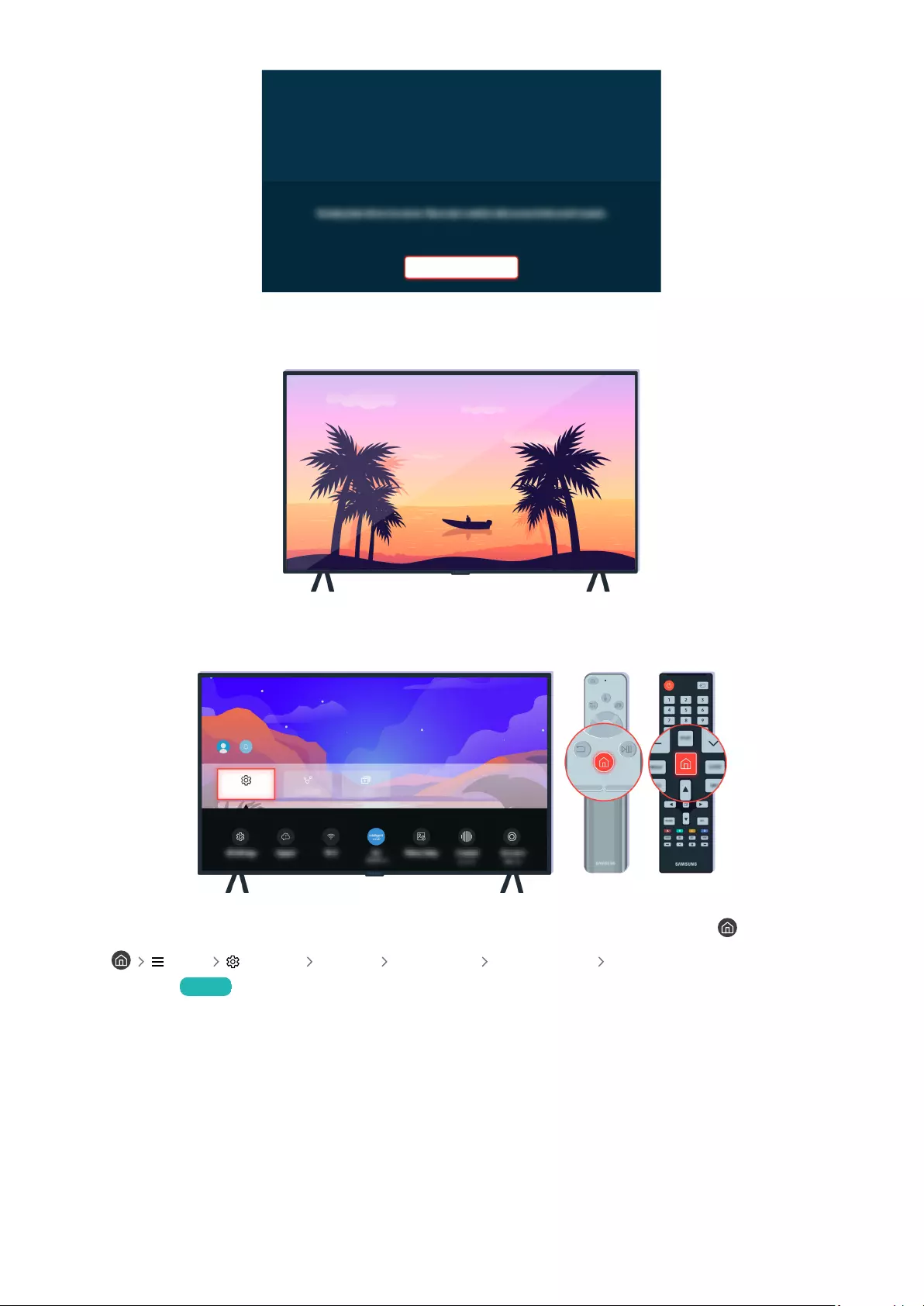
Picture Test
OK
When a message appears, select OK and follow the on-screen instructions to complete the test.
When a message appears, select OK and follow the on-screen instructions to complete the test.
Settings
If the problem disappears during the test, check your TV signal. On the remote control, press the button.
Select Menu Settings Support Device Care Self Diagnosis Signal Information to check the
signal strength. Try Now
- 206 -

Support
Support
Device Care
Select Menu Settings Support Device Care Self Diagnosis Signal Information to check the
signal strength. Try Now
Signal Information
Check whether the signal strength is too weak or not.
- 207 -
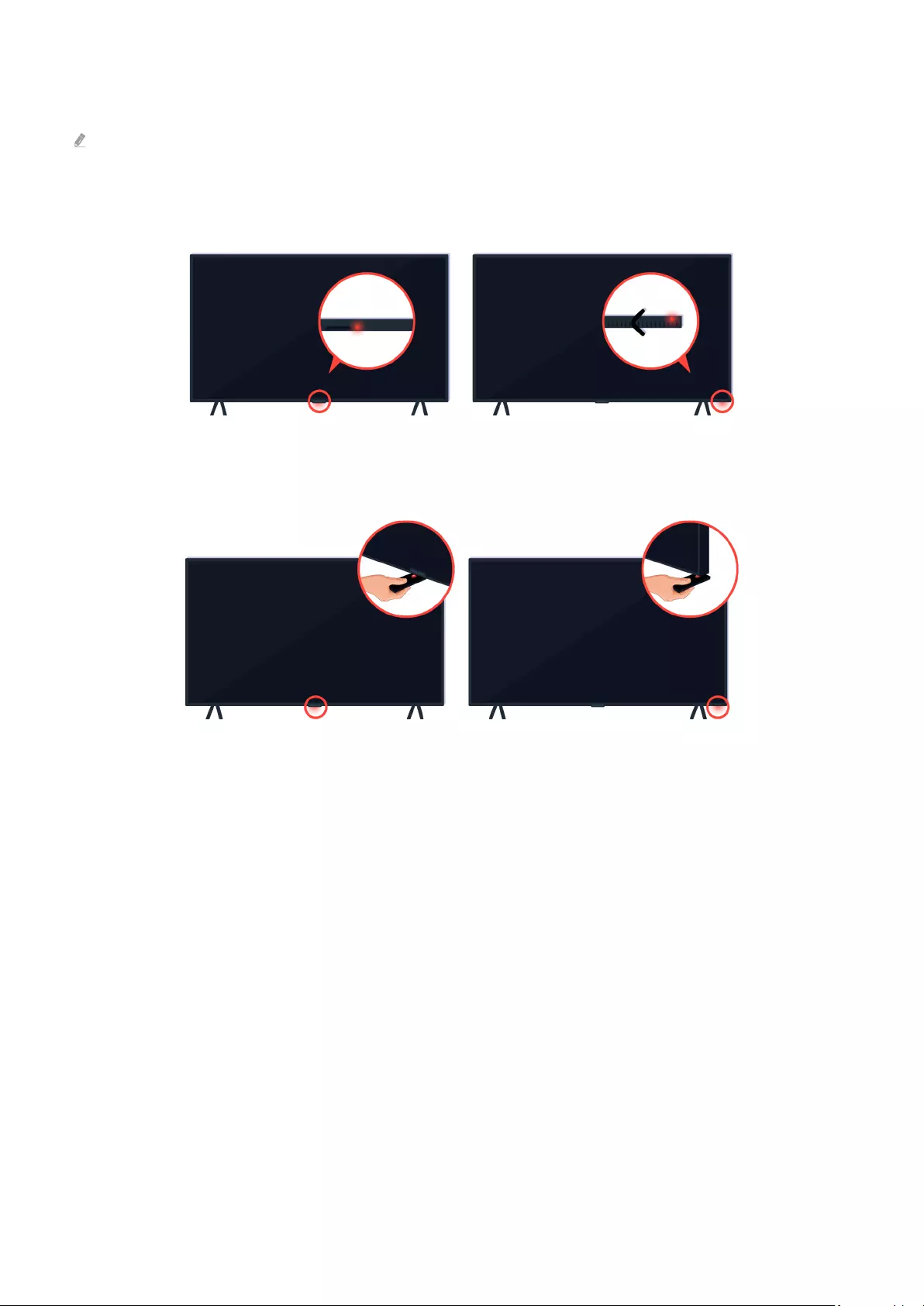
The TV does not Turn On
The color and design of the TV and its accessories (including the remote control) and the features may differ depending on
the model or geographical area.
If your TV does not turn on, check whether the remote control sensor is on.
By holding a reflective object like mirror under the TV, you can easily find the remote control sensor.
- 208 -
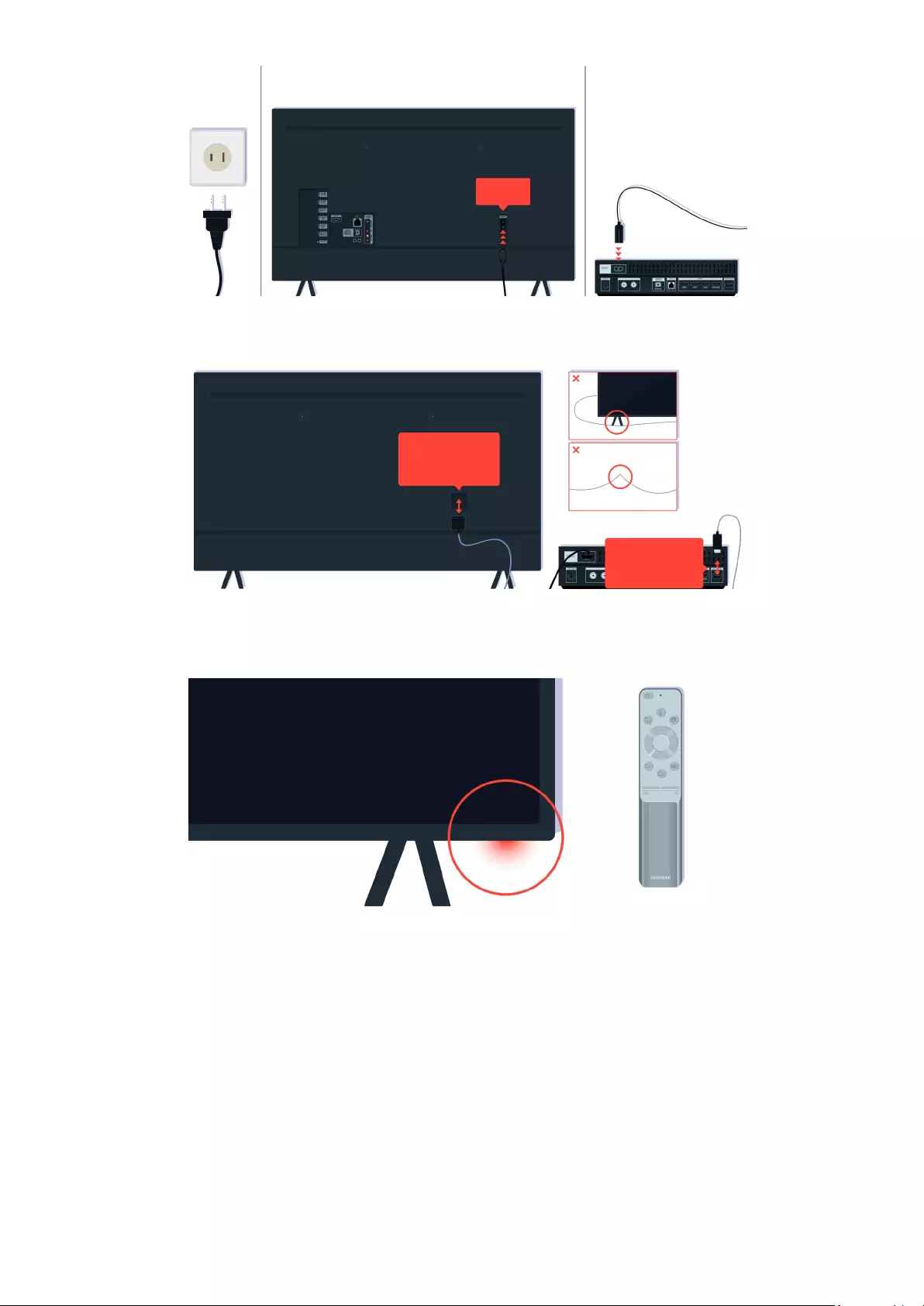
Power
If the remote control sensor is not turned on, unplug the power cable and plug it back in.
One Invisible Connection
/One Connect Cable
One Invisible Connection
/One Connect Cable
Disconnect and reconnect the One Invisible Connection or One Connect Cable between the TV and the One Connect
Box. Make sure that the One Invisible Connection or One Connect Cable is not pinched or bent sharply.
Check the remote control sensor again. If the LED is turned on, press the power button on your remote control to turn
on your TV.
- 209 -
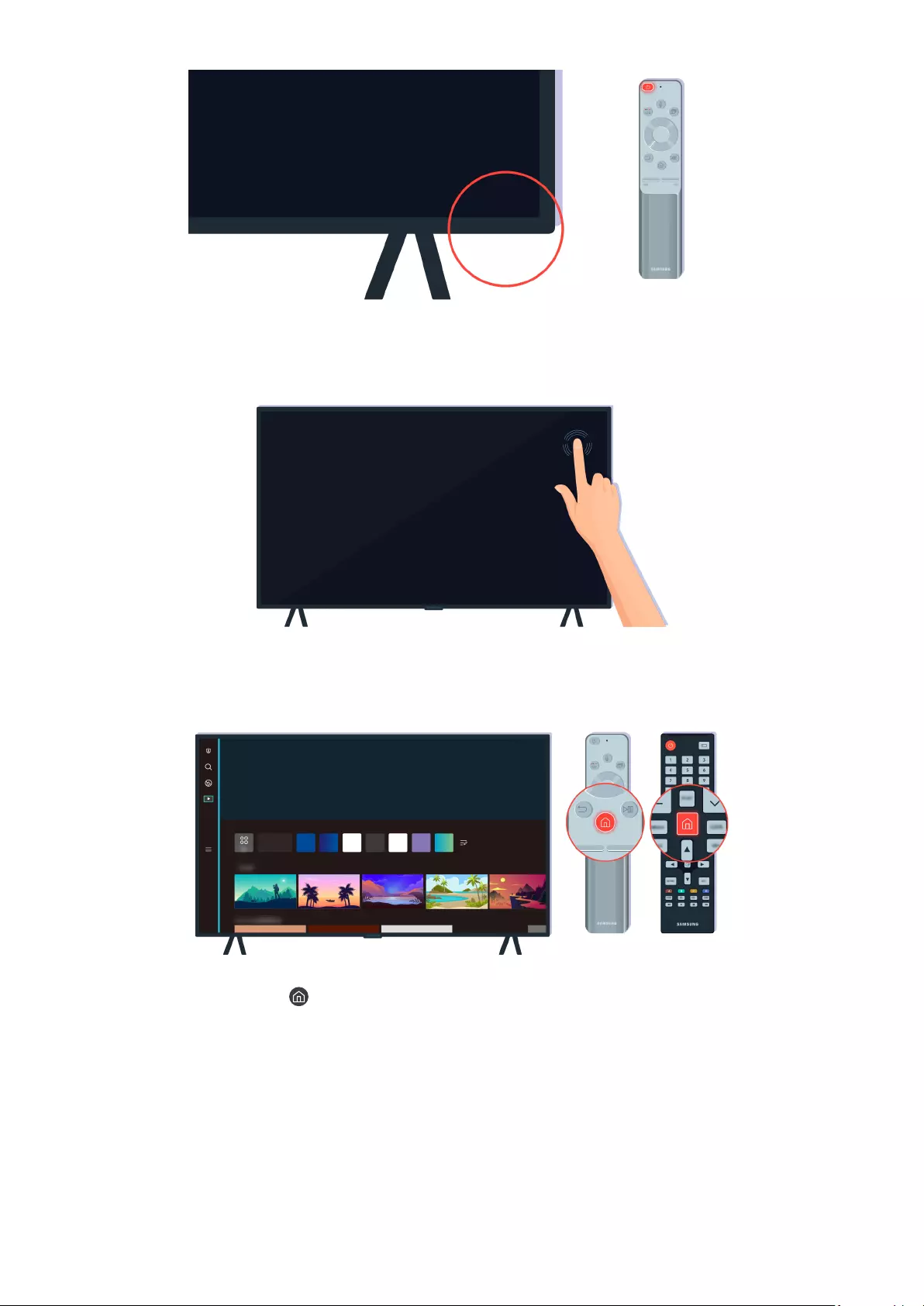
If the remote control sensor turns off when you press the power button, your TV is correctly connected to the power
supply.
If the TV screen is still blank, softly tap it with your finger. If the part of the screen you tapped on blinks, your TV is
correctly connected to the power supply.
On the remote control, press the button. When the Home Screen appears, the TV is turned on but the connected
external device does not work or is not connected correctly.
- 210 -
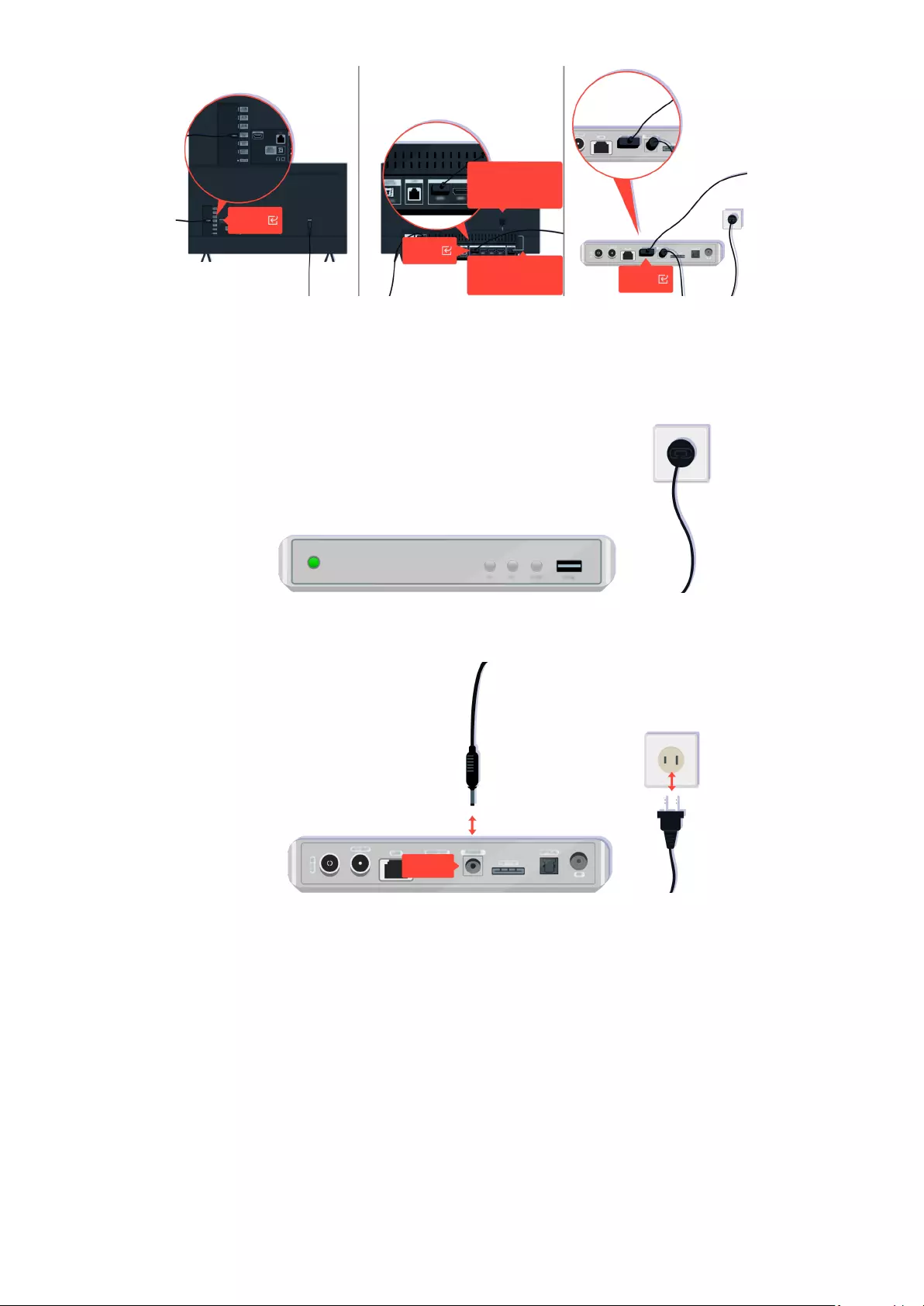
HDMI
HDMI
HDMI
One Invisible Connection
/One Connect Cable
One Invisible Connection
/One Connect Cable
Check the connection of the HDMI cable to your TV or One Connect Box.
Make sure that the external device is turned on.
Power
If it does not turn on, make sure the power cable is properly connected to the device and to the wall outlet.
- 211 -
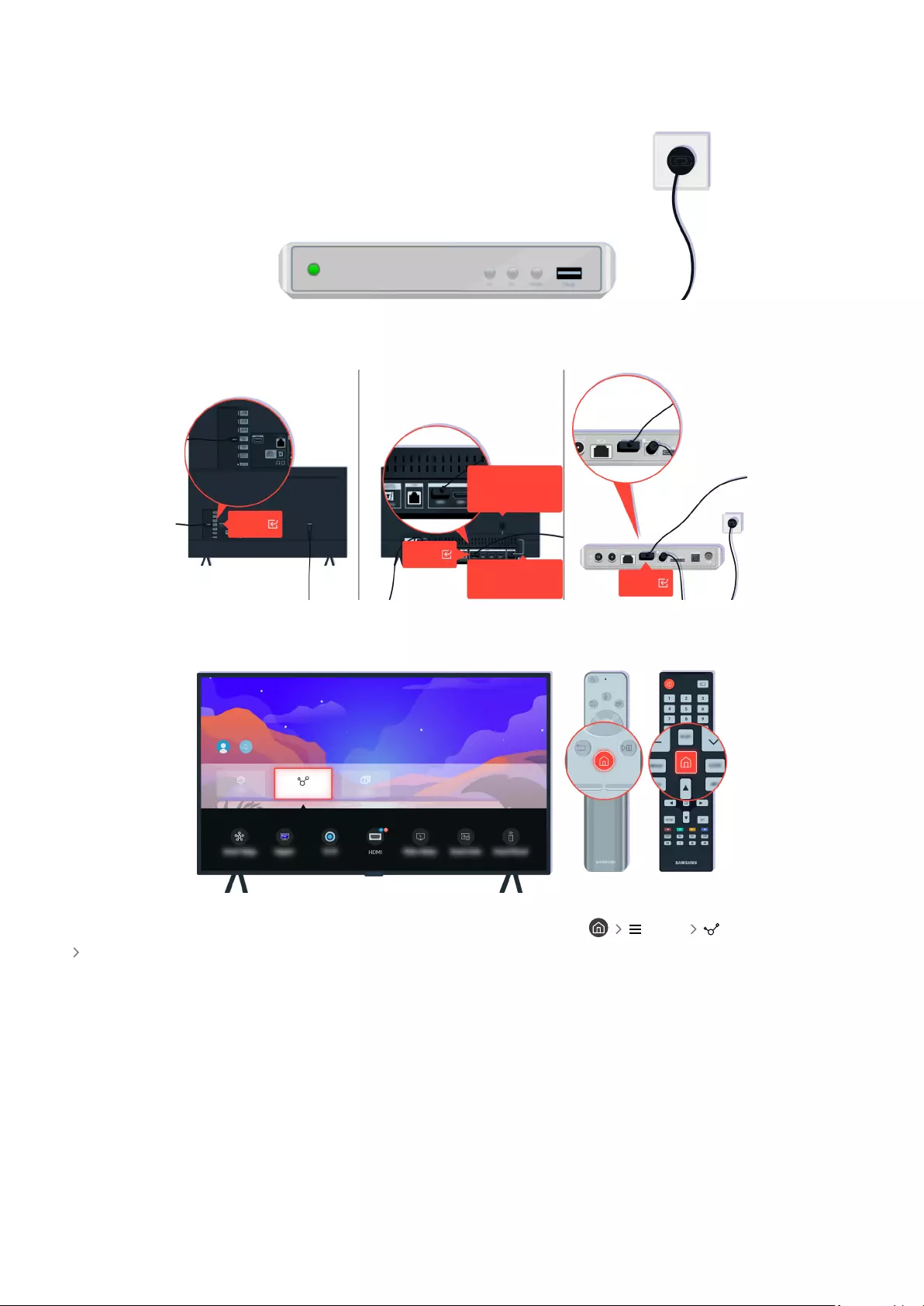
If it does not turn on, make sure the power cable is properly connected to the device and to the wall outlet.
HDMI
HDMI
HDMI
One Invisible Connection
/One Connect Cable
One Invisible Connection
/One Connect Cable
Check the connection of the HDMI cable to your TV or One Connect Box.
Connected Devices
Also make sure that the correct source is selected on the Connected Devices ( Menu Connected Devices
Sources).
- 212 -

HDMI
HDMI
HDMI
If the same problem continues, try connecting another external device to the TV using an HDMI cable. If the display is
correct, your external device may be faulty.
- 213 -
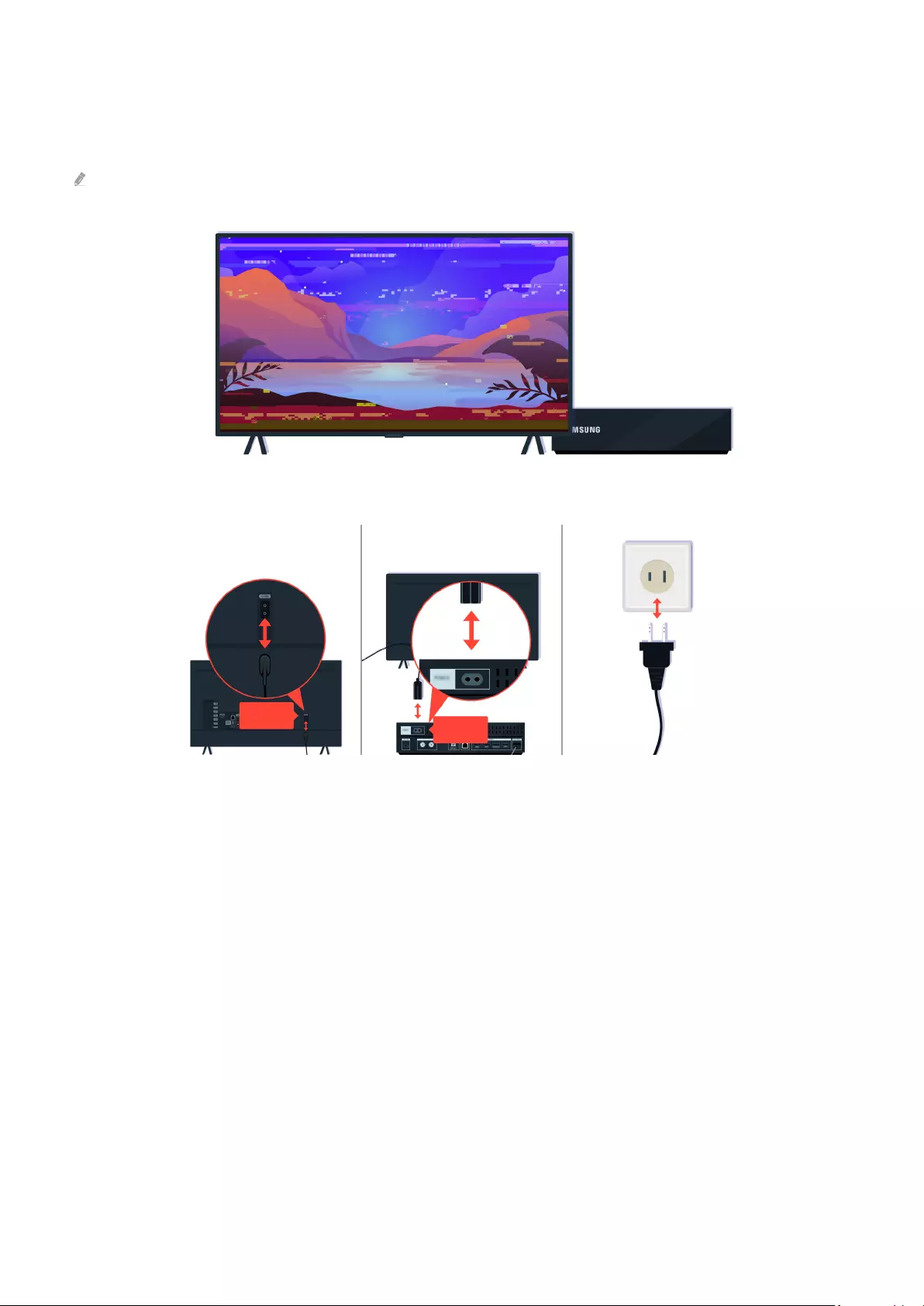
The Picture is Distorted, or No Sound Comes Out of the Sound
Bar
The color and design of the TV and its accessories (including the remote control) and the features may differ depending on
the model or geographical area.
When the picture looks distorted,
Power
Power
First disconnect and reconnect the power cables and HDMI cables on the back of your TV or the One Connect Box,
then unplug the power cord and plug it back into the wall outlet.
- 214 -
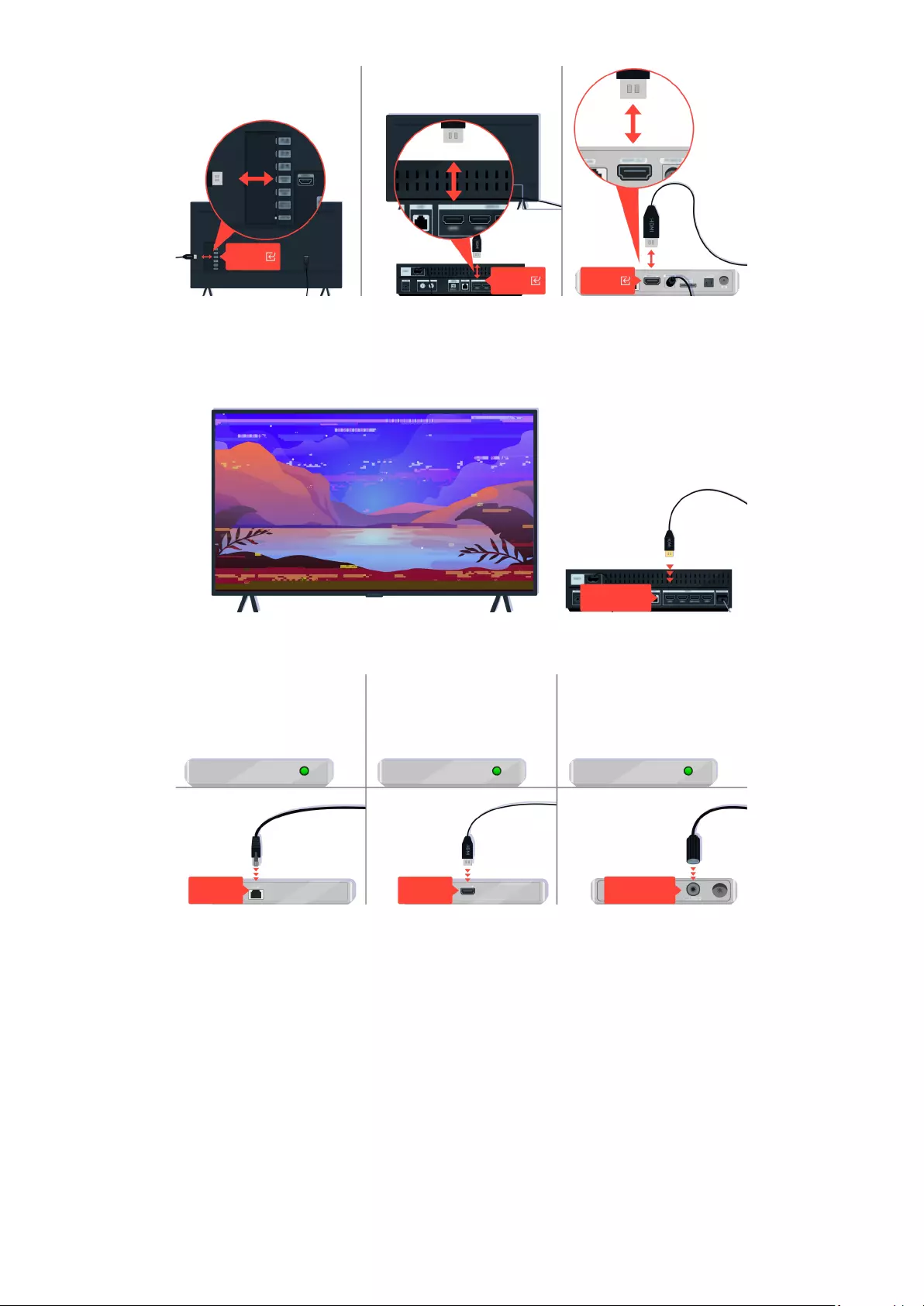
HDMI
HDMI
HDMI
First disconnect and reconnect the power cables and HDMI cables on the back of your TV or the One Connect Box,
then unplug the power cord and plug it back into the wall outlet.
HDMI
If the external device supports 4K UHD or 8K UHD videos, use a dedicated HDMI cable for each resolution.
LAN
HDMI
Satellite
If you are using a set-top box, check the cable connection. The cable you need to check depends on the type of
set-top box.
- 215 -
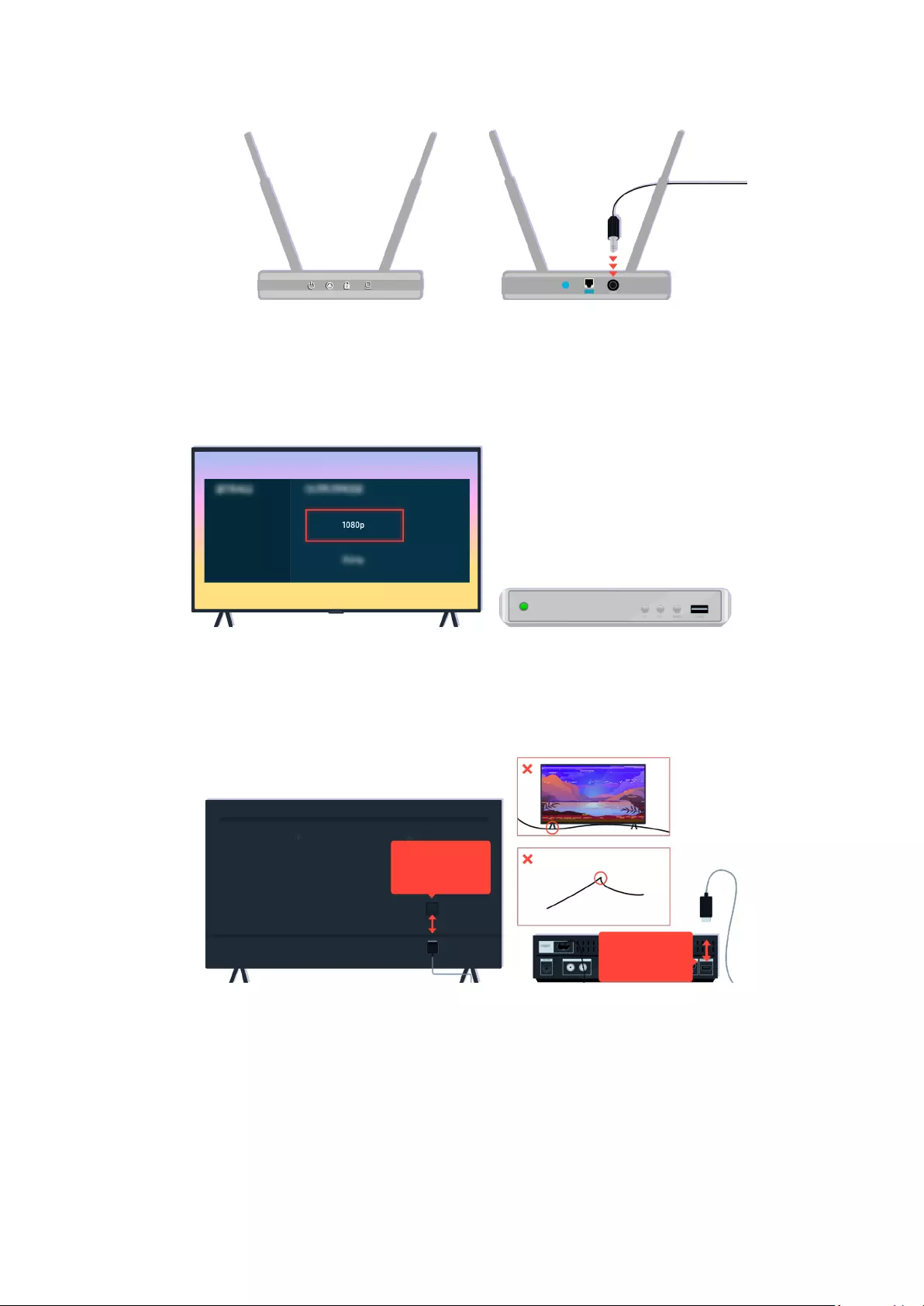
Make sure that your access point is connected to the Internet. If not, disconnecting and reconnecting its power cable
may be required.
If the problem persists, check the video output settings in the settings menu of the external device, and ensure that
your TV supports the video output mode.
FHD TVs support up to 1080p video output, and UHD TVs support up to 2160p video output.
One Invisible Connection
/One Connect Cable
One Invisible Connection
/One Connect Cable
If the problem persists, and if your TV uses the One Invisible Connection or One Connect Cable, disconnect and
reconnect the One Invisible Connection or One Connect Cable to the TV and the One Connect Box. Ensure that the
One Invisible Connection or One Connect Cable is not pinched or bent sharply.
- 216 -

HDMI (eARC)
HDMI
If no sound comes out of your Sound Bar, and if it is connected to the TV with an HDMI cable, check the HDMI (eARC)
connector on the back of the TV.
HDMI (eARC)
HDMI
HDMI
If your Sound Bar is connected to a receiver, and the receiver is connected to the TV using an HDMI cable, check the
HDMI connector on the back of the TV. The cable must be connected to the HDMI (eARC) port on your TV.
- 217 -
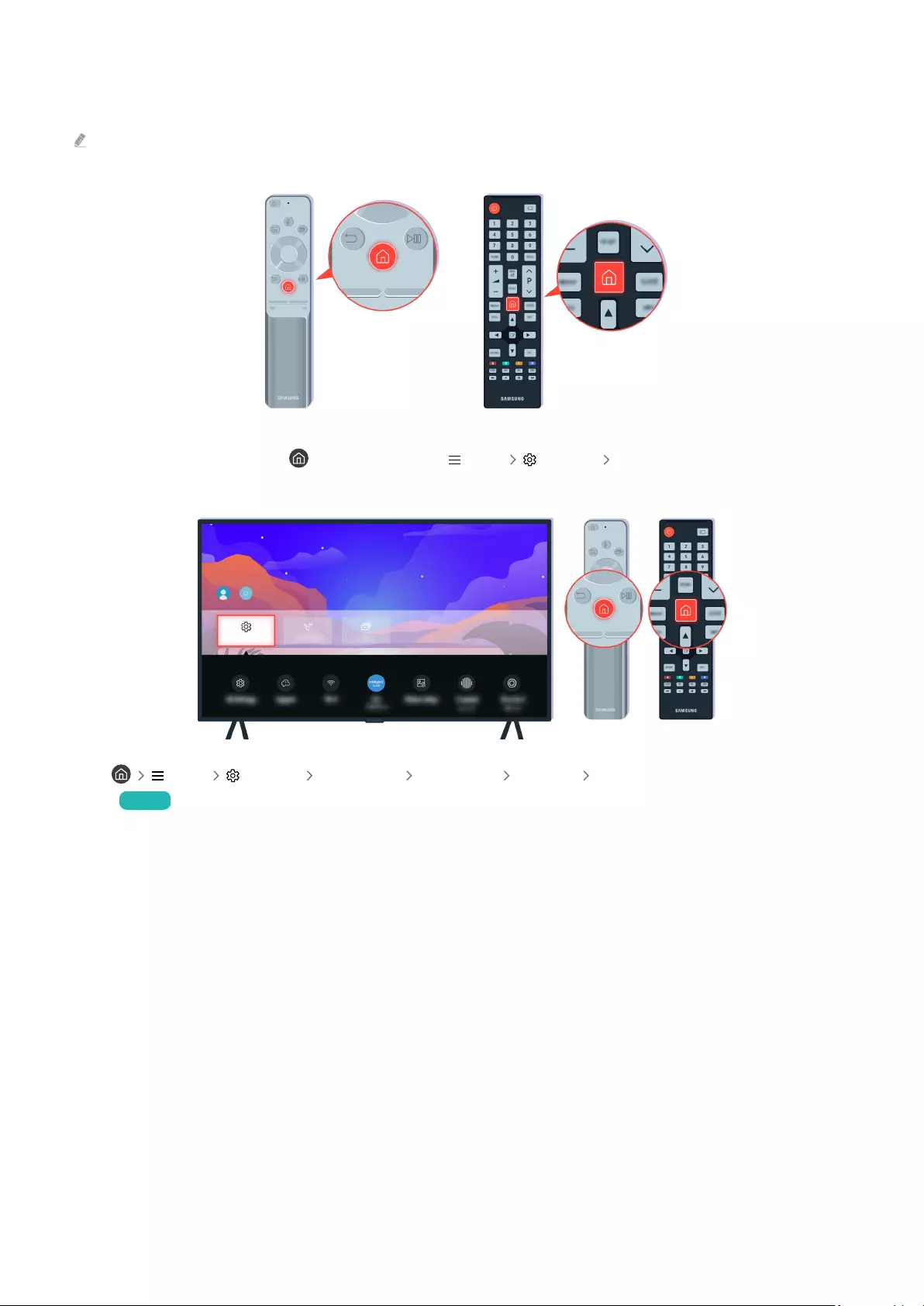
Network Access is not Available
The color and design of the TV and its accessories (including the remote control) and the features may differ depending on
the model or geographical area.
On the remote control, press the button and move to Menu Settings All Settings using the directional
button.
Settings
Select Menu Settings All Settings Connection Network Network Status to check the network
status. Try Now
- 218 -
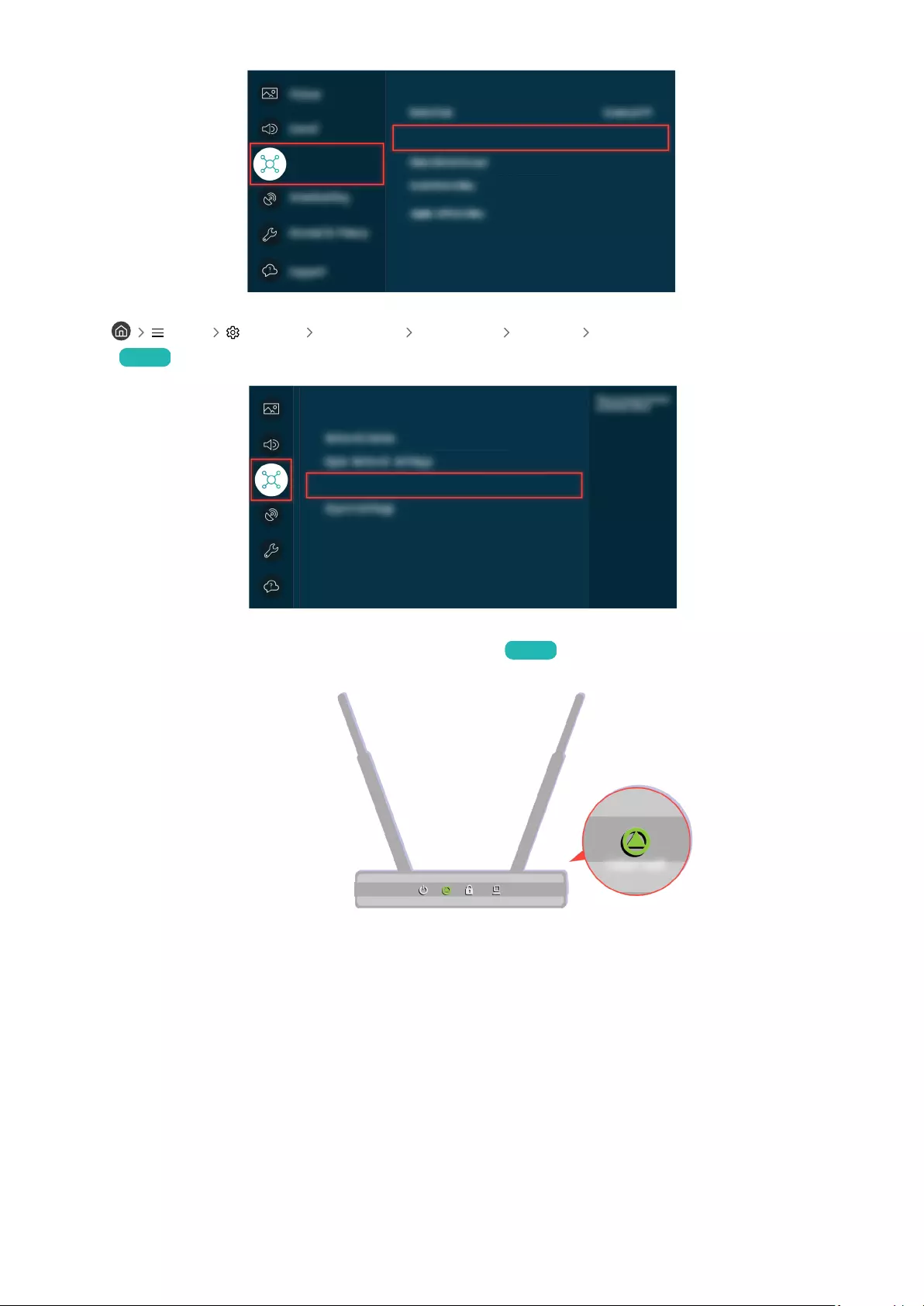
Connection
Connection
Network
Select Menu Settings All Settings Connection Network Network Status to check the network
status. Try Now
Network
Reset Network
If the network isn't connected, a network reset may be required. Try Now
Make sure that your access point is working properly. Check the LED indicators on your access point to make sure it is
operating normally.
- 219 -
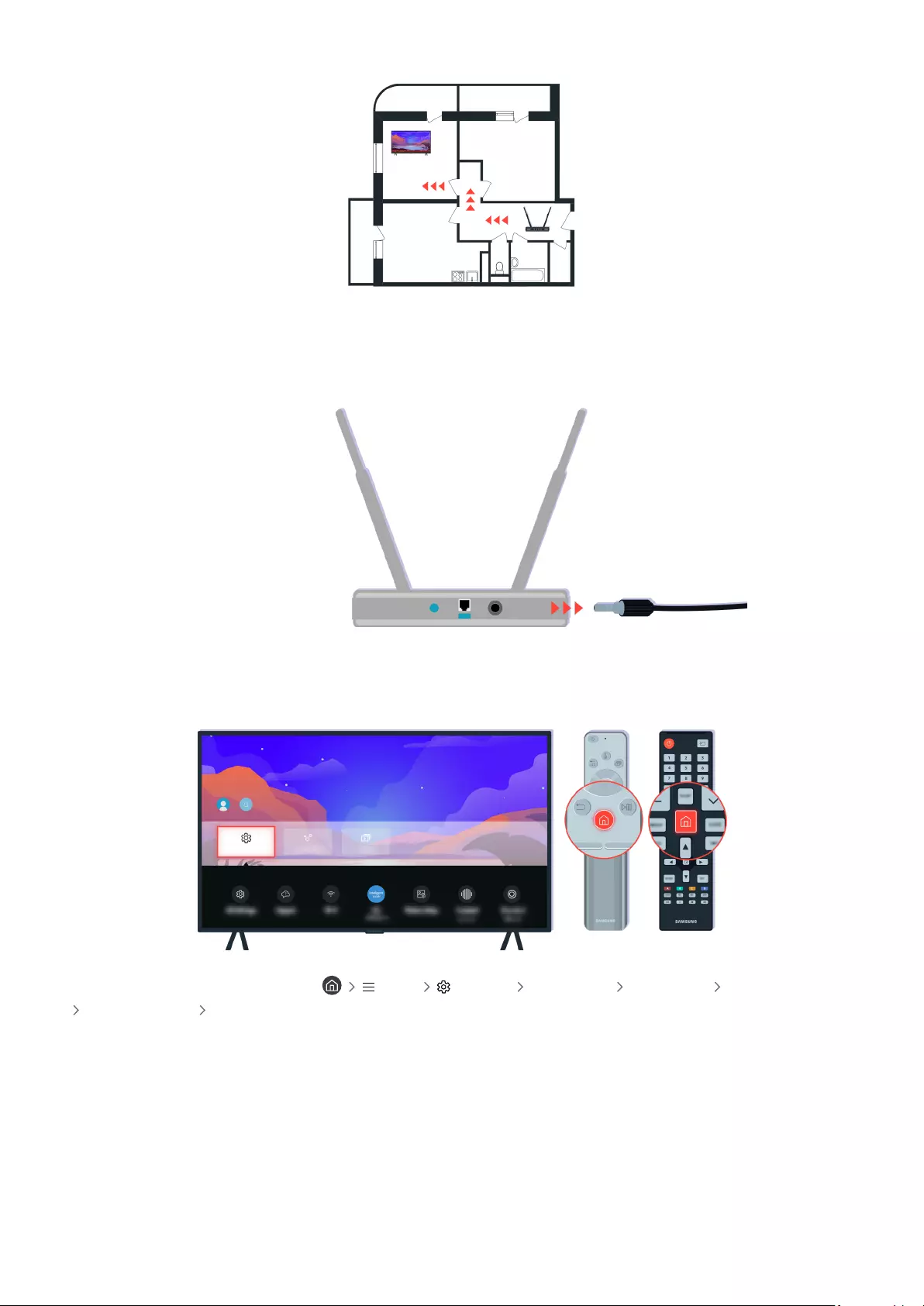
If you are using a wireless access point, check the access point location. If the access point is too far from the TV,
move it closer.
Try rebooting the access point by disconnecting and reconnecting the power connector. It may take 1 to 2 minutes
until the access point comes back online after a reboot.
Settings
If the same problem continues, select Menu Settings All Settings Connection Network
Network Status IP Settings to change to a different DNS server. If a test occurs, cancel it and select IP Settings.
- 220 -
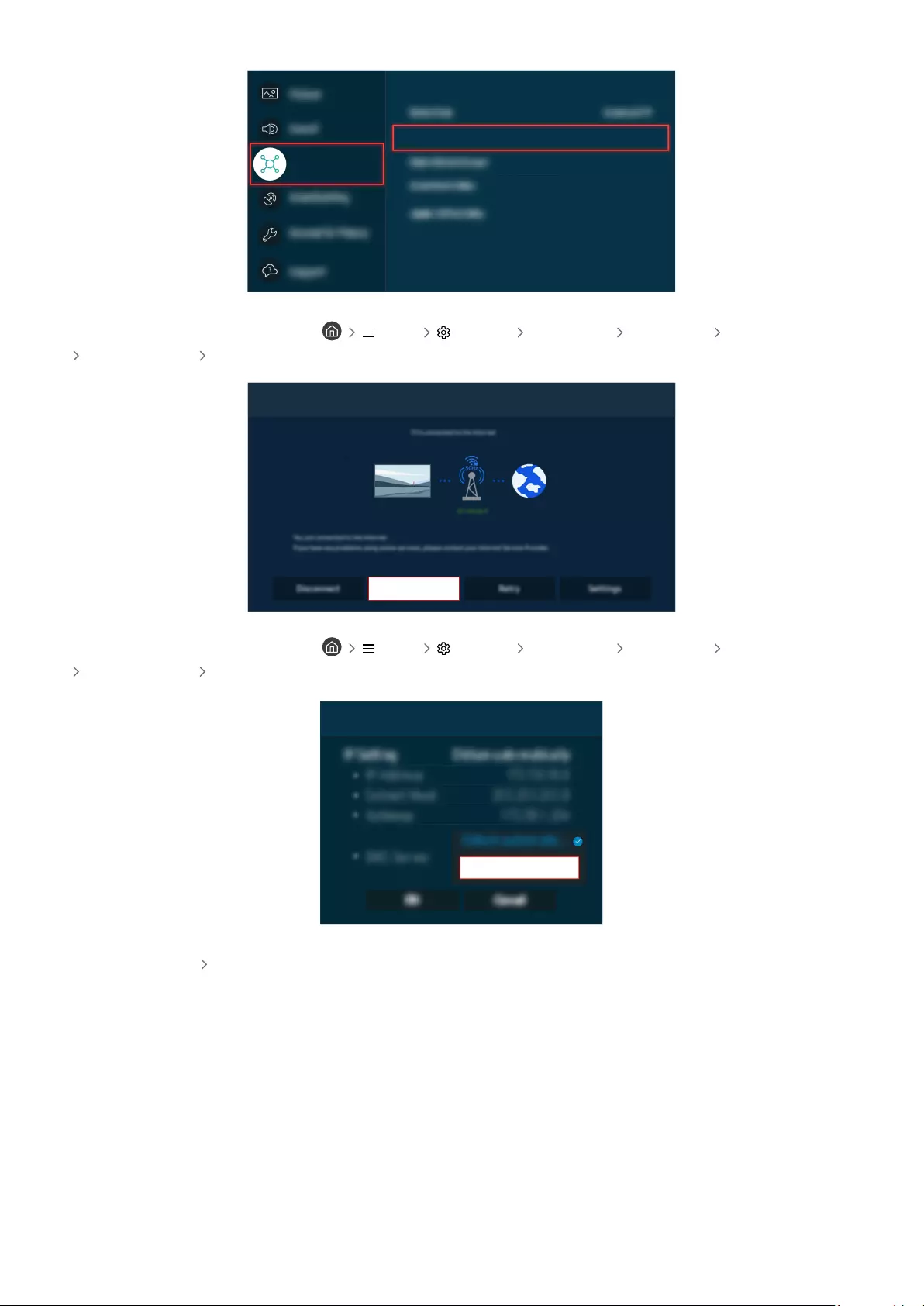
Connection
Connection
Network
If the same problem continues, select Menu Settings All Settings Connection Network
Network Status IP Settings to change to a different DNS server. If a test occurs, cancel it and select IP Settings.
Network Status
IP Settings
If the same problem continues, select Menu Settings All Settings Connection Network
Network Status IP Settings to change to a different DNS server. If a test occurs, cancel it and select IP Settings.
IP Settings
DNS Setting
Enter manually
Select DNS Setting Enter manually.
- 221 -

IP Settings
DNS Server
Select DNS Server, enter 8.8.8.8, then select OK.
Update now
If the same problem continues, a software update or factory reset may be required. Try Now
- 222 -
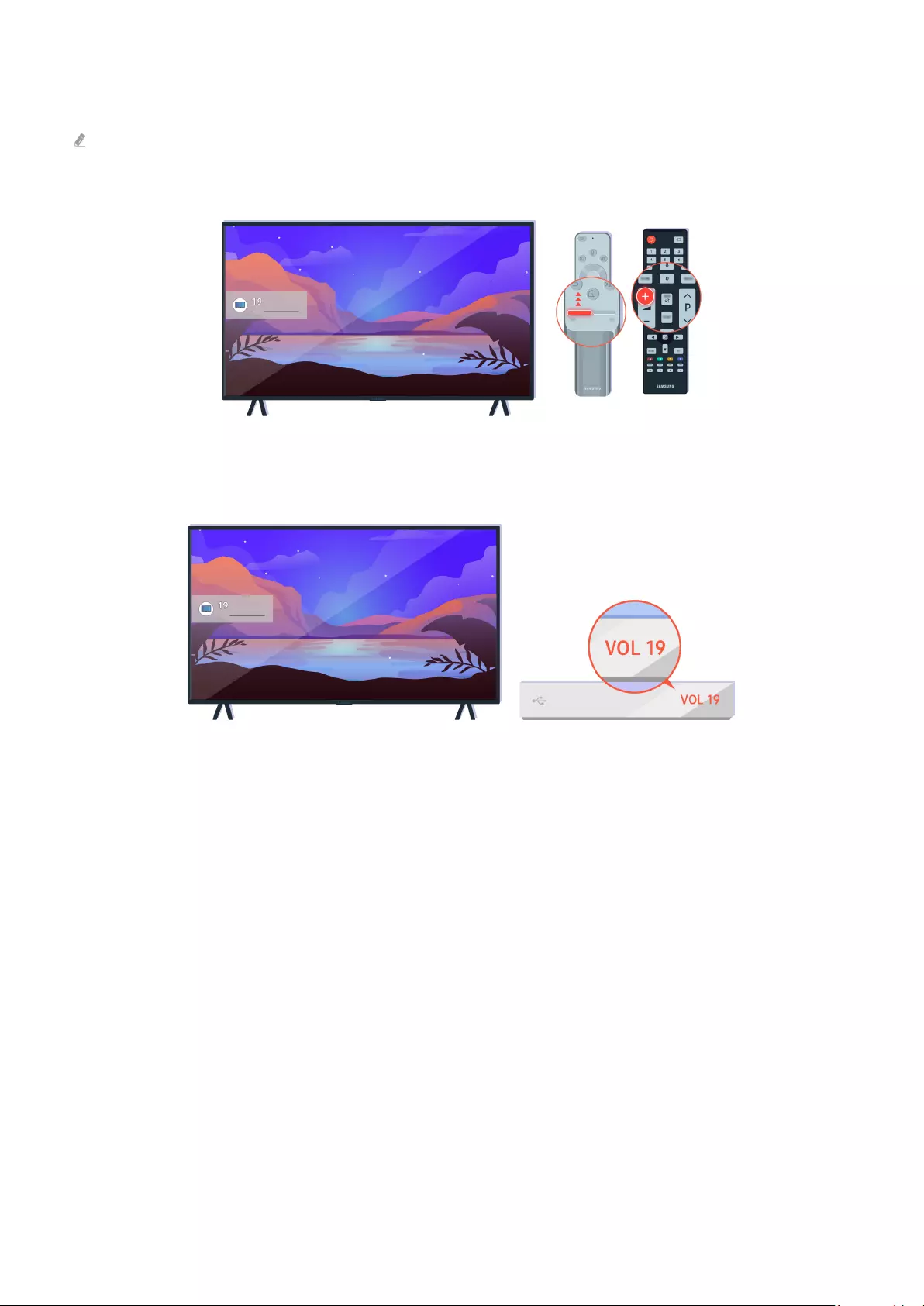
There is No Sound or the Speakers are Making an Odd Sound
The color and design of the TV and its accessories (including the remote control) and the features may differ depending on
the model or geographical area.
If your TV does not produce any sound, press the Volume + button to increase the volume.
If your TV is connected to an external device, check the volume of the external device.
- 223 -
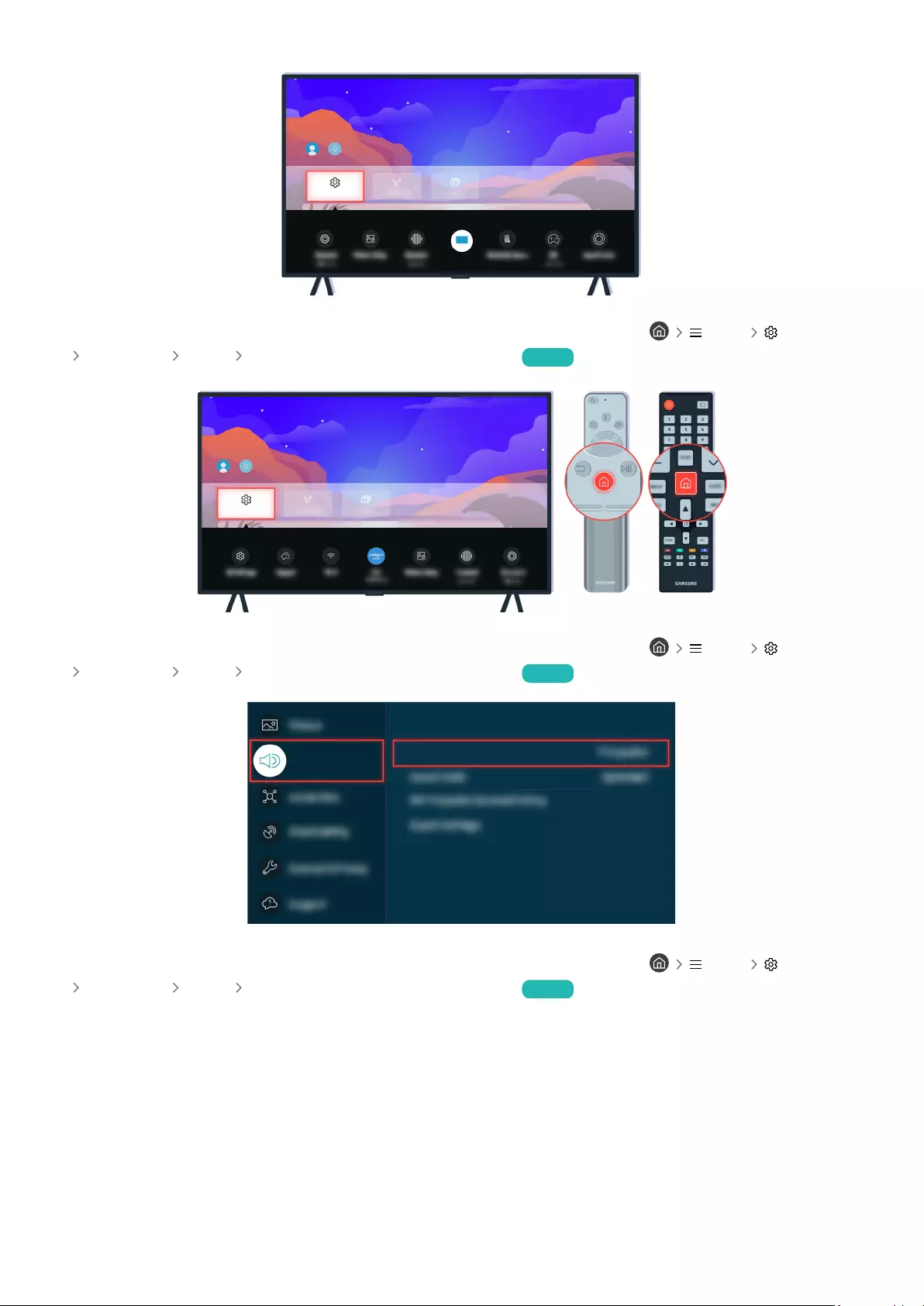
Settings
TV Speaker
Sound Output
Check the volume on the screen. If a number for the TV volume is not displayed, select Menu Settings
All Settings Sound Sound Output. Then, select TV Speaker. Try Now
Settings
Check the volume on the screen. If a number for the TV volume is not displayed, select Menu Settings
All Settings Sound Sound Output. Then, select TV Speaker. Try Now
Sound
Sound
Sound Output
Check the volume on the screen. If a number for the TV volume is not displayed, select Menu Settings
All Settings Sound Sound Output. Then, select TV Speaker. Try Now
- 224 -
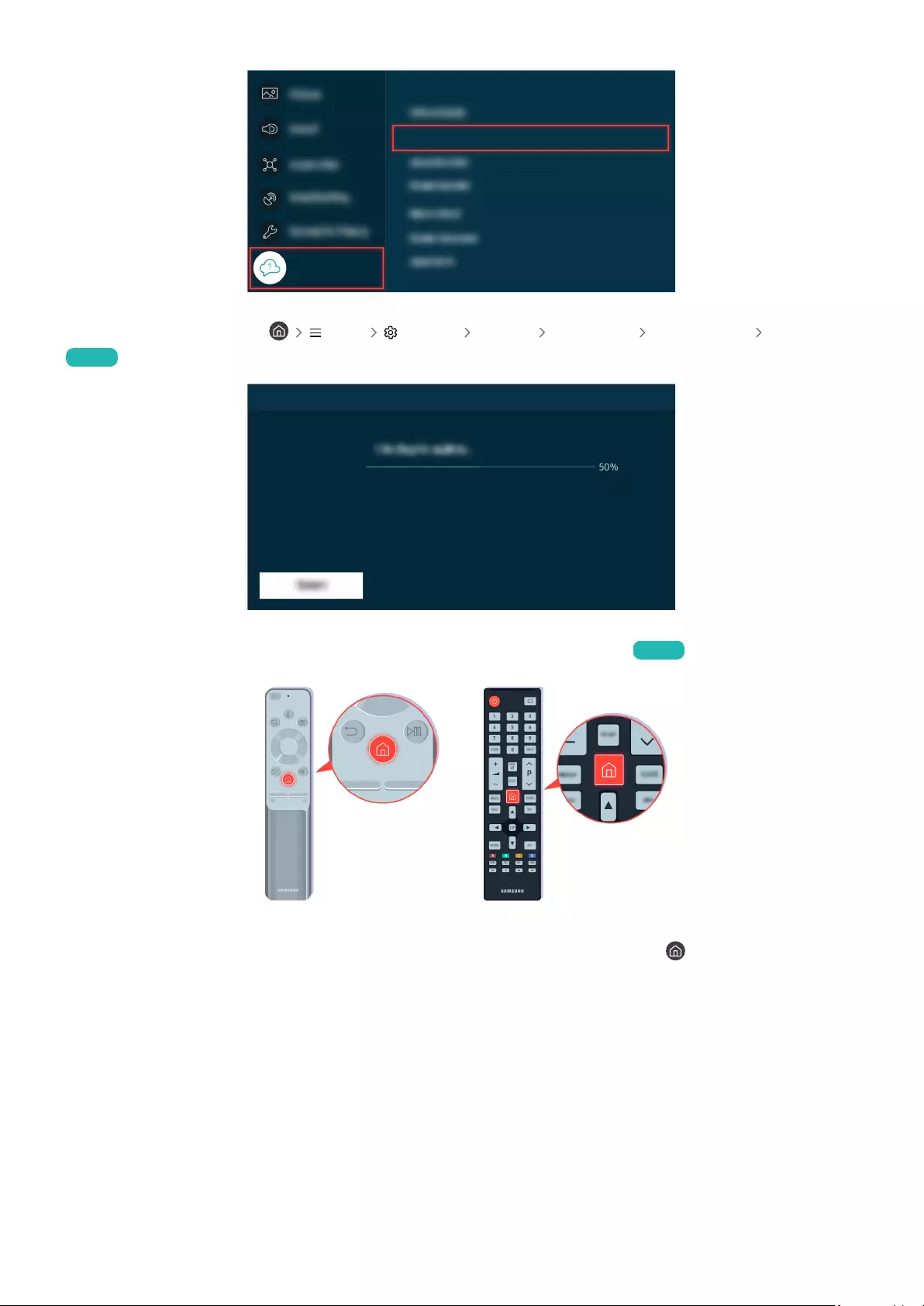
Support
Support
Device Care
To check sound output, select Menu Settings Support Device Care Self Diagnosis Sound Test.
Try Now
Update now
If the same problem continues, a software update or factory reset may be required. Try Now
If there is sound but it is not clear, run a diagnostic test. On the remote control, press the button.
- 225 -
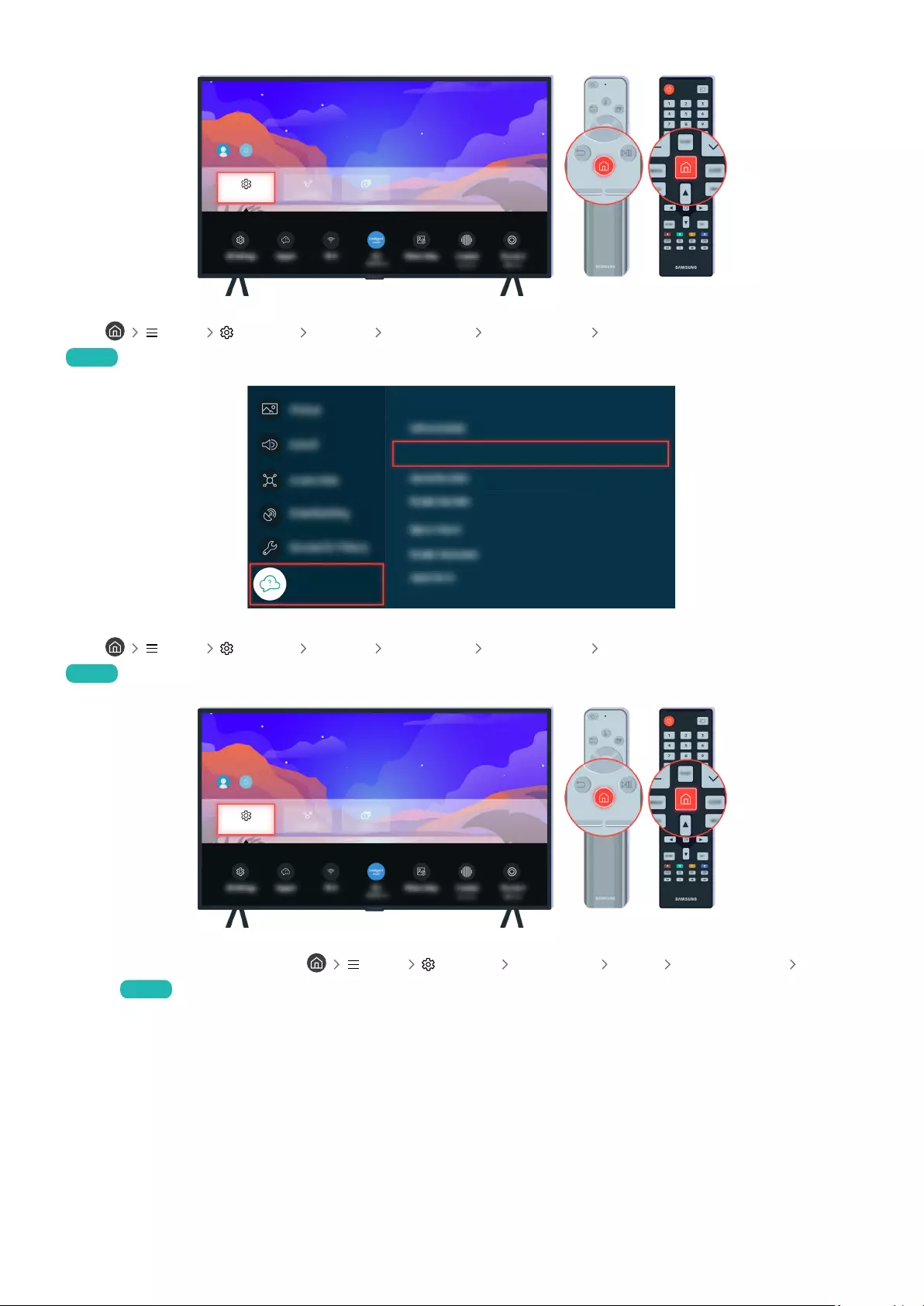
Settings
Go to Menu Settings Support Device Care Self Diagnosis Sound Test to check the sound.
Try Now
Support
Support
Device Care
Go to Menu Settings Support Device Care Self Diagnosis Sound Test to check the sound.
Try Now
Settings
If the test reveals a problem, select Menu Settings All Settings Sound Expert Settings Reset
Sound. Try Now
- 226 -
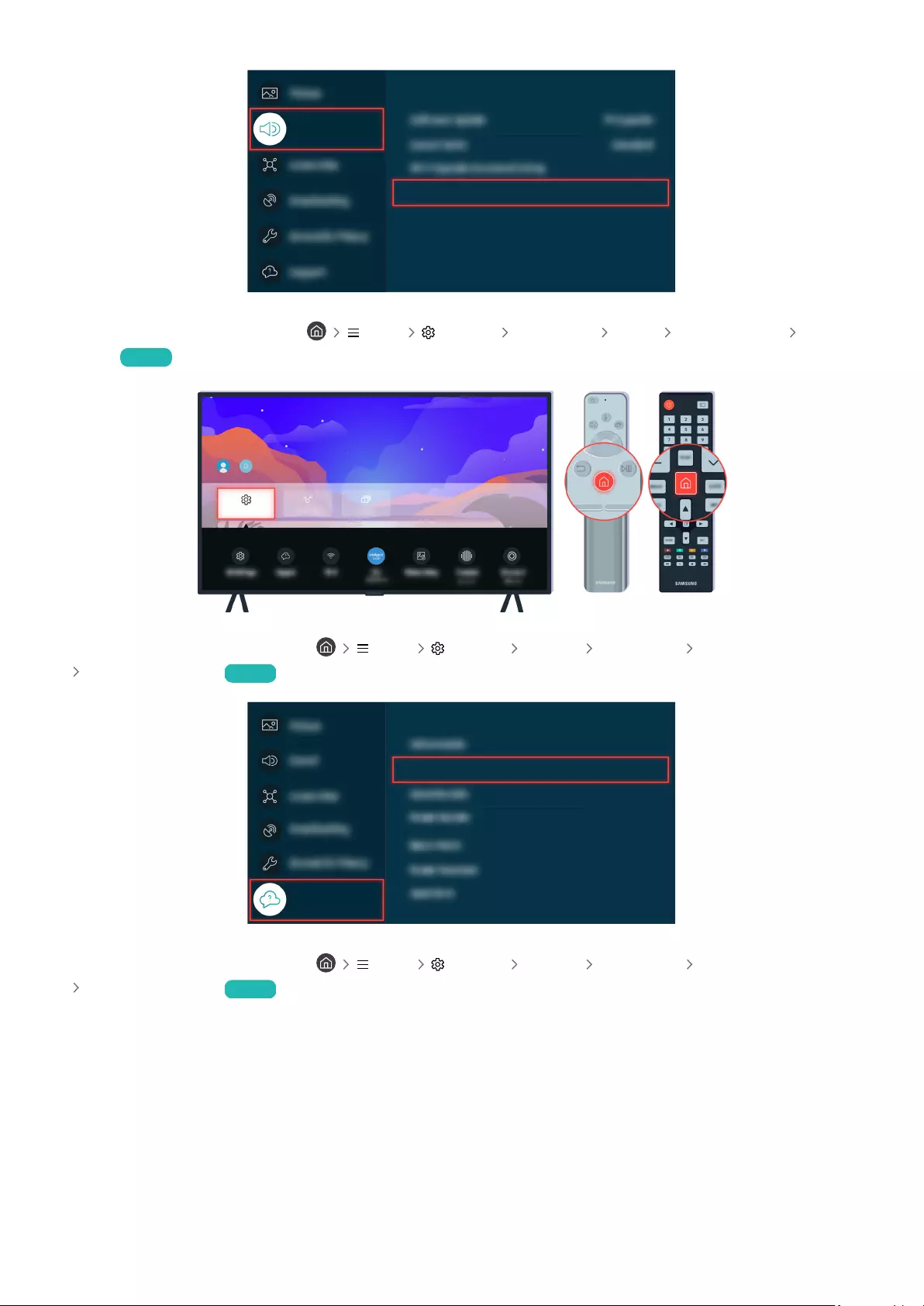
Sound
Sound
Expert Settings
If the test reveals a problem, select Menu Settings All Settings Sound Expert Settings Reset
Sound. Try Now
Settings
If the test shows no problems, select Menu Settings Support Device Care Self Diagnosis
Signal Information. Try Now
Support
Support
Device Care
If the test shows no problems, select Menu Settings Support Device Care Self Diagnosis
Signal Information. Try Now
- 227 -

Signal Information
Check whether the signal strength is too weak or not.
Update now
If the same problem continues, a software update or factory reset may be required. Try Now
- 228 -

The Remote Control does not Work
The color and design of the TV and its accessories (including the remote control) and the features may differ depending on
the model or geographical area.
Verify that the infrared remote control signal is being transmitted and received.
Make sure the remote control sensor on the TV is blinking.
- 229 -
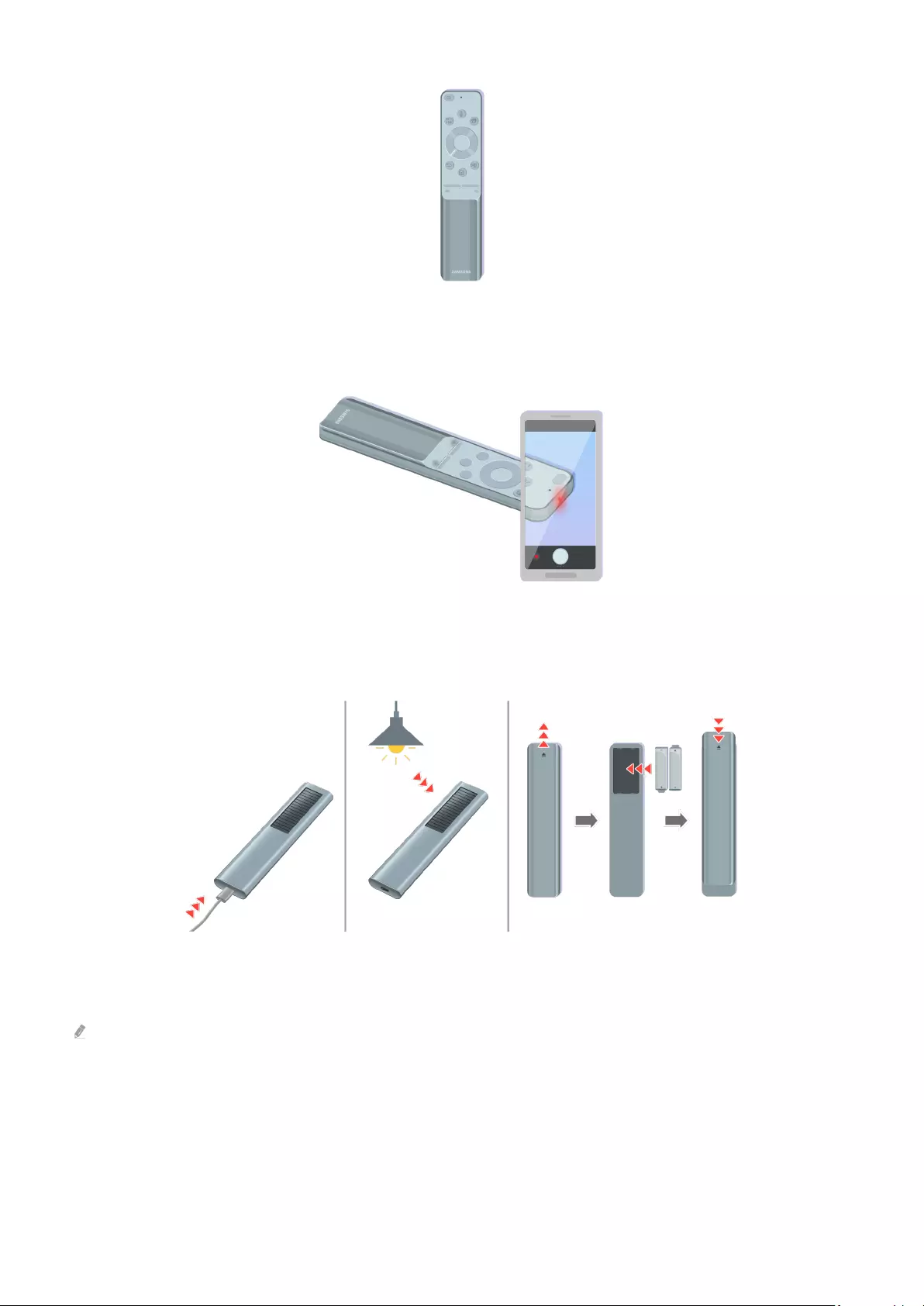
Make sure the remote control works properly.
You can check whether the signal is being transmitted by pressing the power button and observing the front tip of
the remote control through the camera on your smartphone.
If you cannot see infrared signals, charge the remote control by using the USB port (C-type) on the bottom, or turn
over the remote to expose the solar cell. If the remote control has batteries, replace them with new ones.
Depending on the model you purchased, the remote control provided may vary.
- 230 -
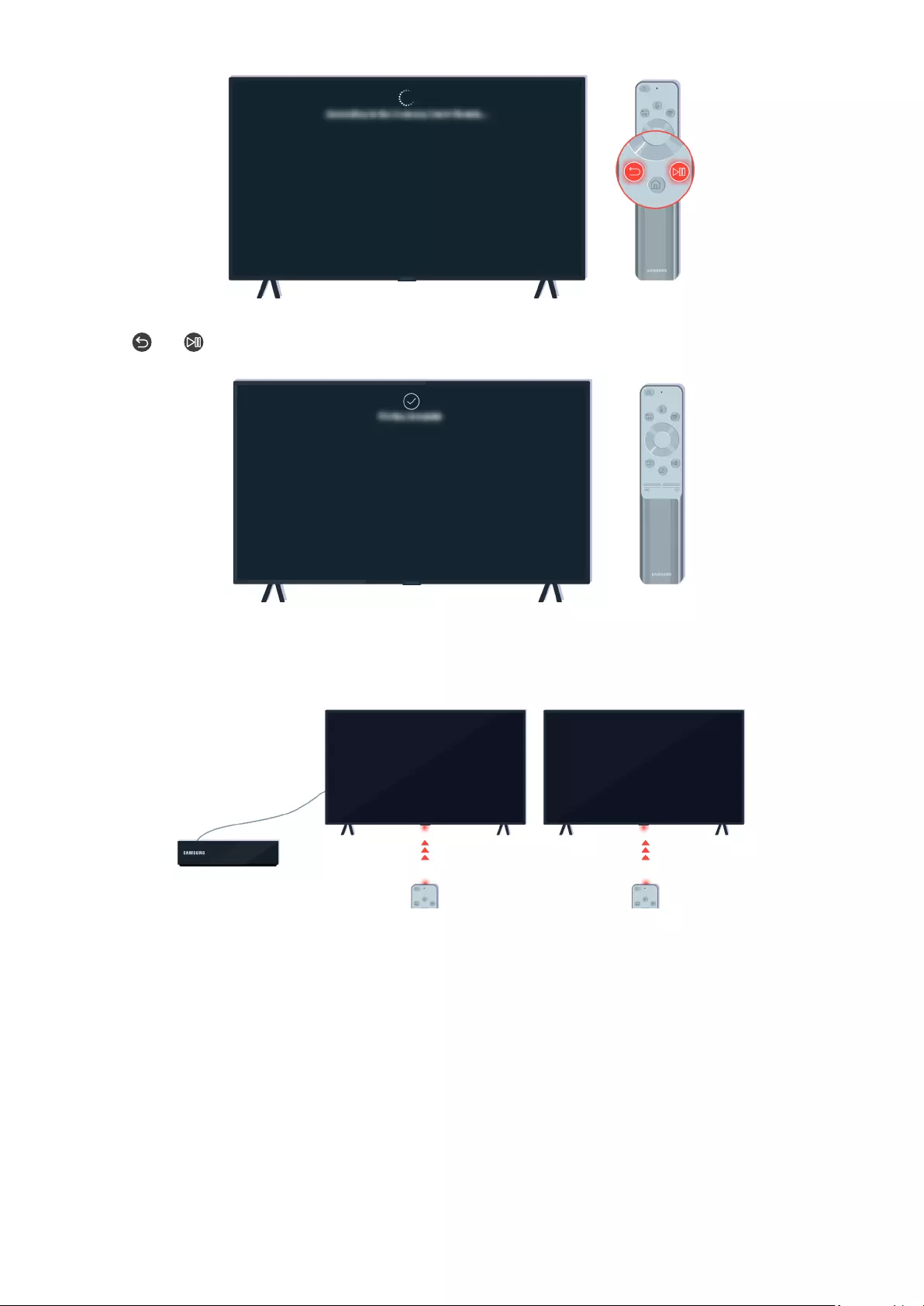
Press the and buttons simultaneously to display the pairing animation clip.
Follow the on-screen instructions to proceed with the pairing.
The remote control will work more effectively if you point it at the remote control sensor.
- 231 -

If the same problem continues, try using the appropriate SAMSUNG remote control for your TV model.
If you use an Multi-Brand Remote (MBR) or universal remote and your remote cannot operate an external device,
move the external device closer to the One Connect Box.
- 232 -
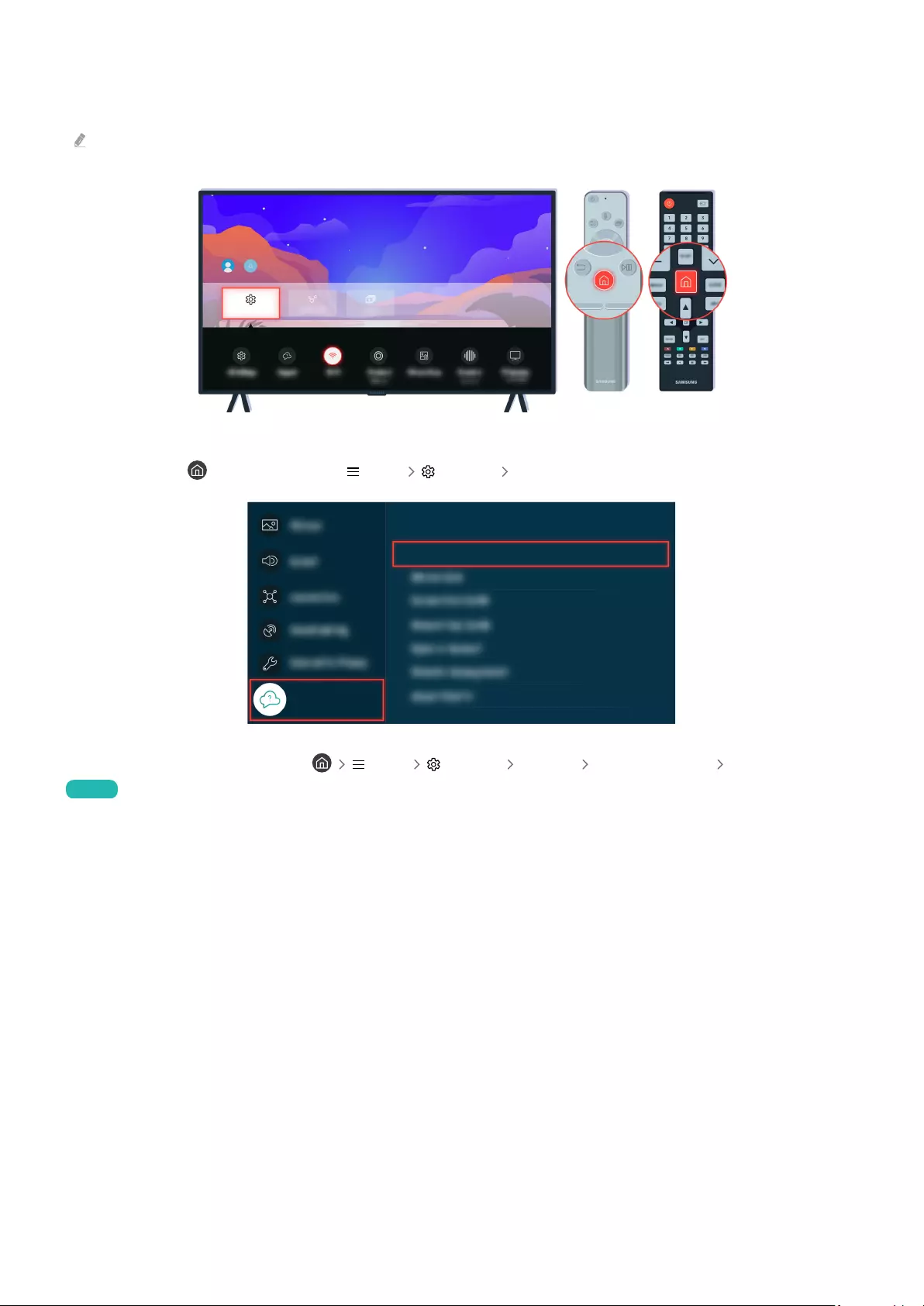
Updating the Software
The color and design of the TV and its accessories (including the remote control) and the features may differ depending on
the model or geographical area.
Settings
If your TV is connected to the network, you can set it to receive periodic updates automatically. On the remote
control, press the button and move to Menu Settings Support using the directional button.
Support
Support
Software Update
To enable automatic updates, select Menu Settings Support Software Update Auto Update.
Try Now
- 233 -
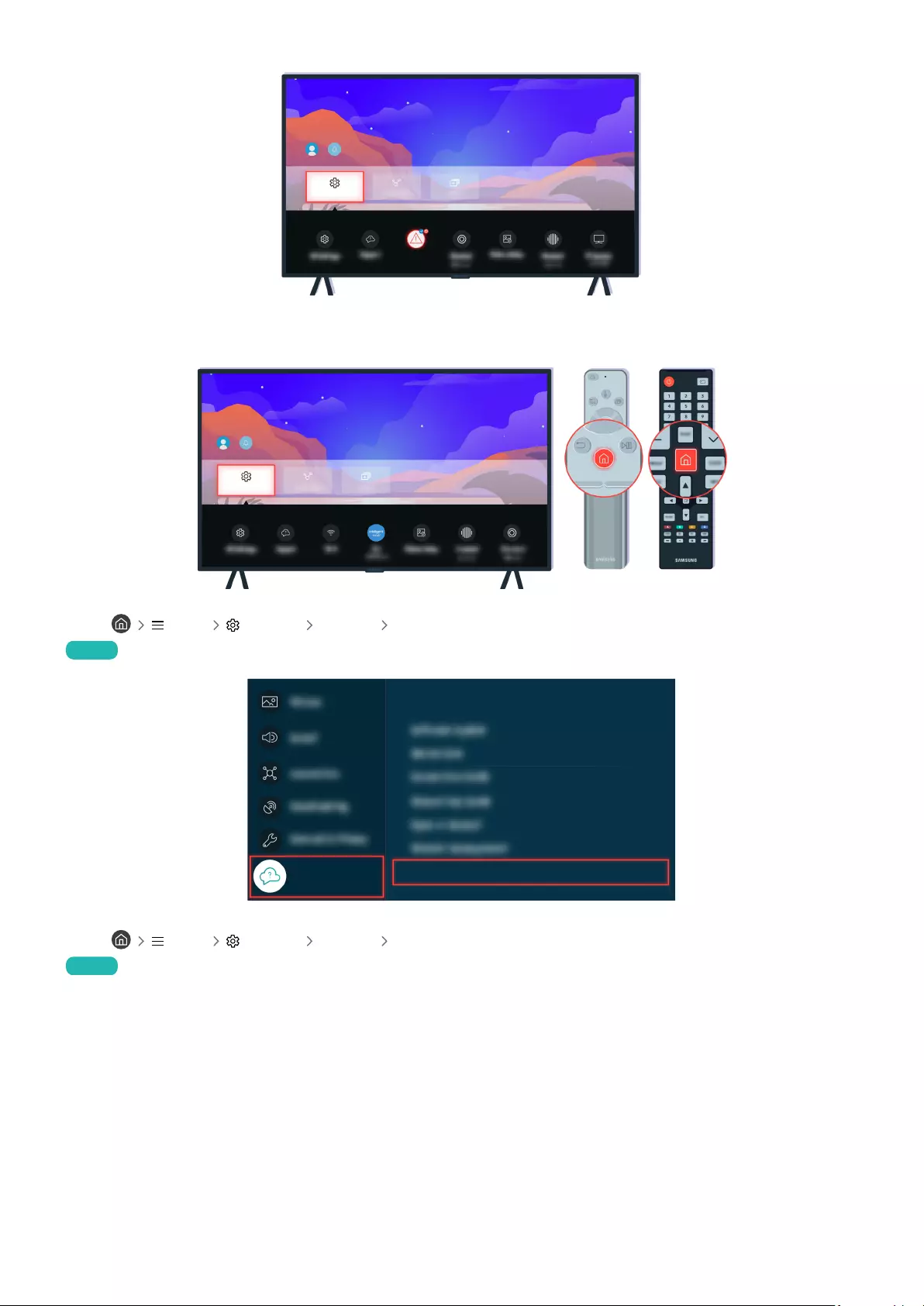
Settings
No Access
Network
If your TV is not connected to the network, you can update the software using a USB drive.
Settings
Select Menu Settings Support About This TV and check the model code and software version.
Try Now
Support
Support
About This TV
Select Menu Settings Support About This TV and check the model code and software version.
Try Now
- 234 -
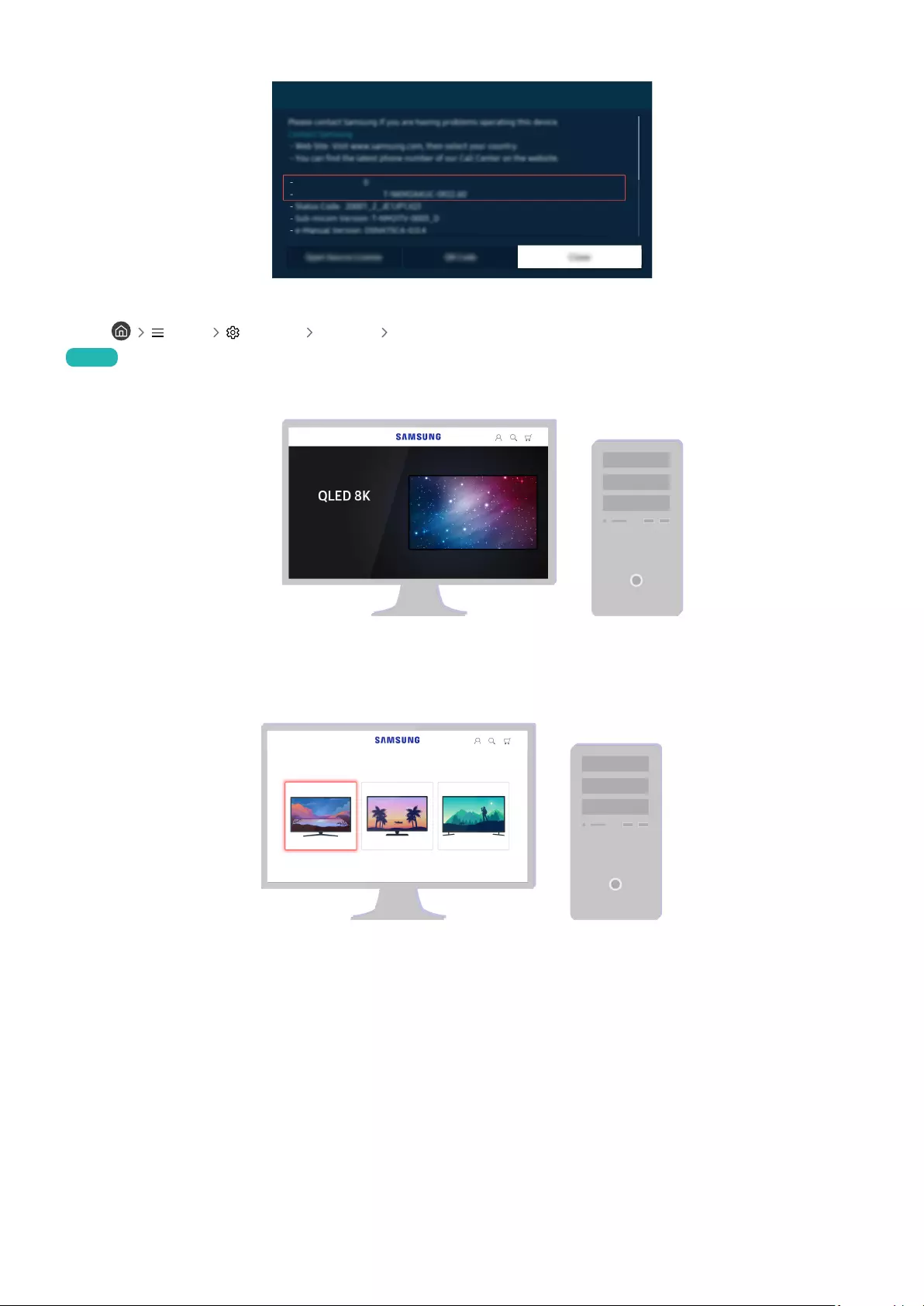
About This TV
Product Information
Model code:
Software version:
Select Menu Settings Support About This TV and check the model code and software version.
Try Now
Using a computer, connect to www.samsung.com.
Find your TV model and download the firmware file.
- 235 -
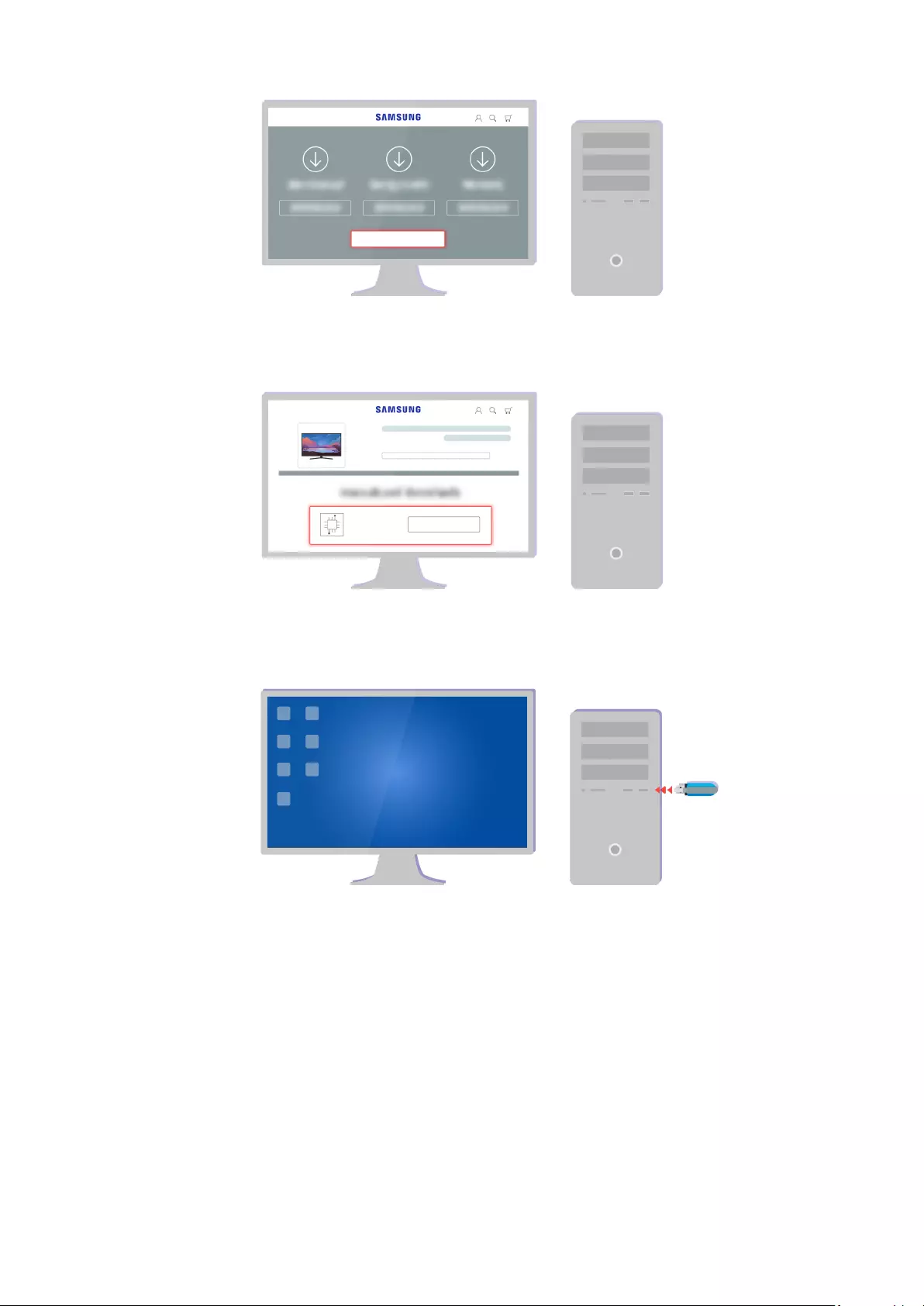
SEE ALL SUPPORT
Find your TV model and download the firmware file.
Firmware
Download
Click Download to download the firmware.
Unzip the downloaded file and store it in your USB drive top folder.
- 236 -
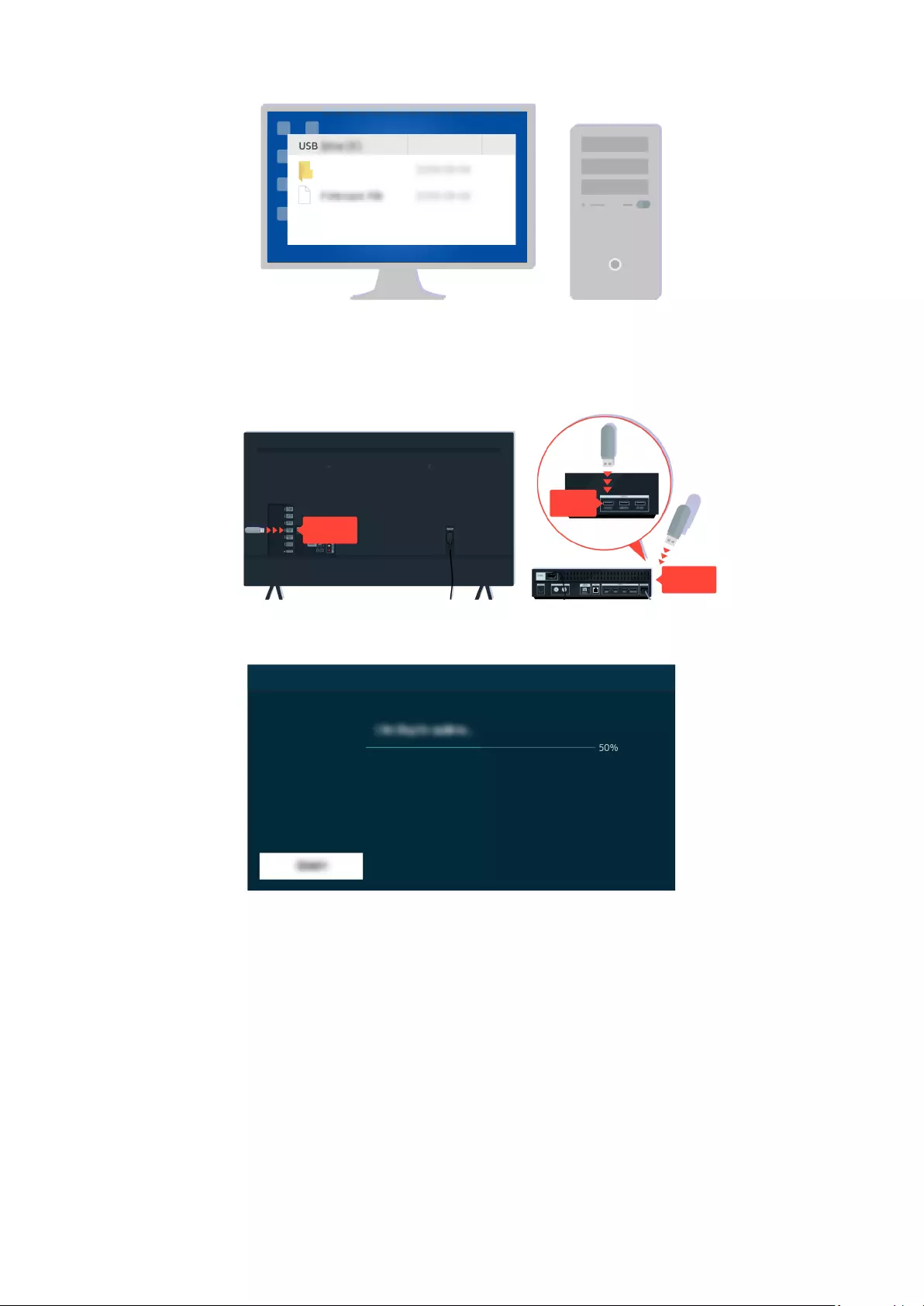
Unzip the downloaded file and store it in your USB drive top folder.
USB
USB
USB
Insert the USB device into the USB slot on the back of your TV or the side of the One Connect Box.
Update now
The firmware update begins automatically. Your TV will automatically reset when the firmware update is completed.
Do not turn off your TV while the firmware update is in progress.
- 237 -
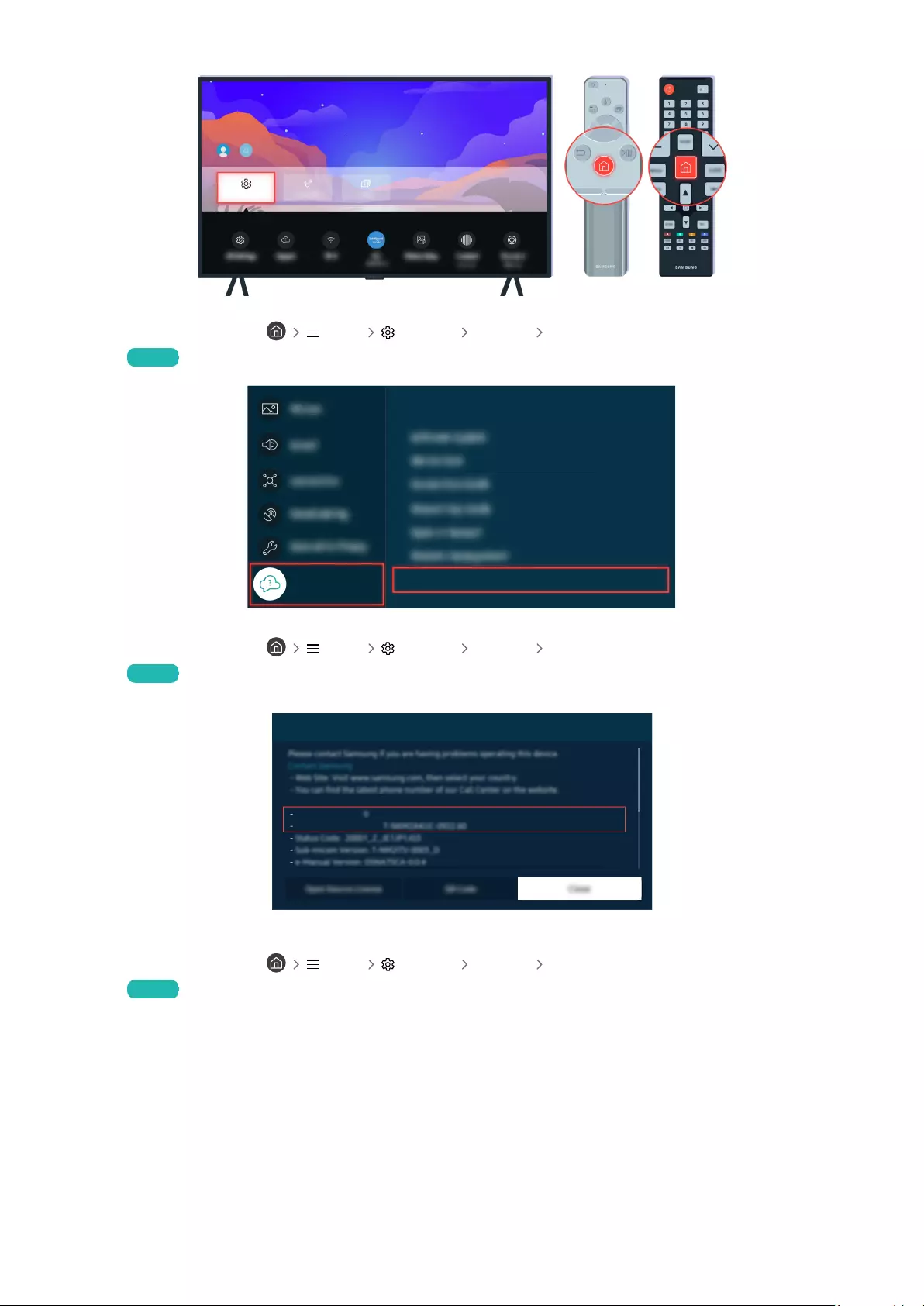
Settings
After your TV turns on, select Menu Settings Support About This TV and check the new firmware
version. Try Now
Support
Support
About This TV
After your TV turns on, select Menu Settings Support About This TV and check the new firmware
version. Try Now
About This TV
Product Information
Model code:
Software version:
After your TV turns on, select Menu Settings Support About This TV and check the new firmware
version. Try Now
- 238 -

Accessibility Guidance
Provides a menu and a remote control guide that aid the visually impaired.
Learn the Menu Screen
Learn the menus on the TV screen. Once enabled, your TV will tell you the structure and features of the menus you
select.
Using the Remote control
You can see the description of the buttons on the Samsung Smart Remote or Remote Control.
The Samsung Smart Remote may not be supported depending on the model or geographical area.
Orientation of the Samsung Smart Remote or Remote Control
Hold the remote control with the buttons facing towards you. The remote is slightly thinner towards the top and
thicker towards the bottom.
Description of the Samsung Smart Remote or Remote Control
The images, buttons, and functions of the remote control may differ with the model or geographical area.
From top to bottom and left to right:
• The button is at the top left.
• There is a small LED (microphone) to the right of the button, but it cannot be felt by hand.
• For the Samsung Smart Remote, there is a round button below the LED, which is the button.
• Of the 2 buttons below the button on the Samsung Smart Remote that comes with the QLED TV, The Frame
(43-inch or larger models), The Serif or OLED TV, the left one is the button and the right one is the button.
• Of the 2 buttons below the button on the Samsung Smart Remote that comes with The Sero, the left one is
the button and the right one is the button.
• Of the 2 buttons below the button on the Samsung Smart Remote that comes with The Frame (32LS03B
model) or BU8 Series, the left one is the button and the right one is the button.
- 239 -

• If you press the button and then press the down directional button or press the button while viewing a
program, the Recordings, Schedule Manager, Timeshift, Stop (when Record or Timeshift is running), Info, red,
green, yellow and blue options appear.
Record and Timeshift may not be supported depending on the model or geographical area.
Select the Move to the top button to move the menu to the top.
This function may not be supported depending on the geographical area.
• Underneath these 2 buttons are a round button and a large outer circle button. The round button is the Select
button, and the large outer circle button consists of 4 directional buttons (up / down / left / right).
• Underneath the directional button are 3 buttons, one on the left, one on the right, and one in the center. The
one on the left is the button and the one on the right is the button. The round button in the middle is the
button.
• If you press the button while watching a TV program, the screen you are watching stops and a control bar
appears. You can select Rewind, Play, Pause, Fast Forward, Stop Timeshift, Record, Go to Live TV, or Info. You
can press the up directional button to go to the playback screen and check the time that the actual broadcast
program is running and the timeshift time.
You can use the Slow Rewind or Slow Forward functions when you select the Pause option.
To use Record or Timeshift, you must connect a USB device.
This function may not be supported depending on the model or geographical area.
• Underneath the button are 2 thin horizontal buttons. These buttons protrude higher above the surface than
the other buttons on the remote control. The one on the left is the volume button and the one on the right is the
channel button. Push up from beneath or down from above to use these as rocker buttons to change the channel
or volume.
– Briefly press the (Volume) button to mute the sound.
– Press and hold the (Volume) button to open the Accessibility Shortcuts menu.
– Briefly press the (Channel) button to open the Guide.
This function may not be supported depending on the model or geographical area.
- 240 -

Using the Accessibility Menu
View how to use the Accessibility functions and descriptions on their functions.
This function may not be supported depending on the model or geographical area.
Running the Accessibility Shortcuts menu
You can turn on or turn off the accessibility functions such as Voice Guide, Audio Description, Caption, Sign
Language Zoom, Sign Language Guide, Picture Off, High Contrast, Enlarge, Grayscale, Color Inversion, Slow Button
Repeat, and you can move to the Learn TV Remote, Learn Menu Screen, Multi-output Audio and Accessibility
Settings pages.
The menu name may differ depending on the model.
• Samsung Smart Remote / Remote Control
On the Samsung Smart Remote or Remote Control, there are 2 thin horizontal rocker buttons next to each other
located slightly below the middle of the remote. The one on the left is the volume button. Press and hold the
volume button to open the Accessibility Shortcuts menu.
Even if the Voice Guide is set to Off or muted, when you press and hold the volume button, the voice guide for
Accessibility Shortcuts is enabled.
Running the Accessibility menu functions using the General menu
Menu Settings All Settings General & Privacy Accessibility Try Now
You can also go to the Accessibility menu from the TV settings menu. This provides more options, for example, to
change the speed of Voice Guide.
The TV will not verbalize this menu unless Voice Guide is already turned on.
1.
Press the button.
2.
Press the left directional button to navigate to Menu, and then press the right directional button to navigate
to Settings.
3.
Press the Select button, and press All Settings to open the menu. Press Select to load the TV’s Set menu.
4.
Press the down directional button to reach General & Privacy, and then press the Select button to open this
menu.
- 241 -

5.
Place the focus on Accessibility, and press the Select button to open the menu.
6.
The menu will appear with Voice Guide Settings as the selection. Highlight Voice Guide Settings, and then
press the Select button.
7.
A menu appears with the options to change Voice Guide, Volume, Speed, Pitch, and TV Background Volume.
8.
Select the menu using the directional buttons, and then press the Select button.
The menus are activated when Voice Guide is on.
Running the Accessibility menu functions using Bixby
This function is available only if Voice Assistant is set to Bixby. ( Menu Settings All Settings General &
Privacy Voice Voice Assistant) Try Now
Bixby may not be supported depending on the model or geographical area.
To use Bixby, the TV must be set up and tuned and must be connected to the network. You can connect the TV to the
network during the initial setup or do it later through the settings menu.
There are many commands you can say to control the TV. These can be used together with Voice Guide to give you
voice input and voice output. You can use the Samsung Smart Remote but the TV must be connected to the network.
To speak a command, press and hold the button (located near the top of the Samsung Smart Remote, directly
below the small LED (microphone) and above the directional button) and say the command, and then release the
button. The TV will the command.
For example you can:
• Turn Voice Guide on
Press the button on the Samsung Smart Remote, and then say "Voice Guide on."
• Turn Audio (Video) Description on
Press the button on the Samsung Smart Remote, and then say "Video Description on" or "Audio Description
on."
• Turn High Contrast on
Press the button on the Samsung Smart Remote, and then say "High Contrast on."
- 242 -

Learning about the Accessibility menu functions
•Voice Guide Settings
Provides voice guides to make it easier for the visually impaired to use the TV. Voice guide supports basic
operations such as changing channels and adjusting the volume, provides voice descriptions about the current
broadcast and the following broadcast, and offers guidance on setting up Scheduled Viewing events. The feature
also provides voice descriptions on Internet, Search, and other smart services.
Move to Voice Guide and press the Select button to enable/disable the feature.
•Audio Description
This feature provides commentary about what's happening in the scene as assistance for the visually impaired.
However, the feature must be supported by the broadcast you are watching.
•Caption Settings
You can view the caption in programs that provide broadcast captions.
When watching a channel on an external device such as a set-top box and cable box, turn on the caption function on the
device. For more information, contact your service provider.
–Separate Closed Caption
You can see the caption separated from the broadcast image. The captions from the broadcaster are
classified into *open caption and *closed caption. Two types of captions can overlap when both are used.
This feature is enabled when Digital Closed Caption is supported.
*open caption: Included in content. You cannot turn on or off its display.
*closed caption: You can turn on or off its display.
At this time, you can use this function to separate the caption from the broadcast image, which allows you
to see the closed caption without interruption.
• On: Displays the screen with a separate caption area.
Video area
Caption area
Turn down the volume
- 243 -

• Off: Displays the caption on the screen.
Turn down the volume
–Caption Mode
You can select a desired caption mode from the list.
–Digital Caption Options
You can set the caption display details.
The Position function is available only in the programs that provide captions. Your TV supports the caption from
the broadcaster. Using this function, the caption can be positioned on a desired location. It can be used by the
hearing impaired for convenience.
•Sign Language Zoom Settings
You can zoom in the sign language screen when the program you are watching provides it. Set Sign Language
Zoom to On and then adjust the window’s position and aspect ratio under Edit Sign Language Zoom.
This function may not be supported depending on the model or geographical area.
•Sign Language Guide Settings
Provides a description of menu items with sign language.
- 244 -

•Learn TV Remote
Learn the names and functions of the buttons on remote control. On this screen, pressing the power button (top
left button) will turn off the TV, but when any other button is pressed the TV will say the button name and briefly
tell what that button does. This teaching mode helps you to learn the location and operation of the buttons on
the remote without affecting normal TV operation. Press the button twice to exit Learn TV Remote.
•Learn Menu Screen
Learn the menus on the TV screen. Once enabled, your TV will tell you the structure and features of the menus
you select.
•Picture Off
Turn off the TV screen and provide only sound to reduce overall power consumption. When you press a button on
the remote control other than Volume and Power while the screen is off, the TV screen turns back on.
•Graphic Zoom
Enlarge the screen to make the picture or text bigger. You can adjust the zoom level or move the zoom area.
This function may not be supported depending on the model or geographical area.
•Multi-output Audio
You can turn on both the TV speaker and Bluetooth headphone designed for the hearing impaired at the same
time. The hearing impaired can then set the volume of their Bluetooth headphone higher than the volume of
the TV speaker without affecting the volume of the TV speaker, allowing both the hearing impaired and their
families to listen to the TV at comfortable sound levels.
This function may not be supported depending on the model or geographical area.
•High Contrast
To display all menus with an opaque black background and a white font, providing maximum contrast.
If High Contrast is on, some Accessibility menus are not available.
- 245 -

•Enlarge
You can enlarge important elements on the menu such as the names of programs.
•Grayscale
You can change the color of the TV screen to black and white to sharpen blurred edges caused by colors.
If Grayscale is on, some Accessibility menus are not available.
This function may not be supported depending on the model or geographical area.
•Color Inversion
You can invert the colors of the text and background displayed on the TV screen to make it easier to read the
text.
If Color Inversion is on, some Accessibility menus are not available.
This function may not be supported depending on the model or geographical area.
•Remote Button Repeat Settings
You can configure the operation speed of the remote control buttons so that they slow down when you
continually press and hold them.
- 246 -

Using the TV with Voice Guide on
Turn on Voice Guide that describes the menu options aloud to aid the visually impaired.
Changing channel
There are 3 ways to change the channel. Every time you change channels, the new channel details will be
announced. The ways to change the channel are below.
•Channel List
Press and hold the (Channel) button to open the Channel List. Use the up or down directional button to
move to a channel and press the Select button.
• (Channel) button
Of the 2 buttons that protrude from the center of the Samsung Smart Remote or Remote Control, the right one is
the (Channel) button. Push up or pull down the (Channel) button to change the channel.
• Number button
Use the or button on the Samsung Smart Remote or Remote Control to open the virtual numeric pad,
enter a number, and then select Enter Number.
Using on-screen number entry via the Samsung Smart Remote or Remote Control
Use the virtual numeric pad to enter numbers (e.g., to enter a channel number or to enter a PIN).
Press the or button on the Samsung Smart Remote or Remote Control and the virtual numeric pad with 2
rows appears on screen. Voice Guide speaks “virtual numeric pad, 6” which indicates that the number strip is on
screen and the focus is on the number 6. This strip has the following buttons:
• In the top row, a list of Most Watched Channel is shown.
• Press the or button: On the bottom row: From the far left: 1, 2, 3, 4, 5, 6, 7, 8, 9, 0, -, Delete
The options that you can select in the virtual numeric pad may vary depending on the viewing mode.
- 247 -

Use the left and right directional buttons to move along the row, and then press the Select button to choose the
numeric pad. When you have selecting all the numbers you need (for example, 123), press the directional
button to move to the Enter Number option, and then press the Select button to
When entering a channel number, you can enter the number, and then select the Enter Number option on the top
row or you can enter the channel number and wait. After a short while, the channel will change and the virtual
numeric pad will disappear from the screen.
Changing volume
Use the (Volume) button on the left to change the volume. Every time you change the volume, the new volume
level will be announced.
• Samsung Smart Remote / Remote Control
Of the 2 buttons that protrude from the center of the Samsung Smart Remote or Remote Control, the left one is
the (Volume) button. Push up or pull down the (Volume) button to change the volume.
Using program information
When watching TV, press the Select button to view program information which then appears at the top of the
screen. Voice Guide will say program subtitles or audio descriptions if they are available. To view more detailed
program information, press and hold the Select button. Voice Guide will say more details such as a synopsis of the
program.
Press the left or right directional button to see what you can watch next on the same channel. Press the up or down
directional button to move to other channels and see which programs are currently being broadcast on them.
Press to go back or close the program details.
This function may not be supported depending on the geographical area.
- 248 -

Using the guide
See an overview of each channel's program lineup.
When you want to know the program information for each channel while watching a broadcast program, press the
(Channel) button on the Samsung Smart Remote or Remote Control. Use the directional buttons to view the
program information.
You can see the daily program schedules for each channel and program information in the Guide. You can select
programs to schedule for viewing or recording.
You can also open the Guide using Bixby. Press and hold the button on your Samsung Smart Remote, and then
say “Guide.”
This function may not be supported depending on the model or geographical area.
The information in the Guide is for digital channels only. Analog channels are not supported.
If the Clock is not set, the Guide is not provided. Set the Clock ( Menu Settings All Settings General
& Privacy System Manager Time Clock) Try Now
If you need to set the clock again, follow the steps below.
1.
Press the button and press the left directional button on the remote control.
2.
Press the down directional button to move to Menu.
3.
Press the right directional button to move to Settings.
4.
Use the down directional button to move to All Settings.
5.
Press the Select button to open the TV's All Settings menu.
6.
Use the up and down directional buttons to move to the General & Privacy menu, and then press the Select
button.
7.
Use the up and down directional buttons to move to the System Manager menu, and then press the Select
button.
8.
Select the Time menu, and then press the Select button.
9.
Select the Clock menu, and then press the Select button.
10.
Select the Clock Mode menu, press the Select button, and then select Auto or Manual.
If you select Manual, you can move to the Date or Time menu below to set the time or date.
- 249 -

When you open the Guide, a table grid of channels and programs is displayed. In the top rows, the selected
type and the time are shown. Each row has a channel name on the left and programs on that channel on the right.
In the Guide, use the up and down directional buttons to move between channels and use the left and right
directional buttons to move between programs at different times within a channel.
You can also use the or button to enter a channel number and go to that channel directly. You can use the
button to move to the program currently broadcasting.
When you move the focus to a program, you will hear detailed information about the selected program. When you
move the focus to a different channel, you will hear the channel name and number, and the program details. If you
move to a different day, you will hear the day announced for the program you reach on that day. The day is not
repeated, so if you are not sure what the day is, you can move forwards and backwards 24 hours and then the day
will be announced.
To view a program on now
In the Guide, move to the program currently broadcasting, and then press the Select button to go to live TV on the
selected channel and program.
Other options in the guide
In the Guide, move to a broadcast scheduled program, and then press the Select button. A pop-up menu listing the
functions below appears.
Use the up and down directional buttons to move within this menu, and then press the Select button to choose an
item. Press to close the menu and go back to the Guide.
For the program you are currently watching, press the Select button.
•Record
You can record the program that you are currently watching or a program on another channel.
This function is not available in the U.S.A. and Canada.
This function may not be supported depending on the model or geographical area.
•Stop
You can stop the recording function that is currently running.
This function is not available in the U.S.A. and Canada.
This function may not be supported depending on the model or geographical area.
- 250 -

•Edit Recording Time
You can change the start and end times of scheduled program recordings.
This function is not available in the U.S.A. and Canada.
This function may not be supported depending on the model or geographical area.
•Schedule Viewing
You can schedule the viewing of a broadcast scheduled program.
•Schedule Recording
You can schedule recording of a broadcast scheduled program.
This function is not available in the U.S.A. and Canada.
This function may not be supported depending on the model or geographical area.
For more information, refer to "Recording."
•Cancel Scheduled Viewing
You can cancel your scheduled viewings.
•Cancel Scheduled Recording
You can cancel your scheduled recordings.
This function is not available in the U.S.A. and Canada.
This function may not be supported depending on the model or geographical area.
•View Details
You can see the detailed information on the selected program. The information may differ with the broadcast
signal. If the information is not provided with the program, nothing appears.
Press the Select button on the View Details option. This will open the details pop-up window for that program
which will display a synopsis. The details pop-up window contains detailed information and the OK option. After
reading the detailed information, press the Select button on the remote control to close the pop-up window.
- 251 -

Using Schedule Viewing
the TV to show a channel or program at a time and date.
The icon appears next to programs that have been for a schedule viewing.
To set up a schedule viewing, you must set the TV's clock ( Menu Settings All Settings General &
Privacy System Manager Time Clock). Try Now
Setting up a schedule viewing
You can set up a schedule viewing on two screens.
•The Guide Screen
On the Guide screen, select a program you would like to view, and then press the Select button. Select Schedule
Viewing on the pop-up menu that appears.
•The Program Info Screen
Press the Select button while watching the TV. The Program Info window appears. Select a broadcast scheduled
program by using the left or right directional buttons, and then press the Select button. You can schedule a
reminder to watch the program by selecting Schedule Viewing.
Cancelling a scheduled viewing
You have 2 ways to cancel a scheduled viewing.
• Cancelling a scheduled viewing from the Guide
1.
Press the (channel) button to access the Guide.
2.
Move to to the program to cancel the viewing schedule, and press the Select button.
3.
Move to Cancel Scheduled Viewing, and then press the Select button.
4.
When a pop-up message asking you to cancel the selected scheduled viewing appears, select Yes. The
scheduled viewing is canceled and the Guide screen appears.
• Cancelling a scheduled viewing from Schedule Manager or Recordings
1.
On the remote control, press the or button.
2.
Use the directional buttons to move to the control pad.
3.
Press the Select button to open Schedule Manager or Recordings.
If the TV supports the Recordings function, press the directional buttons to move to Schedules.
4.
Press the up directional button to move to the Schedules option.
5.
Use the down directional button to move to the list of programs scheduled to view.
6.
Use the right directional button to move to the Delete option, and then press the Select button to delete the
selected item.
This function may not be supported depending on the model or geographical area.
- 252 -

Using the Channel List
See how to list the channels available on your TV.
Using Channel List, you can change the channel or check programs on other digital channels while watching TV.
Press and hold the (Channel) button to open the Channel List.
The focus is on the channel you are currently watching, and the name and number of the channel, along with the program
title, are displayed.
Use the up and down directional buttons to move within the channel list (or use the (Channel) button to go up
and down a page at a time). You can also use the or button to enter a channel number and go to that channel
directly.
Press the left directional button in the Channel List to move to the Category List. Use the up and down directional
buttons to move within this list. Press the Select button to choose a category you want from the Category List. The
Category List contains All Channels, Favorites, Samsung TV Plus, and Air or Cable. Use the up and down directional
buttons to move to a channel you want to view, and then press the Select button.
•All Channels
Displays the channels that have been automatically searched.
These are the channels your TV will receive either over the air if your TV is set to Air or over cable if your TV is set to
Cable. See Air or Cable below.
•Favorites
Displays Favorites 1 to Favorites 5. Use the up and down directional buttons to move between the lists of
favorites. Highlight the one you want, and then press the Select button. The channel list will now show only the
channels in this list.
•Air or Cable
To select Air or Cable, move the focus to Air or Cable, and then press the Select button. Air is suitable for
homes equipped with separate, over-the-air antennas. Cable is suitable for homes that subscribe to a local
cable-service, but do not have a cable box. You do not need to use this function if your TV is connected to a cable
box or satellite box.
This function may not be supported depending on the incoming broadcast signal.
•Samsung TV Plus
While the TV is connected to the network, you can watch popular programs or highlights for each theme
through a virtual channel at any time. As with regular channels, the TV provides the daily program schedules for
Samsung TV Plus.
This function may not be supported depending on the model or geographical area.
- 253 -

Recording
Recording a program to an external hard drive connected via USB.
This function is not available in the U.S.A. and Canada.
This function may not be supported depending on the model or geographical area.
Read all precautions before using the recording feature. For more information, refer to "Before Using the Recording and
Timeshift Functions."
Using the instant and schedule recording options from the guide screen:
To record a program that is on now, open the Guide by pressing the (channel) button, move to the program,
and then press the Select button. You will get a pop-up menu. Use the up and down directional buttons to move
to Record. Press the Select button to record the program. You will be returned to the program guide. Recording
automatically ends at the time when the program ends.
To stop recording, press the down directional button while the program being recorded is displayed. The control
bar appears. Move the focus to Stop Recording, and then press the Select button. When a pop-up window appears,
select Stop.
To record a program that is on later, move to the program in the Guide, and then press the Select button. You
will get a pop-up menu. Use the up and down directional button to move within this menu. Move to the Schedule
Recording, and then press the Select button. You will hear a message saying the program has been set to record
and then you will be returned to the program guide.
The icon is placed visually next to the program title to show it is set to record. To out if a program is set
to record or to cancel a scheduled recording, press the Select button on the program. If it is already set to record,
then the option on the menu will be Cancel Scheduled Recording. You can press the Select button to cancel the
scheduled recording or just press the button to go back to the program guide without cancelling the recording.
- 254 -

Recording the program you are watching
To display a menu for recording a program or starting the Timeshift function, press the button twice or press the
button while watching the program. You can select the following functions on the menu:
•Record
Immediately starts to record the program you are watching.
•Timeshift
Starts the Timeshift function.
•Stop
Stops the recording or the Timeshift function that is running.
•Info
Displays the details about the program you ware watching.
Scheduling recording from the program info window
Press the Select button while viewing a program to display the program info window. In the program info window,
use the left and right directional buttons to select a broadcast scheduled program, and then press the Select
button. To schedule a recording for the program, select Schedule Recording.
Changing the recording time
When recording a live program you can specify how long you want to record for.
Press the down directional button to display the control bar at the bottom. Press the left or right directional buttons
to move to Edit Recording Time, and then press the Select button. A slider scale appears and you will hear the
recording time currently set. Use the left and right directional buttons to change the time, and then press the Select
button. You will hear a menu that gives information about the recording time. To return to the program you are
watching, press the button on the remote.
The maximum recording time differs depending on the capacity of the USB device.
- 255 -

Viewing recorded programs
1.
On the remote control, press the or button.
2.
Use the directional buttons to move to the control pad.
3.
Select either Schedule Manager or Recordings to access the Recording & Schedule Manager screen.
To play a program, use the up and down directional buttons to move between program titles. Press the Select
button to play the program or press the right directional button to move to a list of options. Use the up and down
directional buttons to move between the options in this list. You can play, remove, delete the program, or view the
program details.
Select the Play option to play the program. The program will start. If you have watched part of this program before,
you will get a pop-up menu on screen allowing you to Play (from start), Resume (from where you left off), or Cancel.
Use the left and right directional buttons to move to the required option, and then press the Select button.
This function may not be supported depending on the model or geographical area.
Deleting a recorded program
You can delete any recorded program.
1.
Go to the list of Recordings to delete a recorded program.
2.
Use the up and down directional buttons to move to the recording you want to delete.
3.
Press the right directional button to move to a list of 3 options.
4.
Press the down directional button to move to the Delete option, and then press the Select button.
You will be asked if you want to remove the selected item.
5.
Press the left directional button to move to the Delete button, and then press the Select button to delete the
program title.
The program will be deleted and you will be returned to the list of Recordings.
- 256 -

Using Smart Hub
Learn how to use Smart Hub to access apps, games, movies, and more.
Smart Hub
Use a variety of Smart Hub content offered by your Samsung TV.
Some Smart Hub services are for pay services.
To use Smart Hub, the TV must be connected to the network.
Some Smart Hub features may not be supported depending on the service provider, language, or geographical area.
Smart Hub service outages can be caused by disruptions in your Internet service.
Press the button. You are redirected to the Home Screen of the content you are currently using. Press the left
directional button, and try moving the focus to other items.
Use a variety of Smart Hub content, as follows: Privacy Choices, Search, Ambient Mode, Art, Media, Menu.
Supported Smart Hub content may vary depending on the model and geographical area.
Using the Smart Hub Home Screen
On the leftmost part of the Smart Hub Home Screen is the static menu listed. You can quickly and easily use the
listed menu items to access the main TV settings or external devices, search, and apps.
• Privacy Choices
From your TV, easily manage the privacy policy regarding services related to Smart Hub and verify how personal
information is protected.
To use Smart Hub, you must agree to the Smart Hub service agreement and the collection and use of personal
information. Without giving consent, you cannot use the additional features and services. You can view the entire text
of the Terms & Privacy by navigating to Menu Settings All Settings General & Privacy Terms &
Privacy. Try Now
If you want to stop using Smart Hub, you can cancel the agreement. To cancel the Smart Hub service agreement,
select Reset Smart Hub ( Menu Settings Support Device Care Self Diagnosis Reset Smart Hub).
Try Now
• Search
Search for channels, programs, movies, and apps offered by Smart Hub.
To use the Search service, make sure the TV is connected to a network.
This function may not be supported depending on the model or geographical area.
- 257 -

• Ambient Mode
Set your TV to display content you desire, such as the time or weather, when the TV is not used.
To return to TV mode from Ambient Mode, press the left directional button Media. Press the
button to turn off the TV.
This function may not be supported depending on the model or geographical area.
For more information about Ambient Mode, refer to "Using Ambient Mode."
• Art
When you are not watching TV or when the TV is turned off, you can use the Art mode function to edit image
content, such as artworks, photos, or to display the content.
This function is supported only in The Frame.
For more information, refer to "Using Art Mode."
• Media
View a variety of TV programs. Install various apps offered by Smart Hub, such as video, music, sports and game
apps, and use the apps from the TV.
For more information about Media, refer to "About the Media Home Screen."
• Menu
Manage external devices connected to the TV, and configure settings for various functions available on the TV.
For more information about Menu, refer to "About the Menu Home Screen."
- 258 -

Launching the e-Manual
Open the user manual embedded in your TV.
Menu Settings Support Open e-Manual
You can view the embedded e-Manual containing information about your TV's key features.
Alternatively, you can download a copy of the e-Manual from Samsung's website (https://www.samsung.com).
Words in blue (e.g., Internet) indicate a menu item.
The e-Manual's Home Screen contains 1 row of menu icons. Use the left and right directional buttons to move within
a row. Press the Select button to open the section you want to read.
You can use the directional buttons on the remote control to use the functions on the top such as Search, Sitemap, and
Index.
The e-Manual contains a section called "Learn TV Remote" in "Accessibility Guidance". This is particularly useful for
people who cannot easily see the buttons on the control or who are not clear what each button does. When you are
viewing this section of the e-Manual, pressing the buttons on the remote control will not affect the TV.
- 259 -

Using Bixby
Set Voice Assistant to Bixby. A guide to using Bixby to control your TV.
To use Bixby, your TV must be connected to the network and you must use the microphone on your Samsung Smart
Remote.
To use Bixby, press and hold the button on the Samsung Smart Remote, say a command into the microphone on
the remote, and then release the button to run Bixby.
This function may not be supported depending on the model or geographical area.
The existing functional may be changed if Bixby is updated.
This function is available only if Voice Assistant is set to Bixby. ( Menu Settings All Settings General &
Privacy Voice Voice Assistant) Try Now
The supported language may differ depending on the geographical area.
Running Bixby
Press and hold the button on the Samsung Smart Remote. Bixby is activated in the listening mode, the Bixby
icon appears at the bottom of the TV screen. Say a command, and then release the button. The TV provides feedback
on how it understands the command, and then performs the commanded task.
If the TV does not understand the command, try again with more precise pronunciation.
This function may not be supported depending on the model or geographical area.
You can a detailed description of the voice commands at Explore Bixby. Press the button. The Explore Now button
appears at the bottom of the screen. Press the Select button to go to the Explore Bixby screen.
- 260 -
